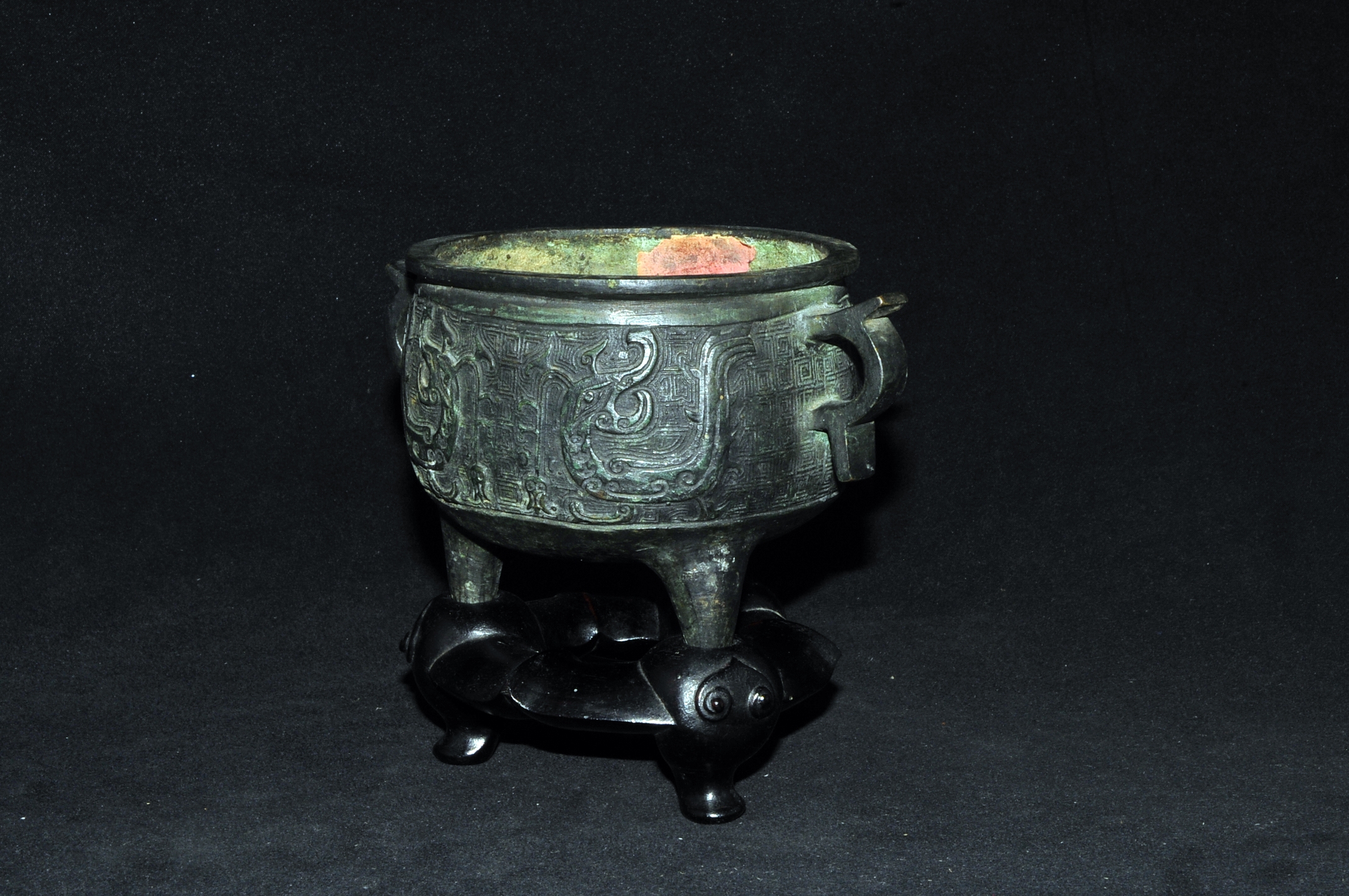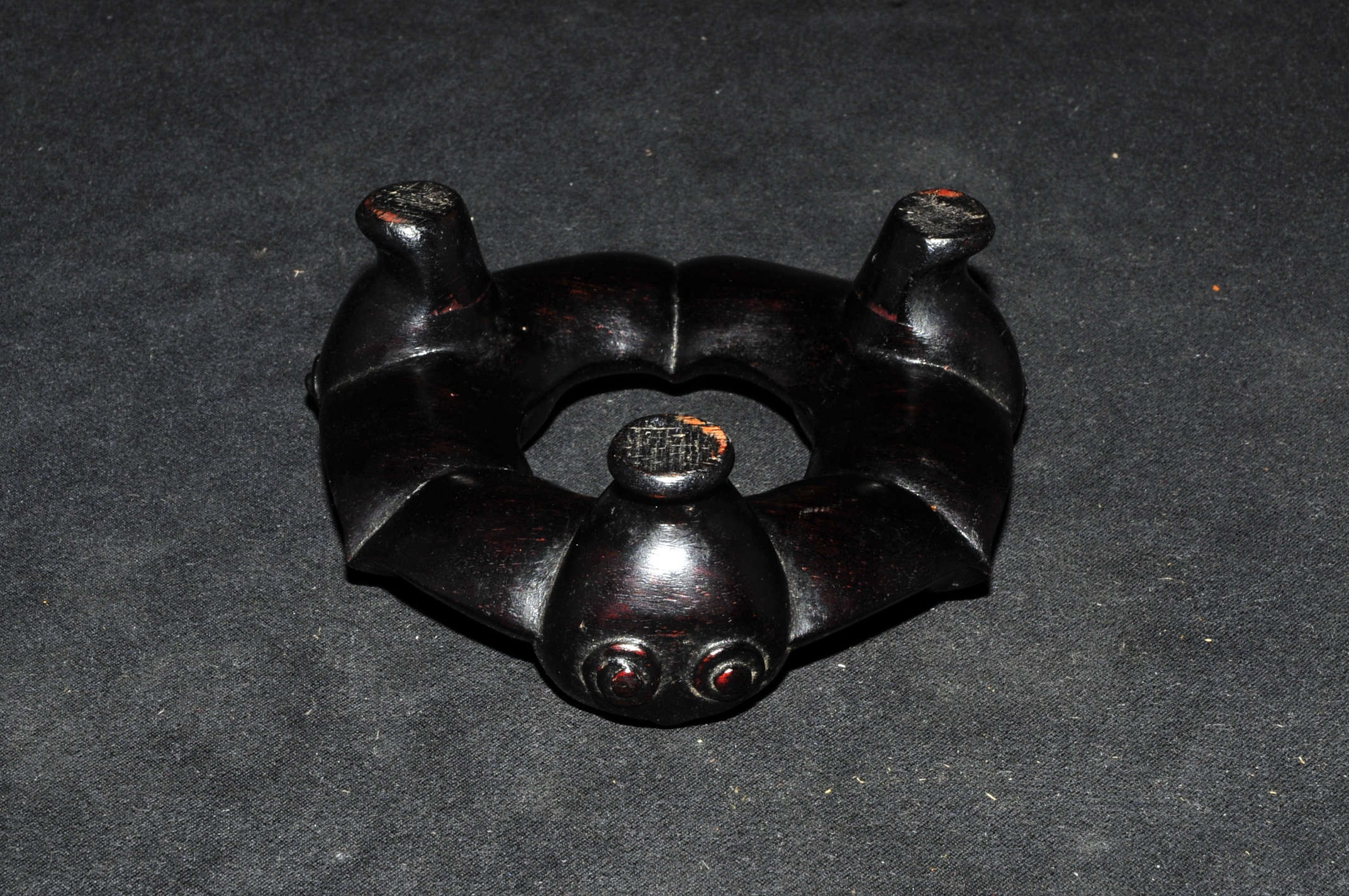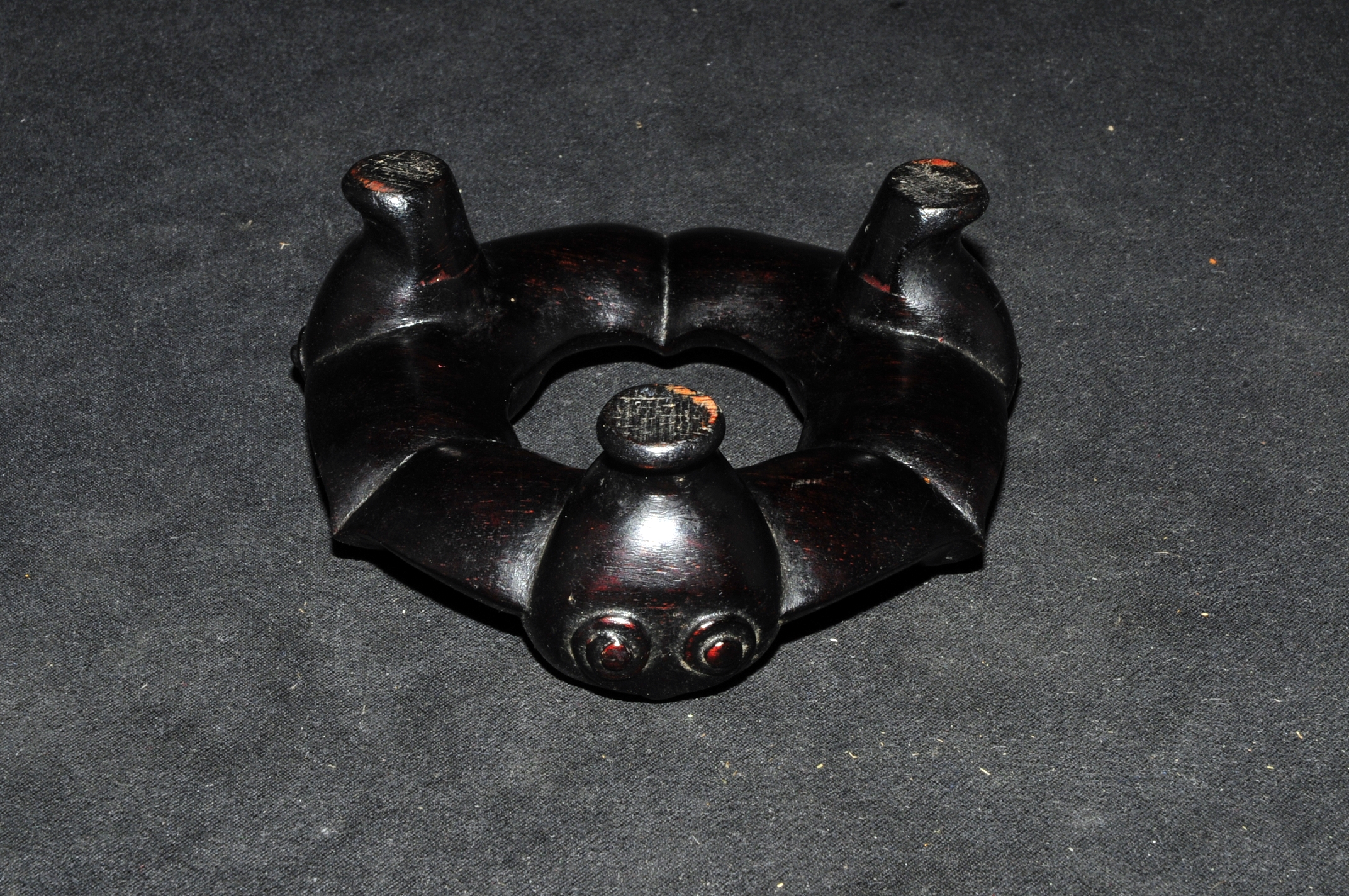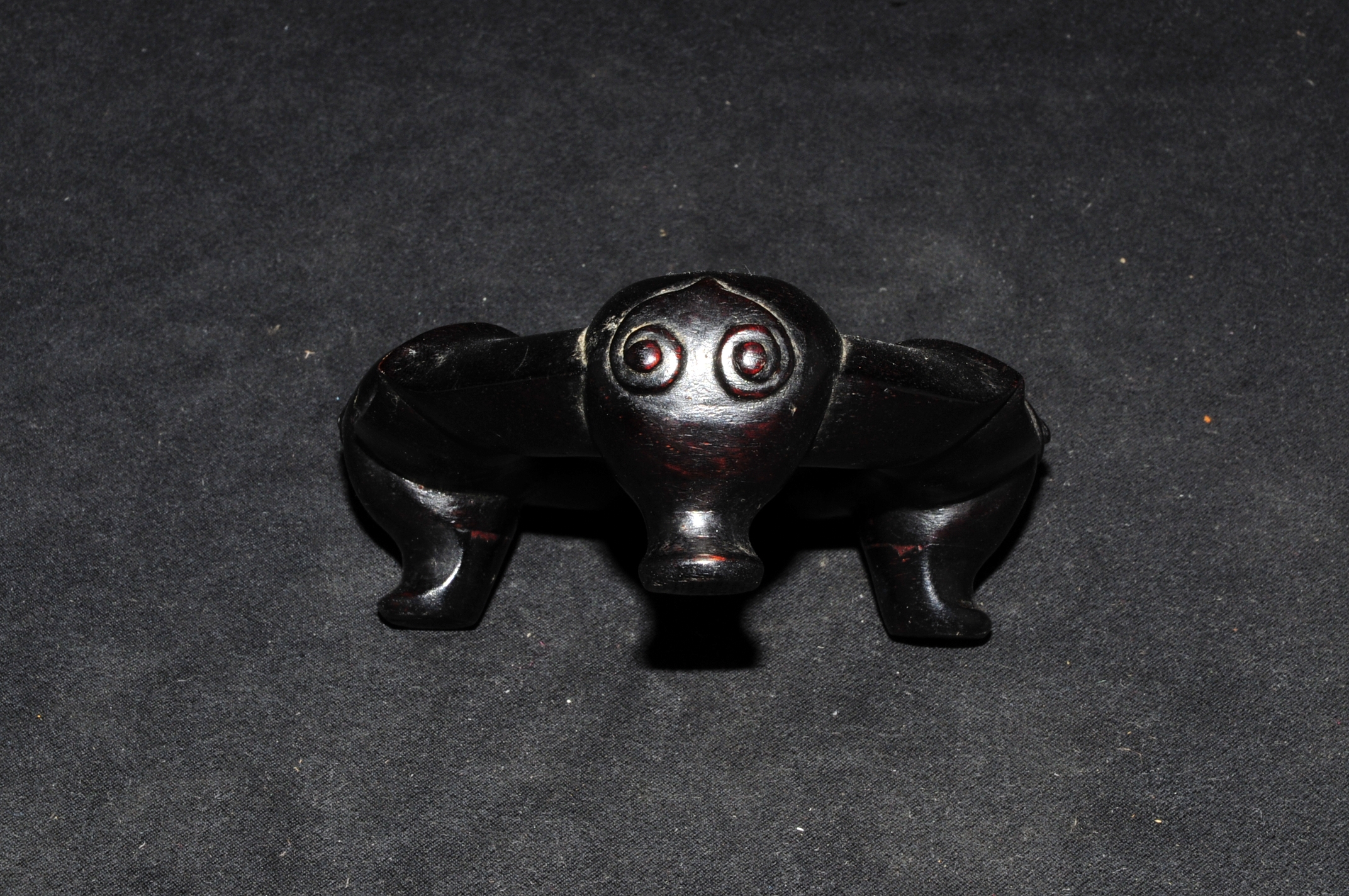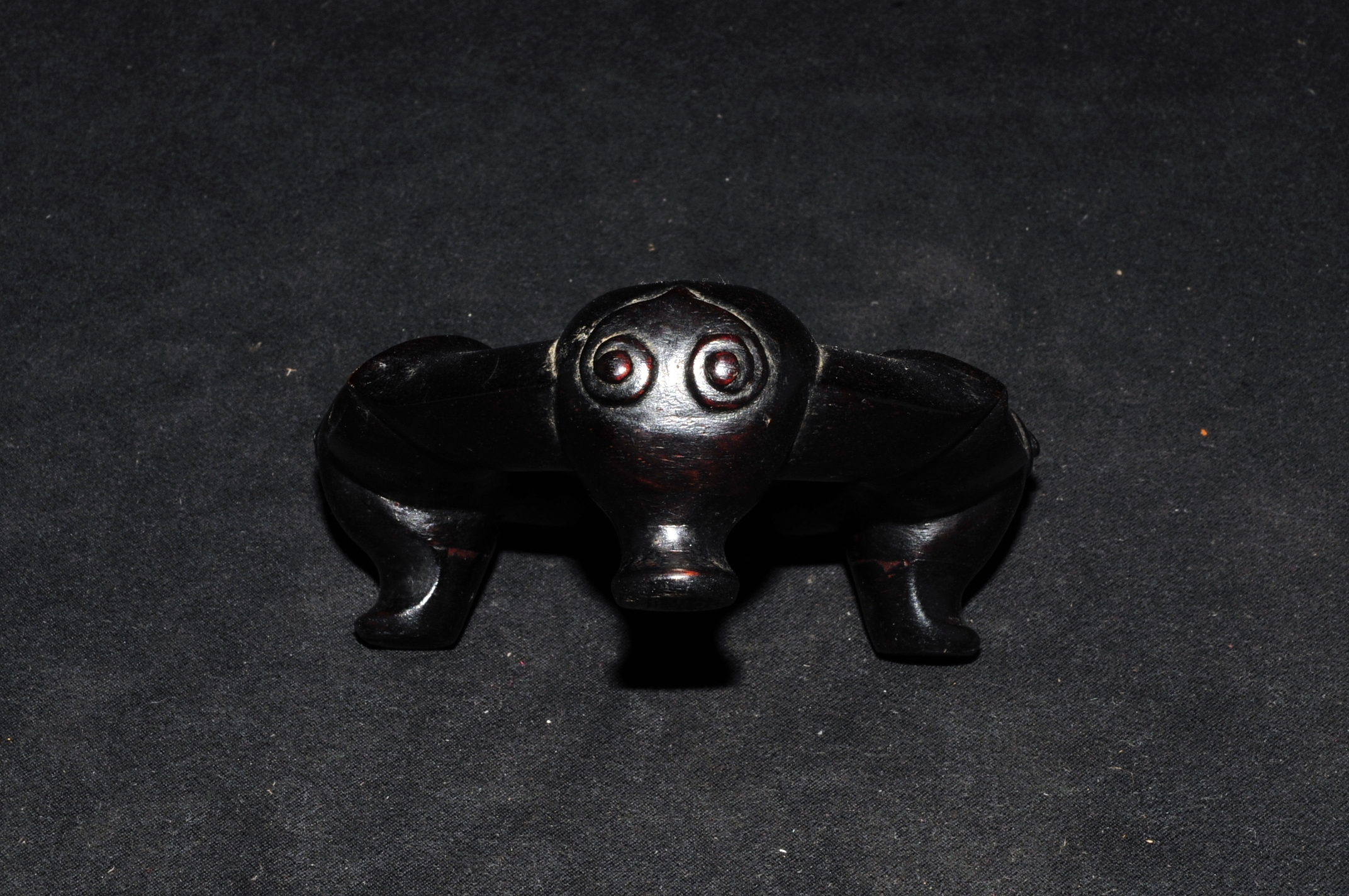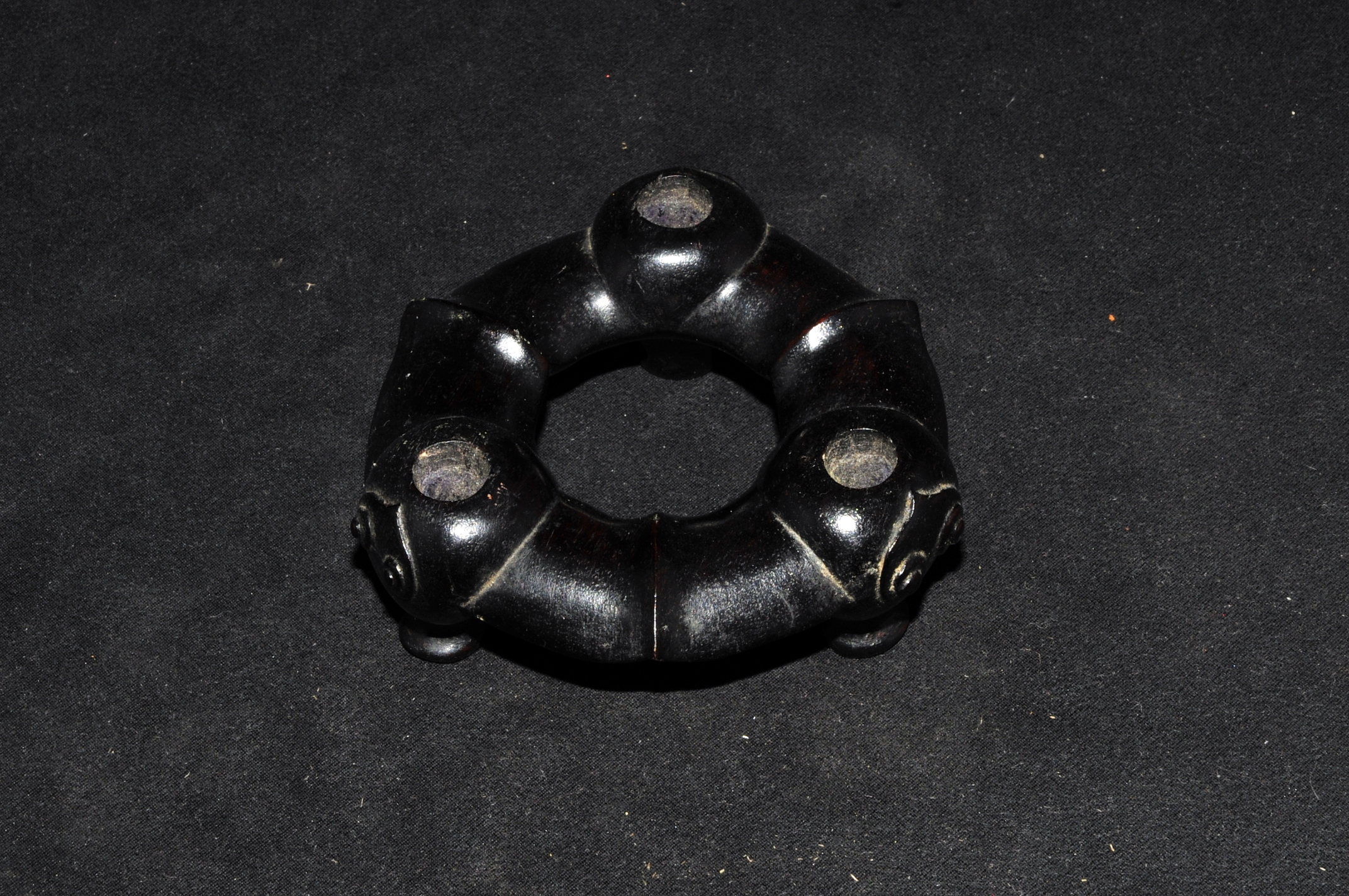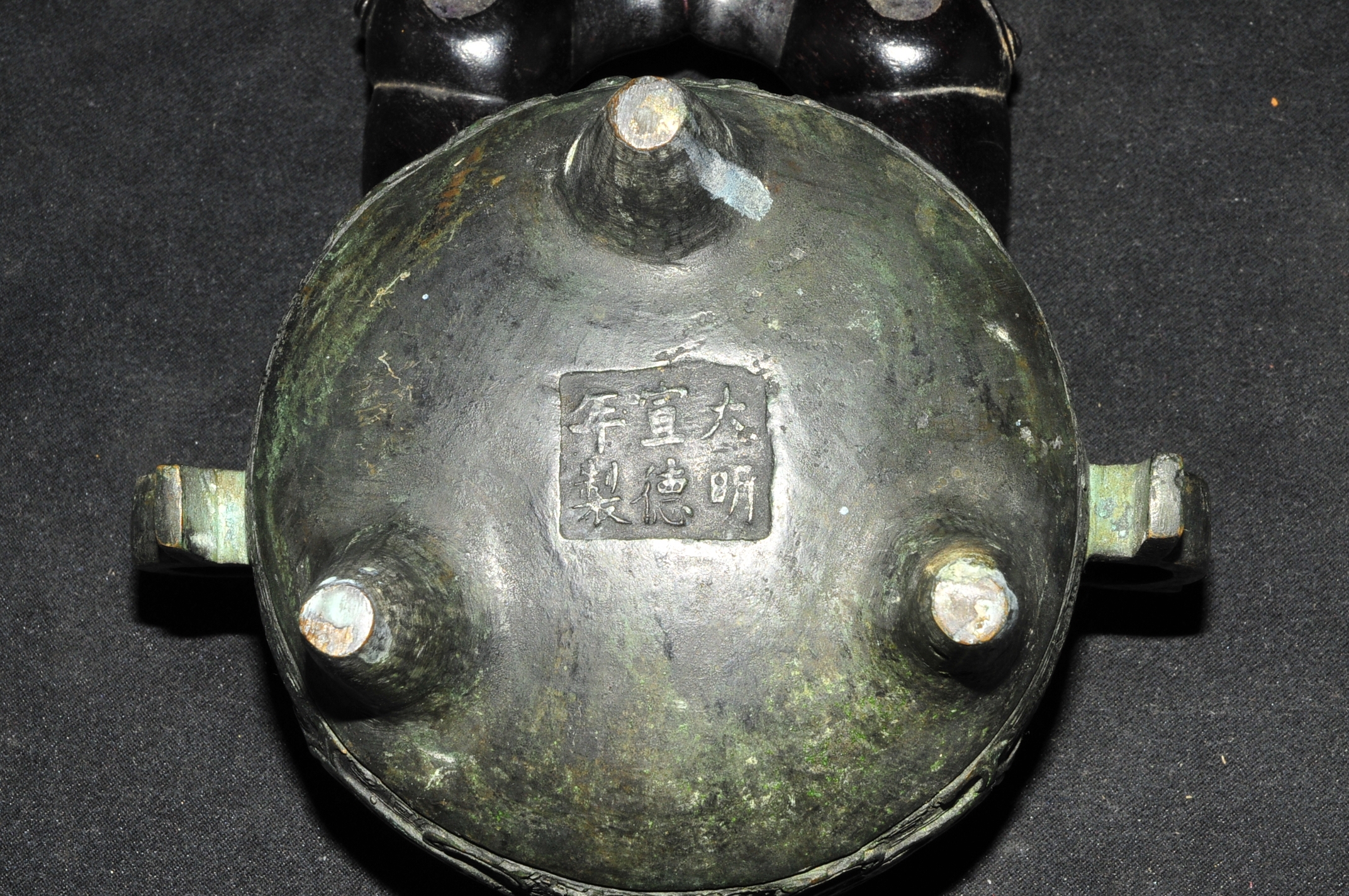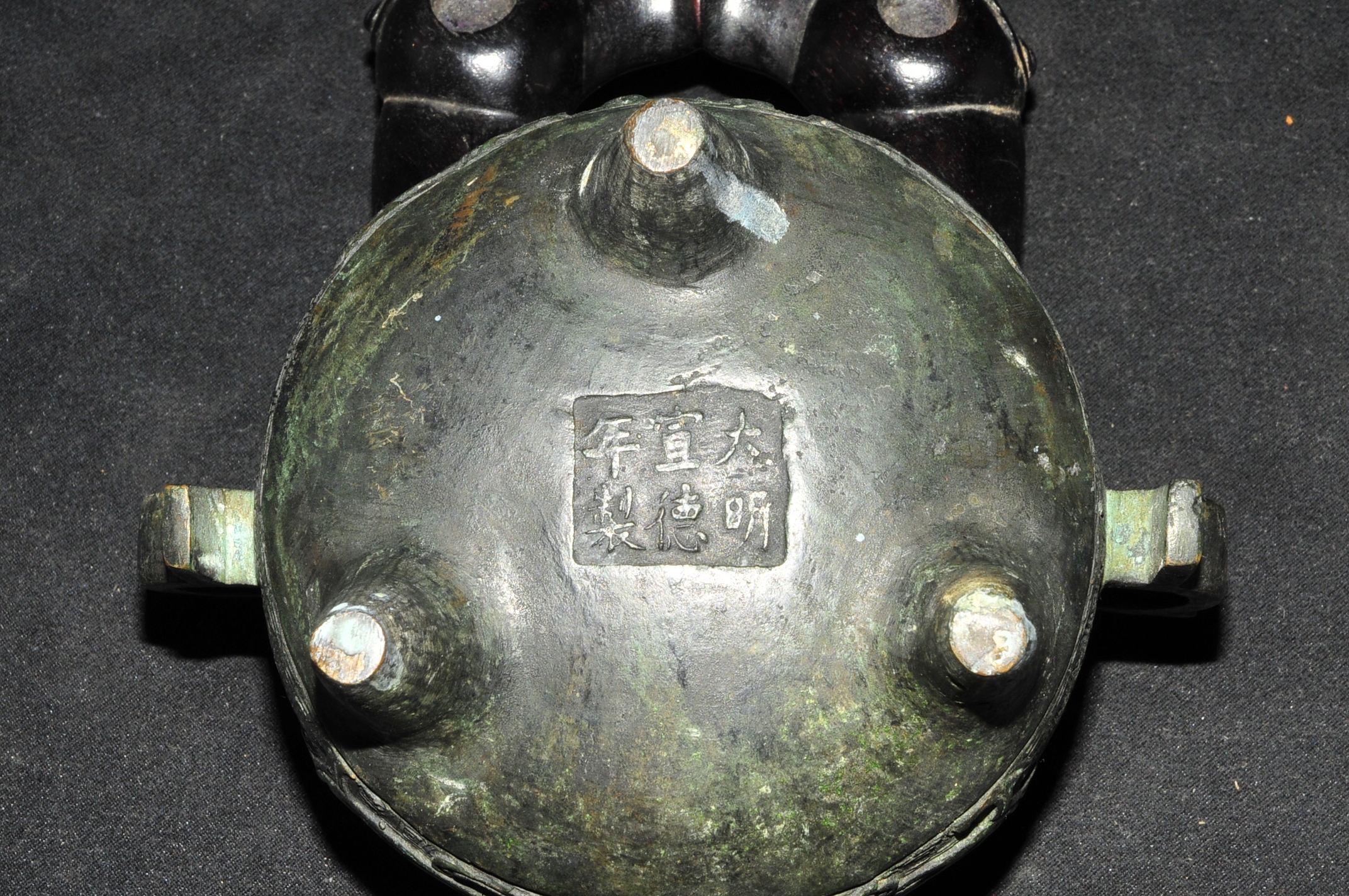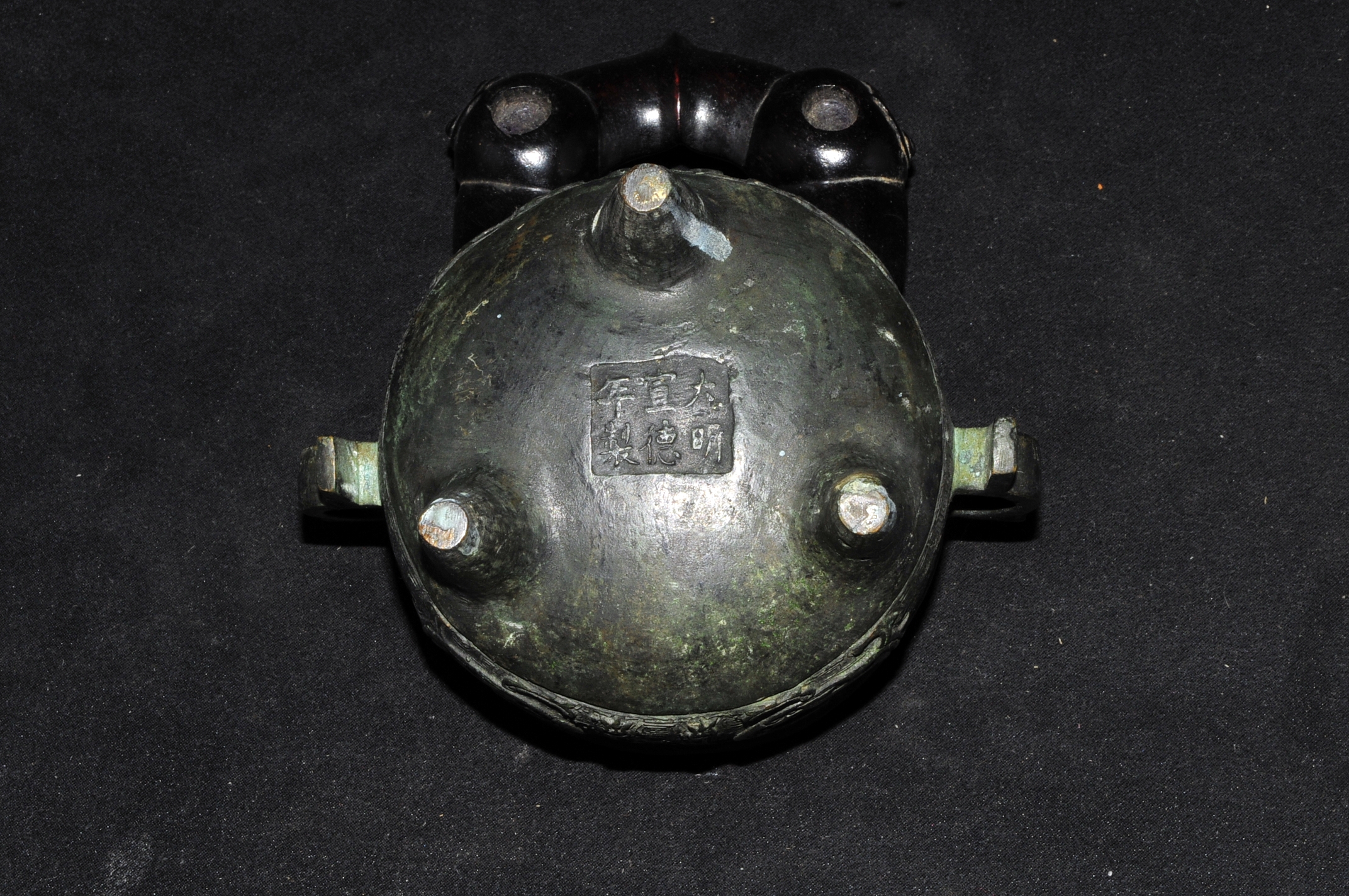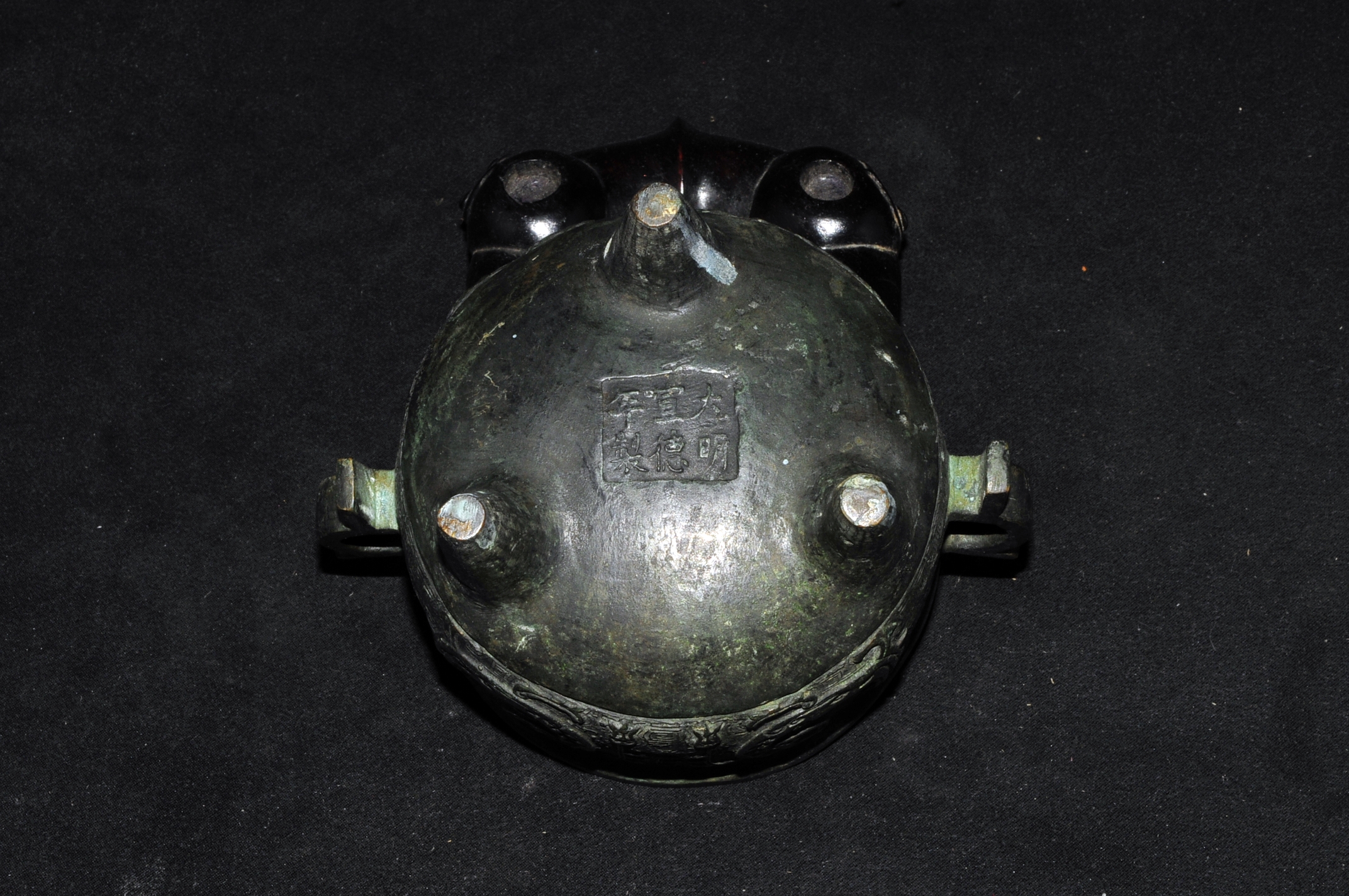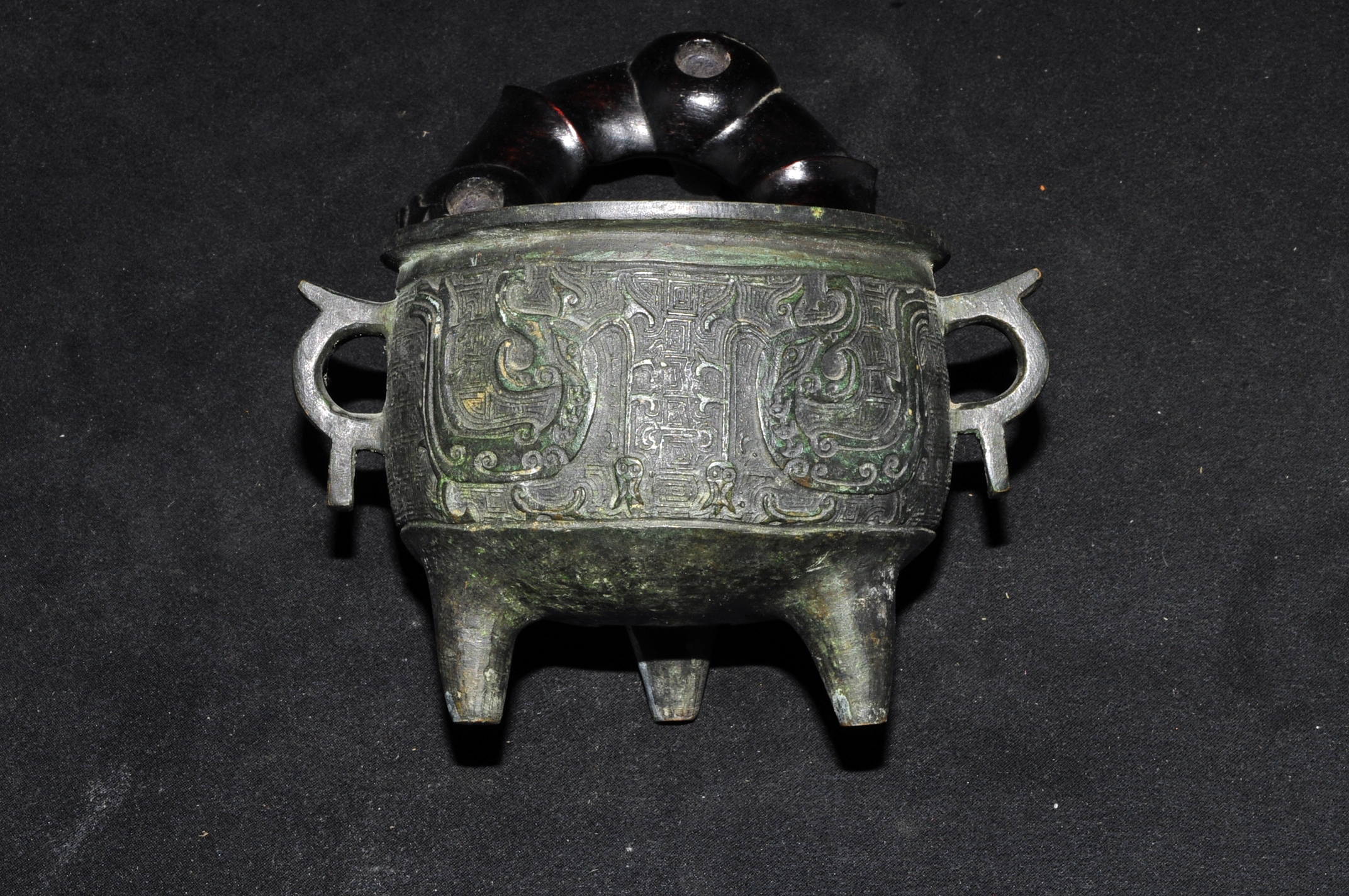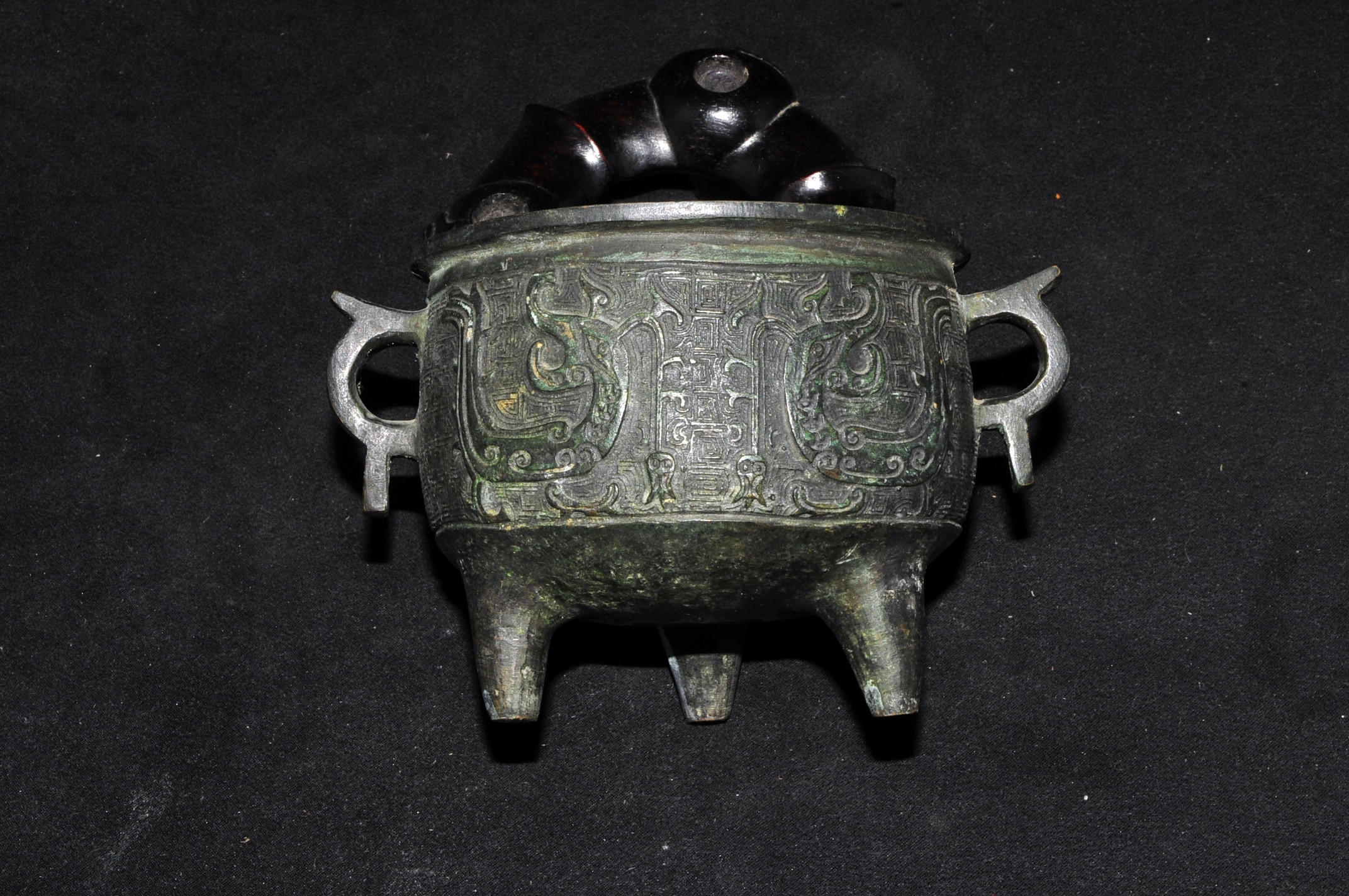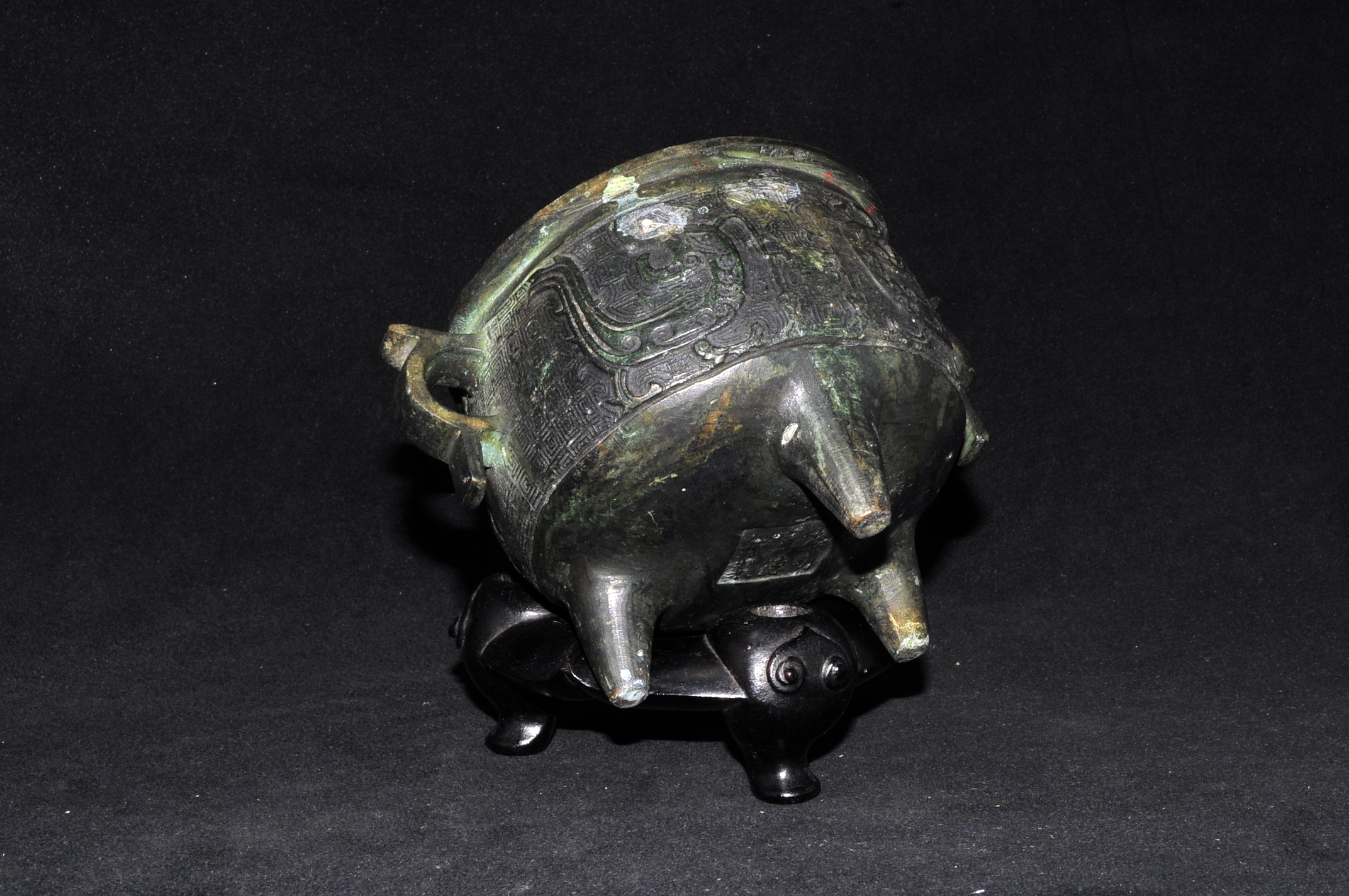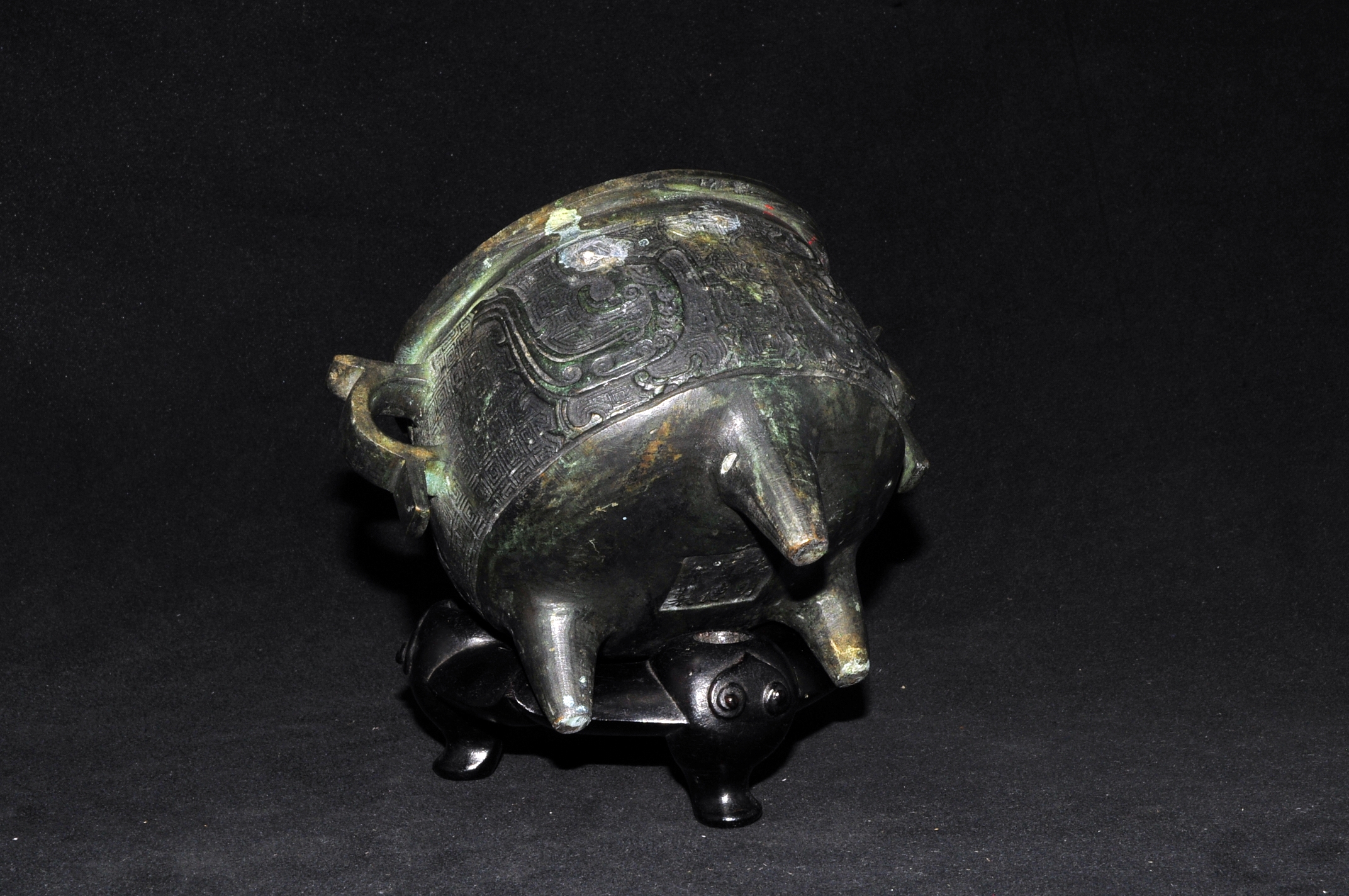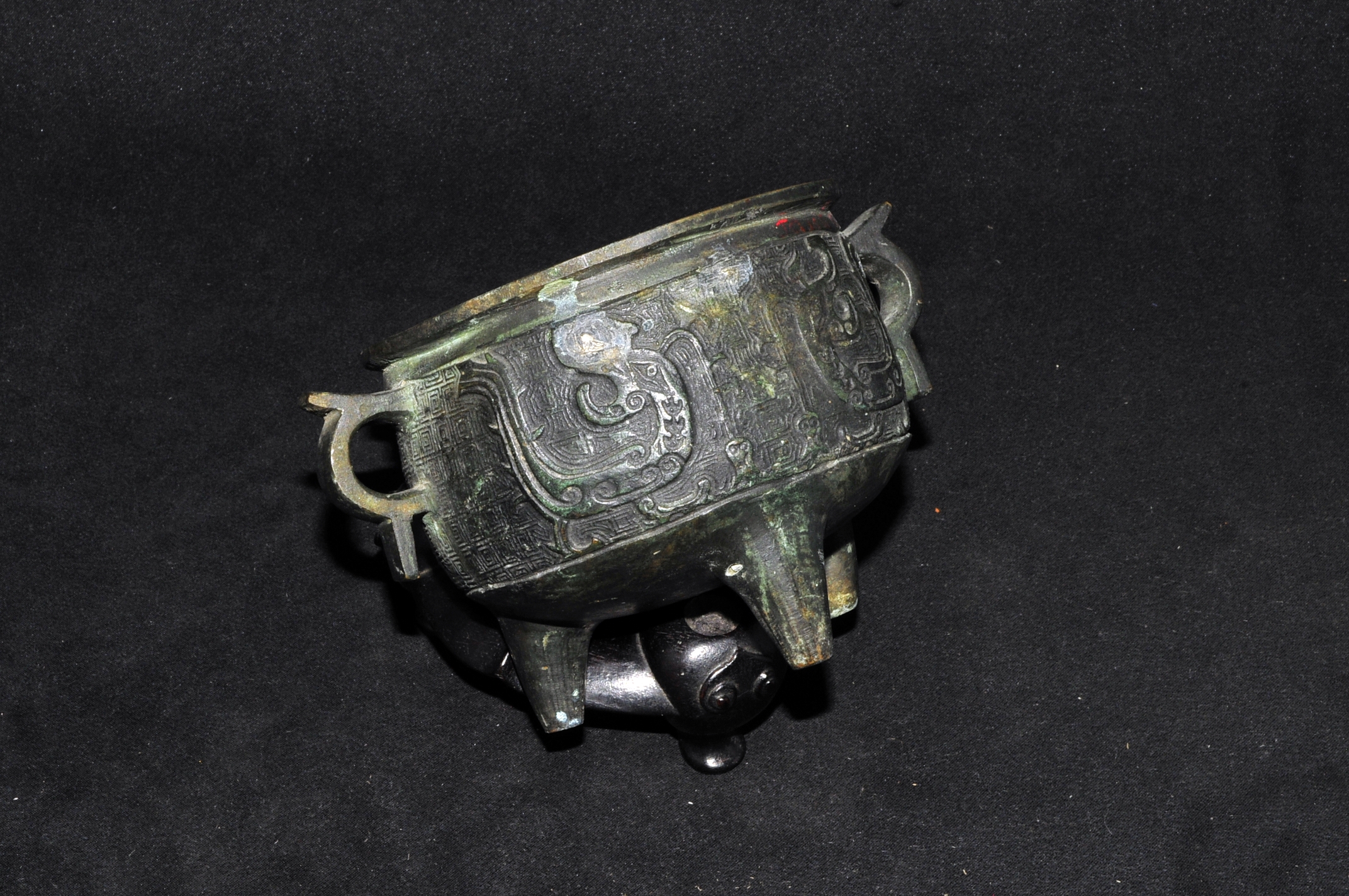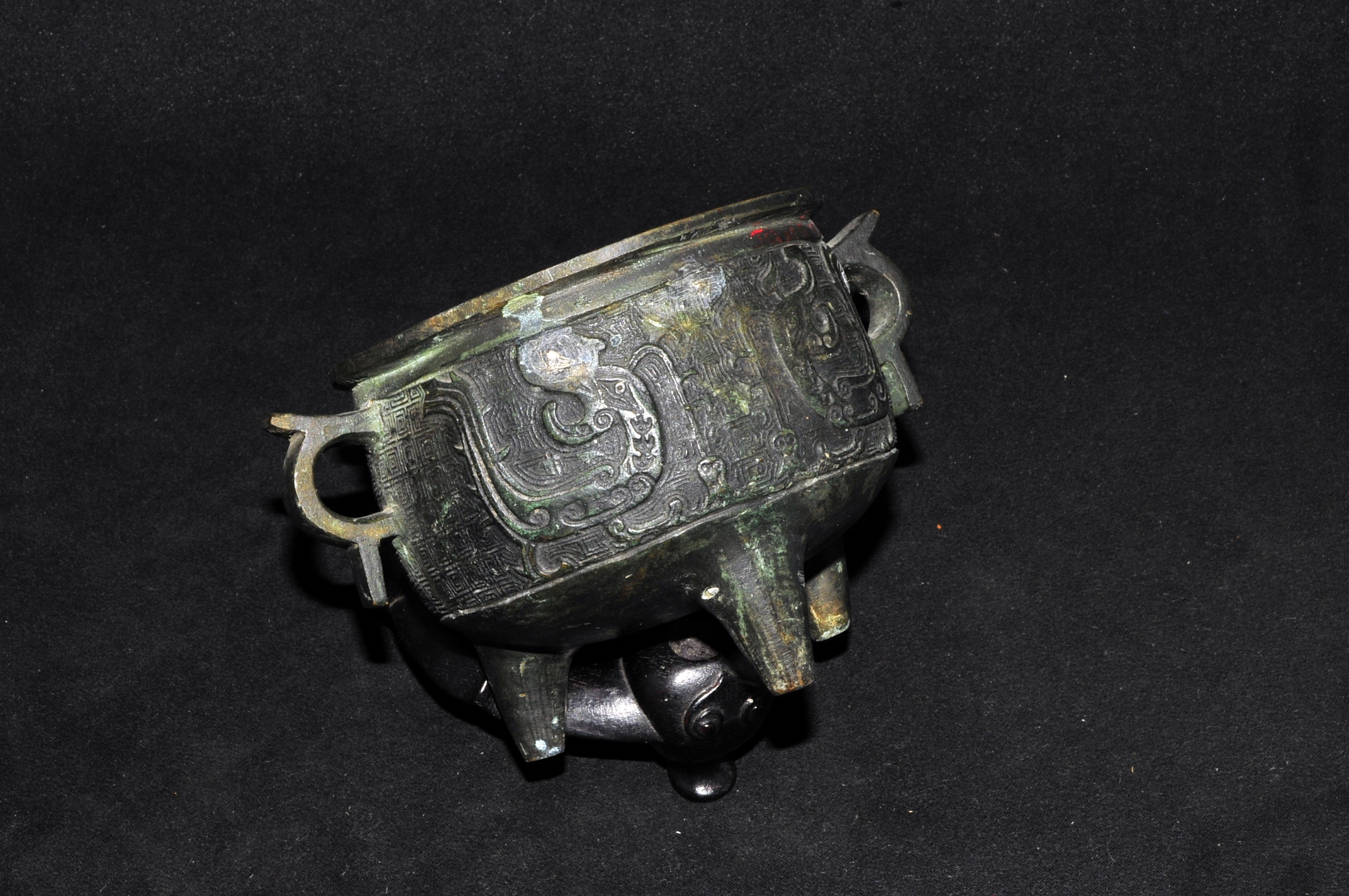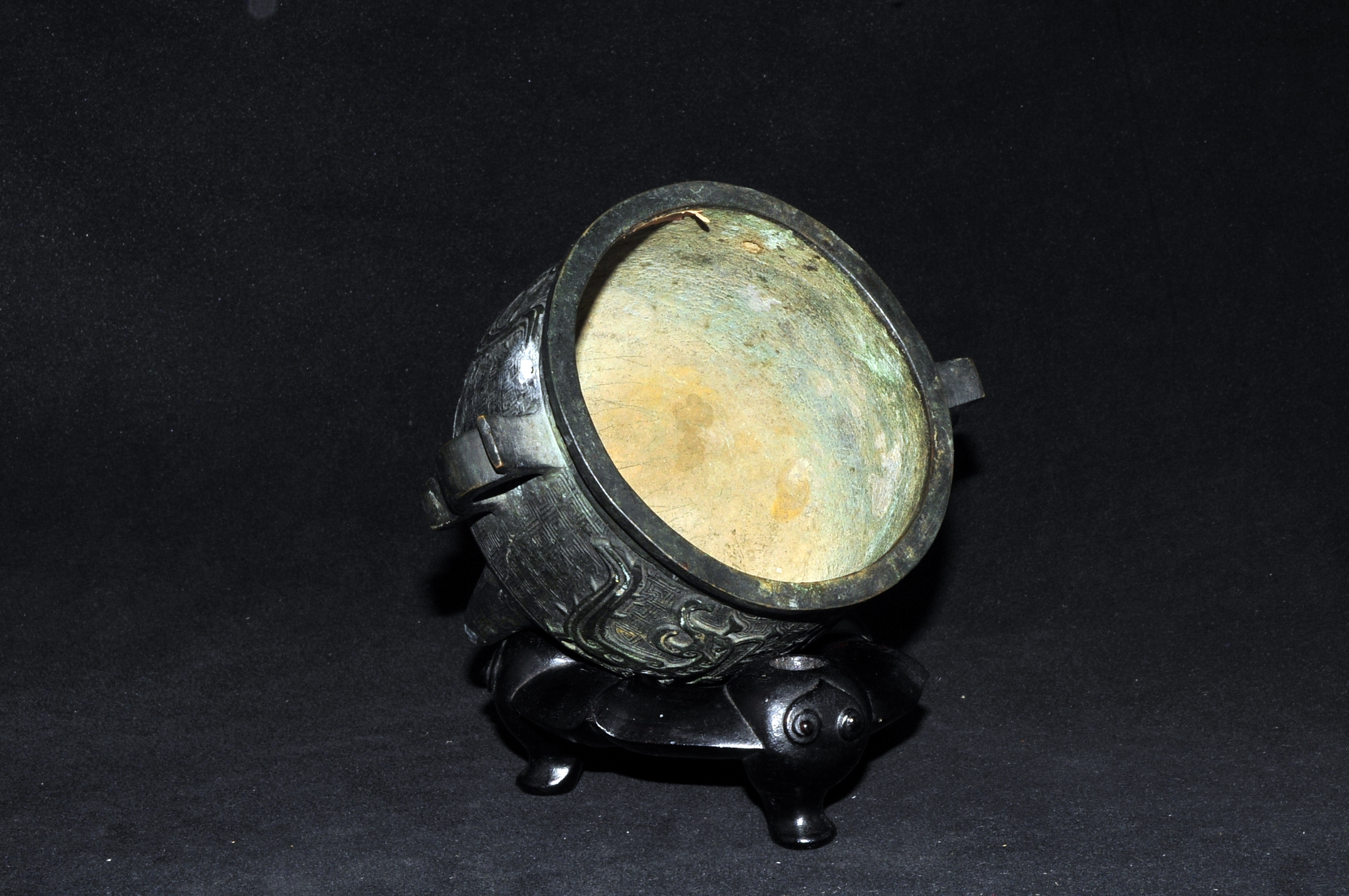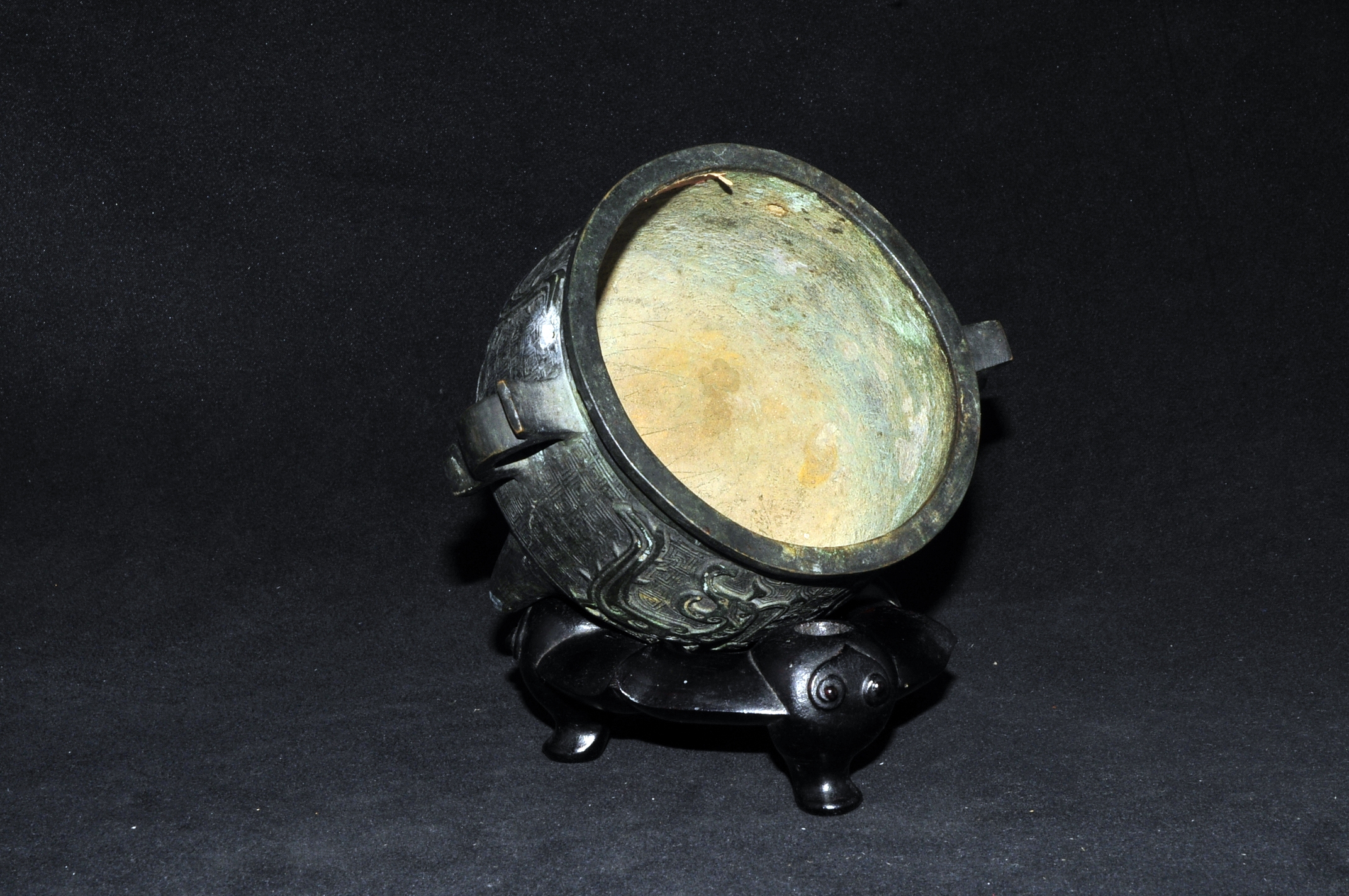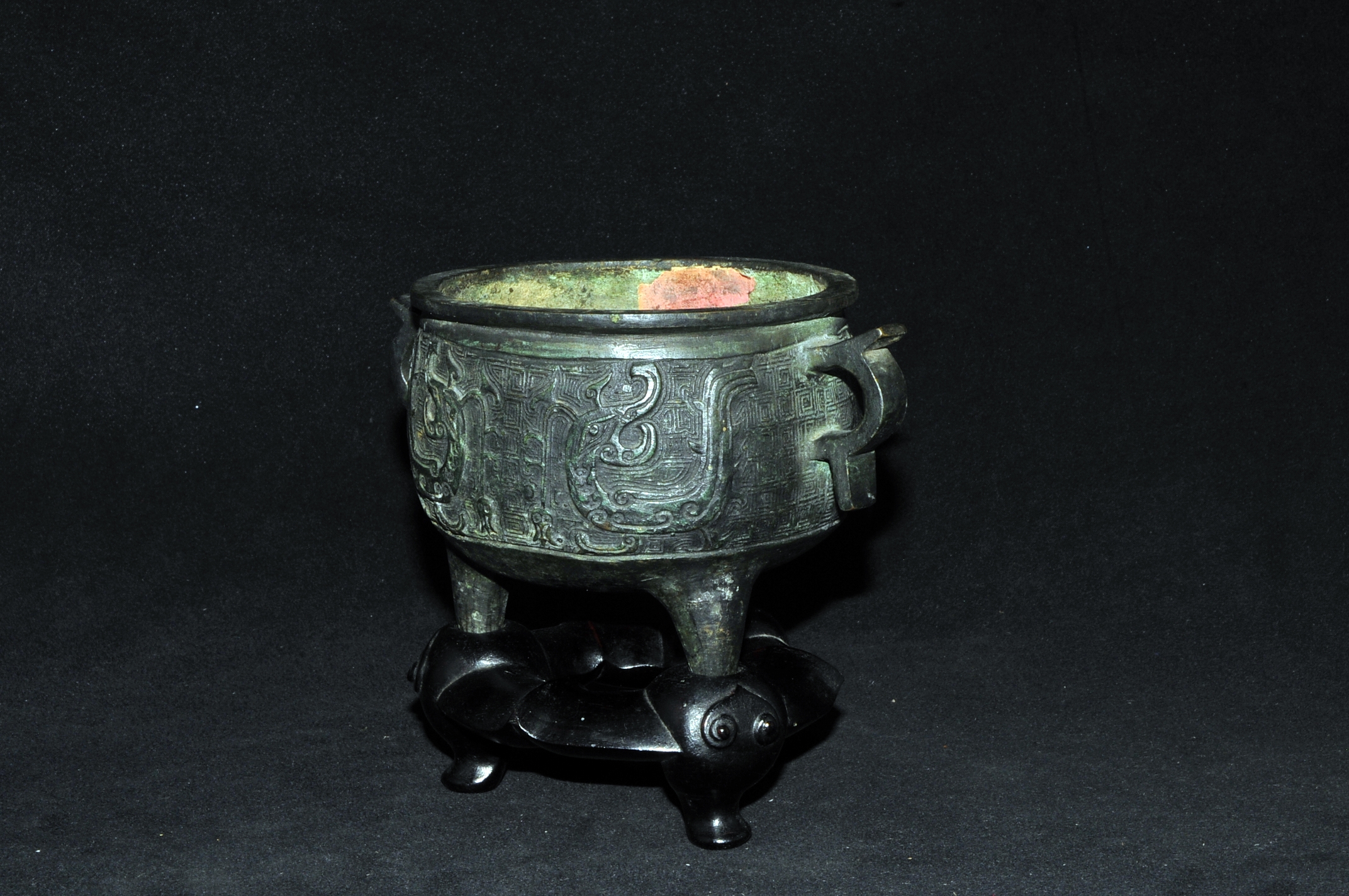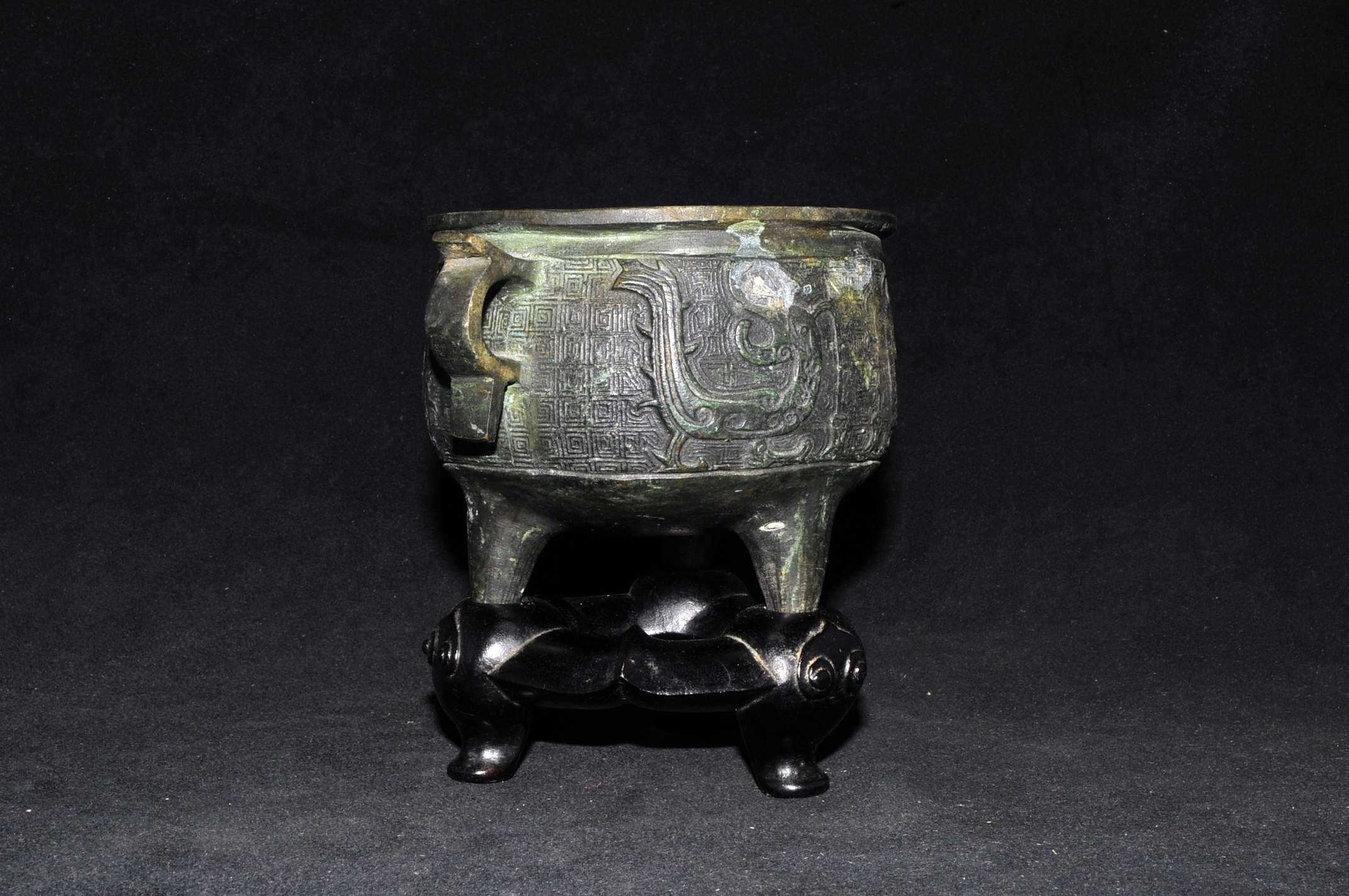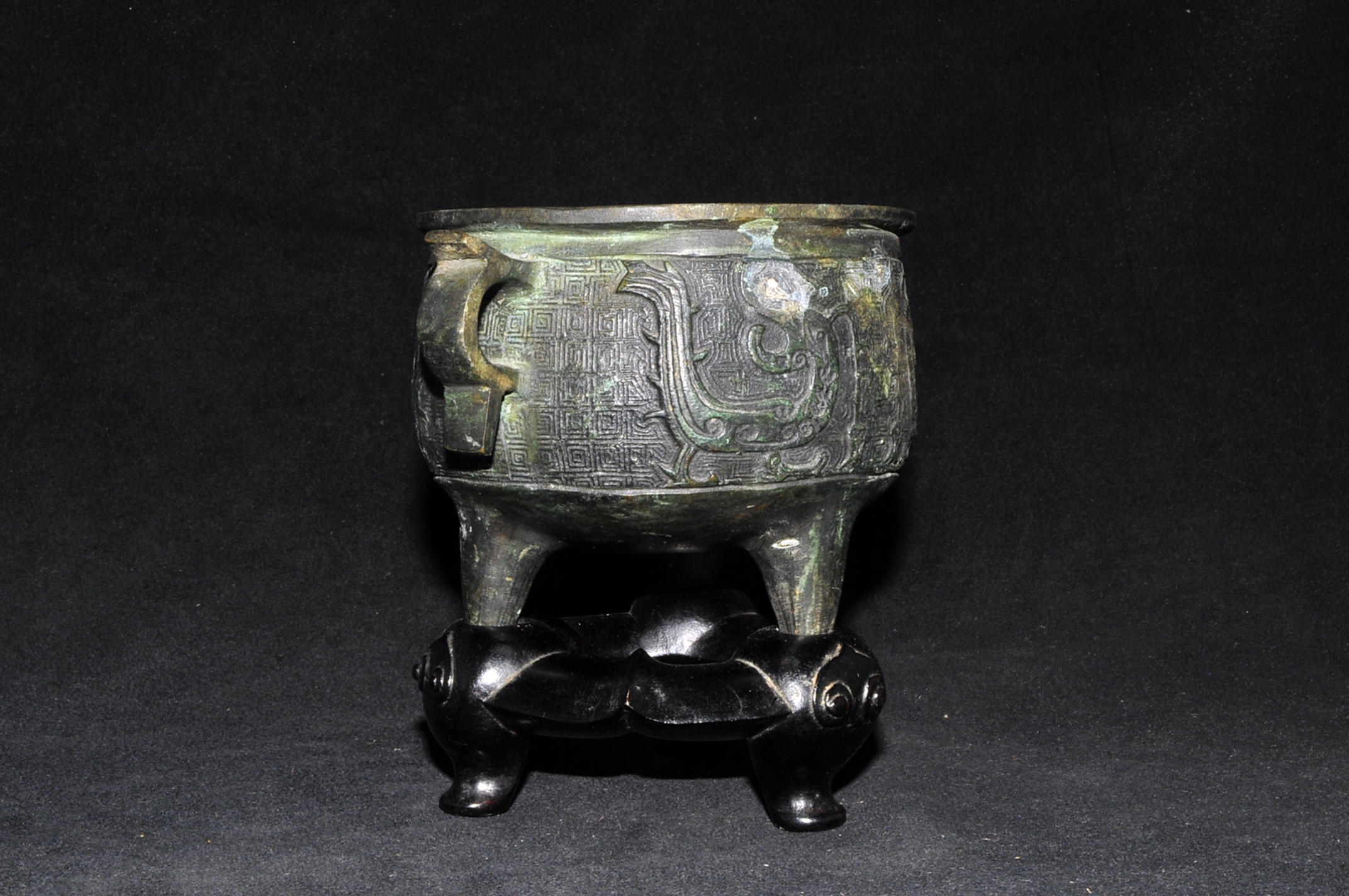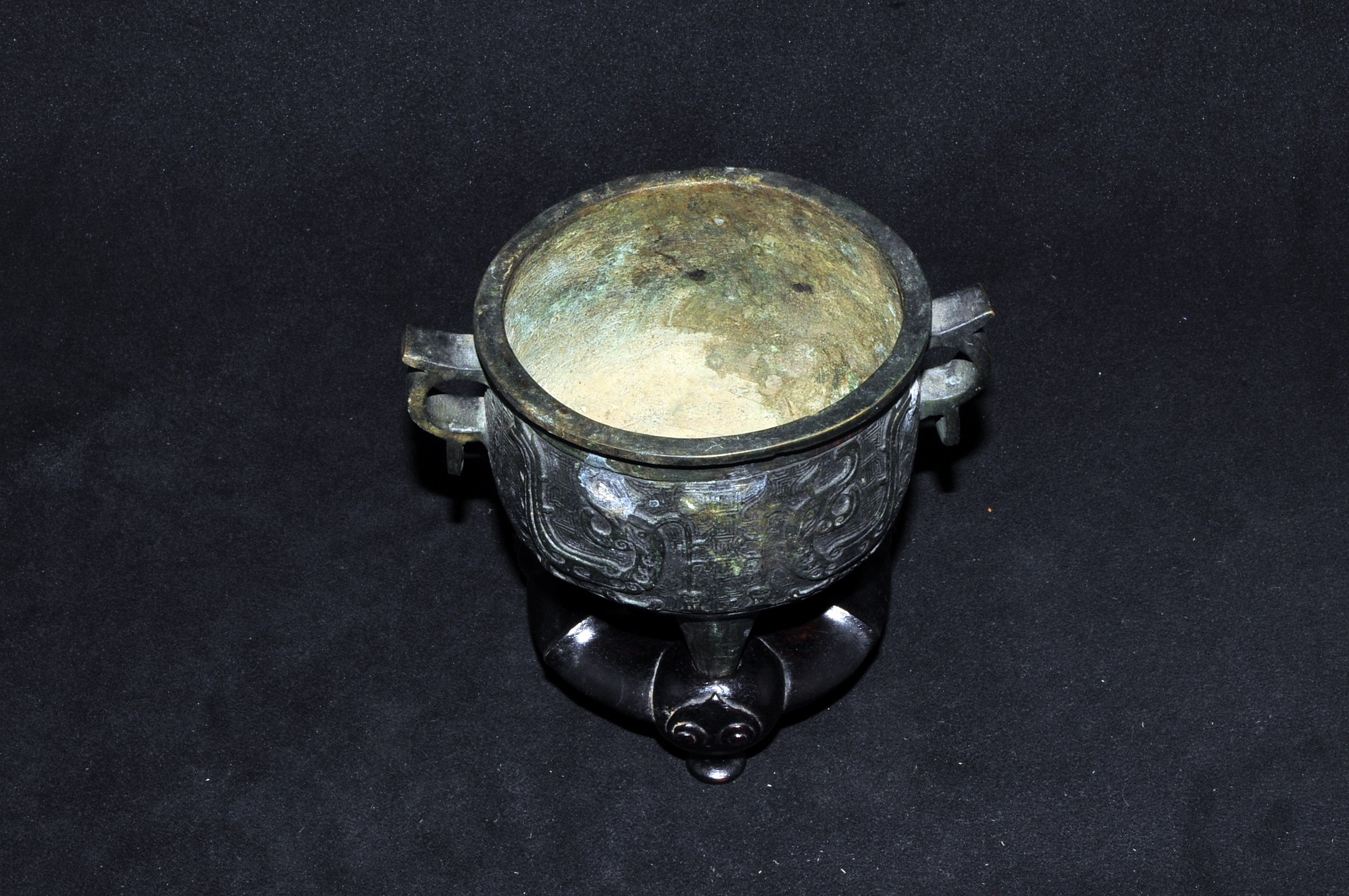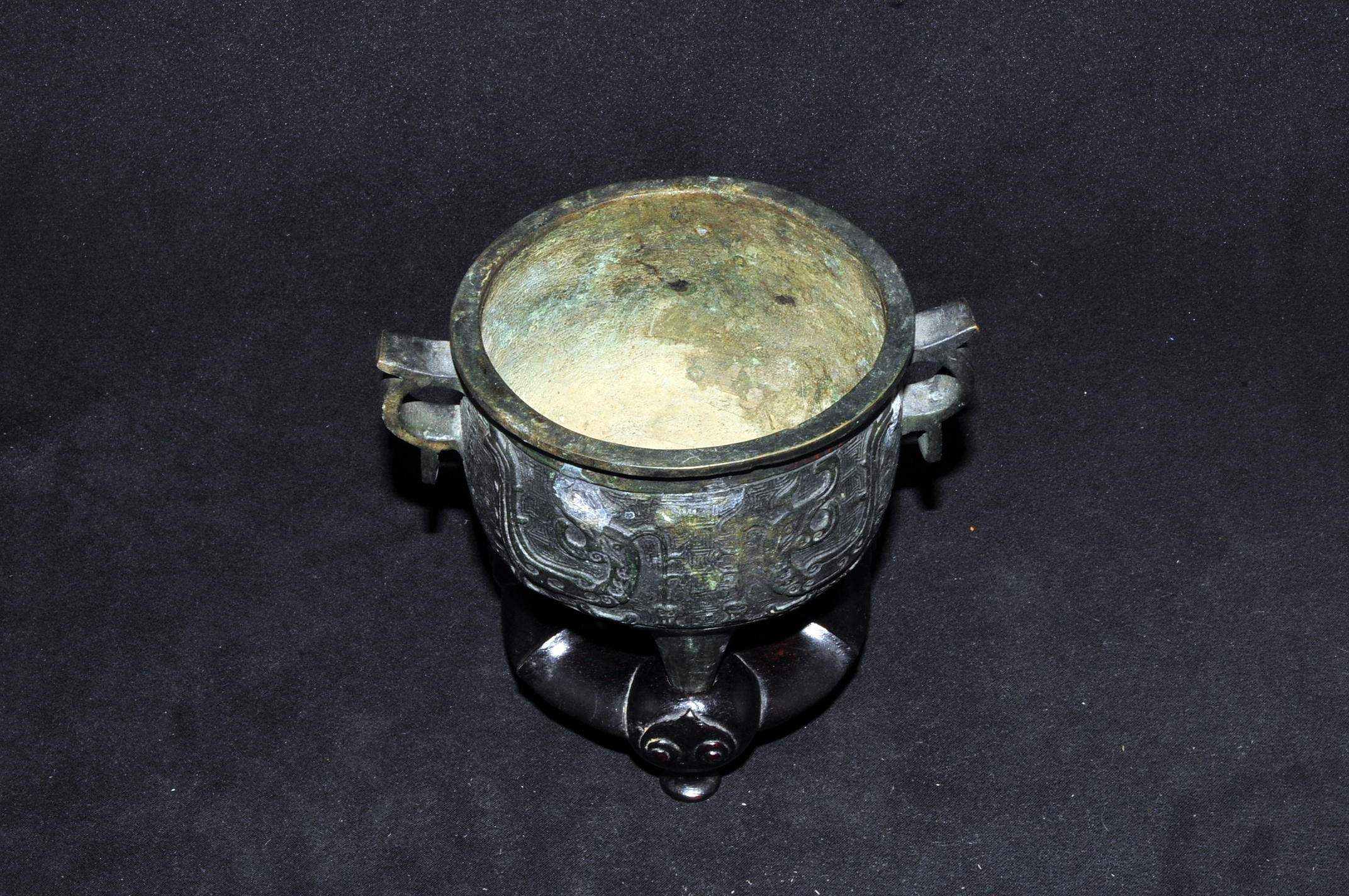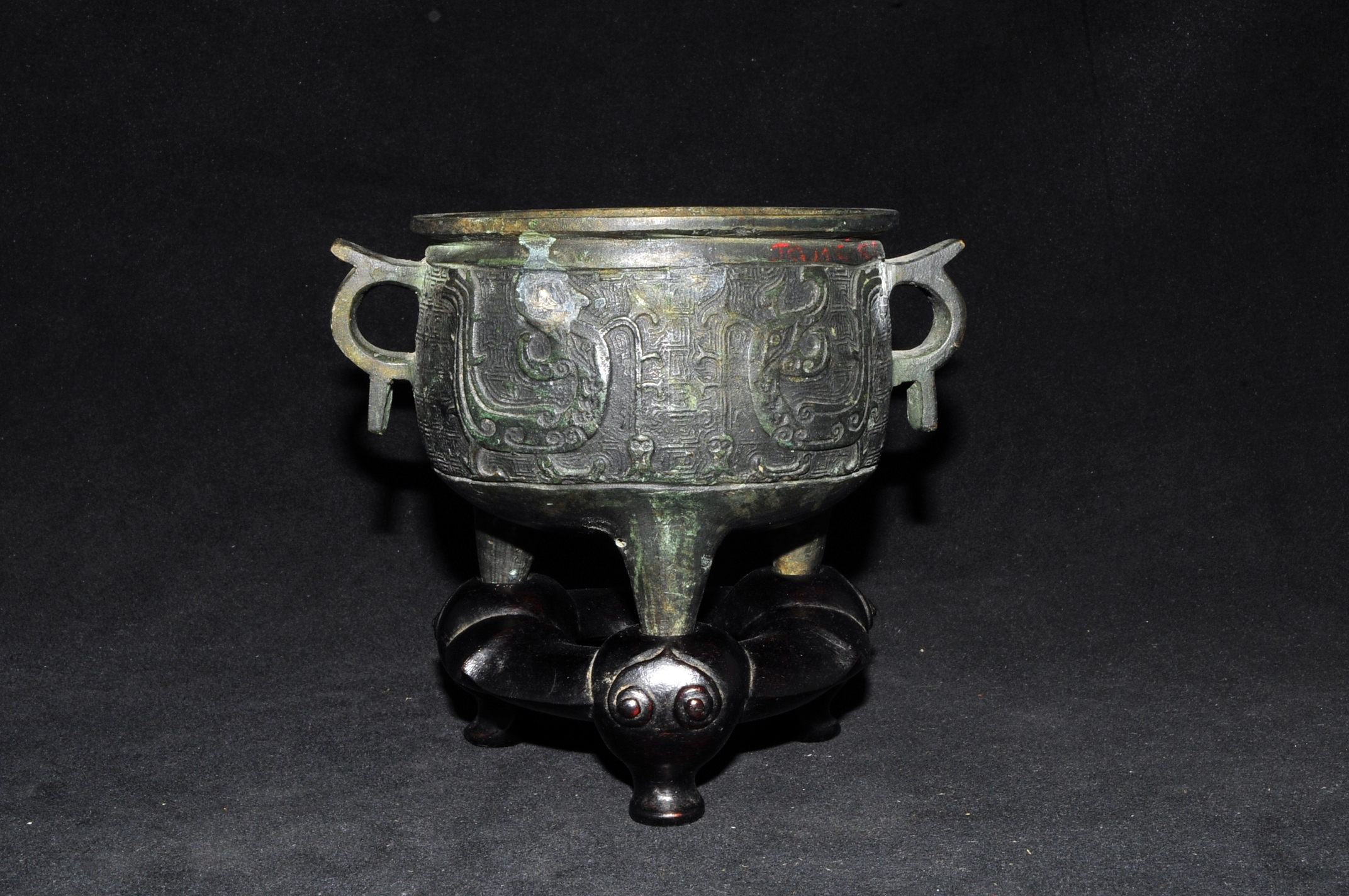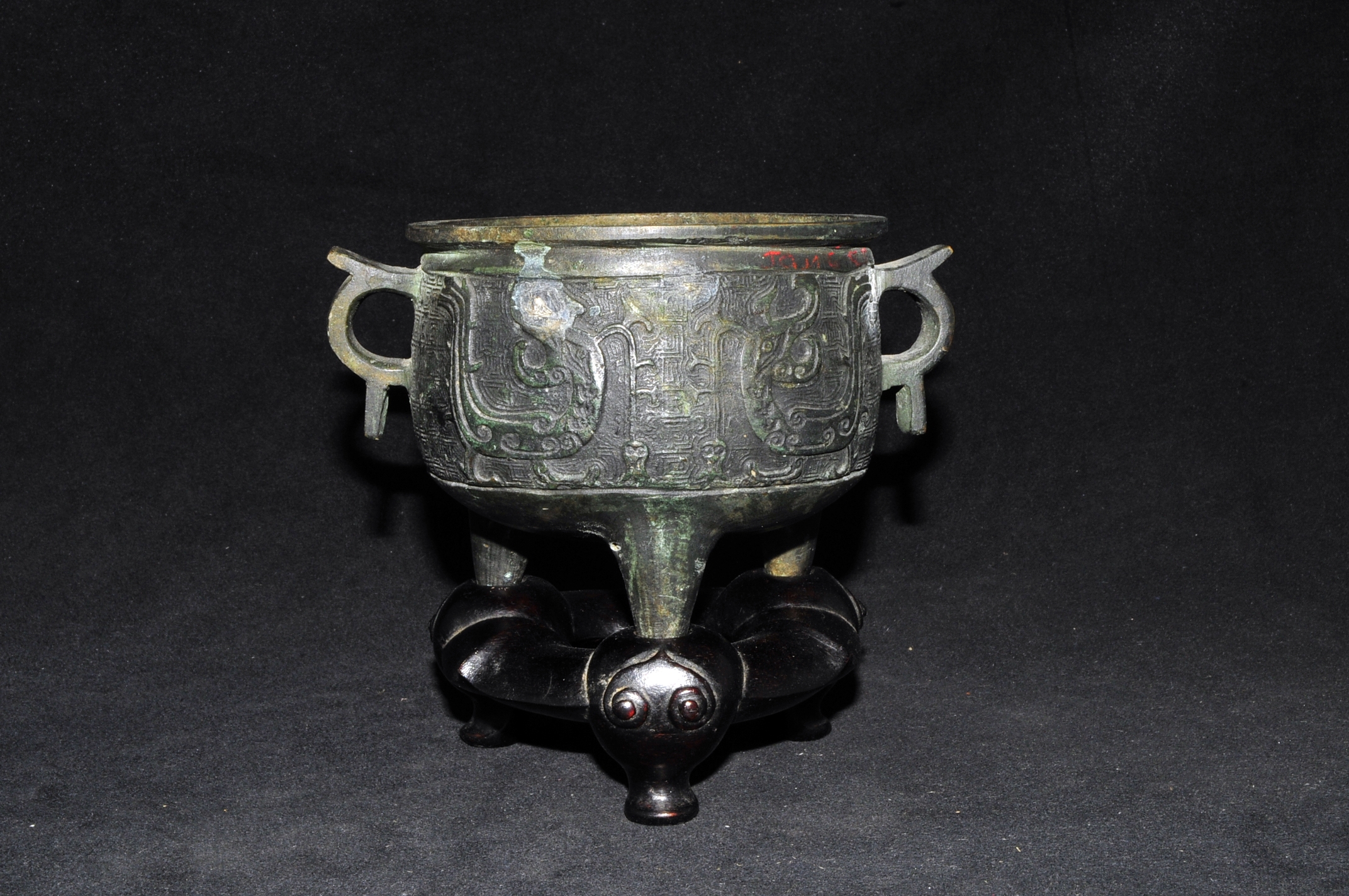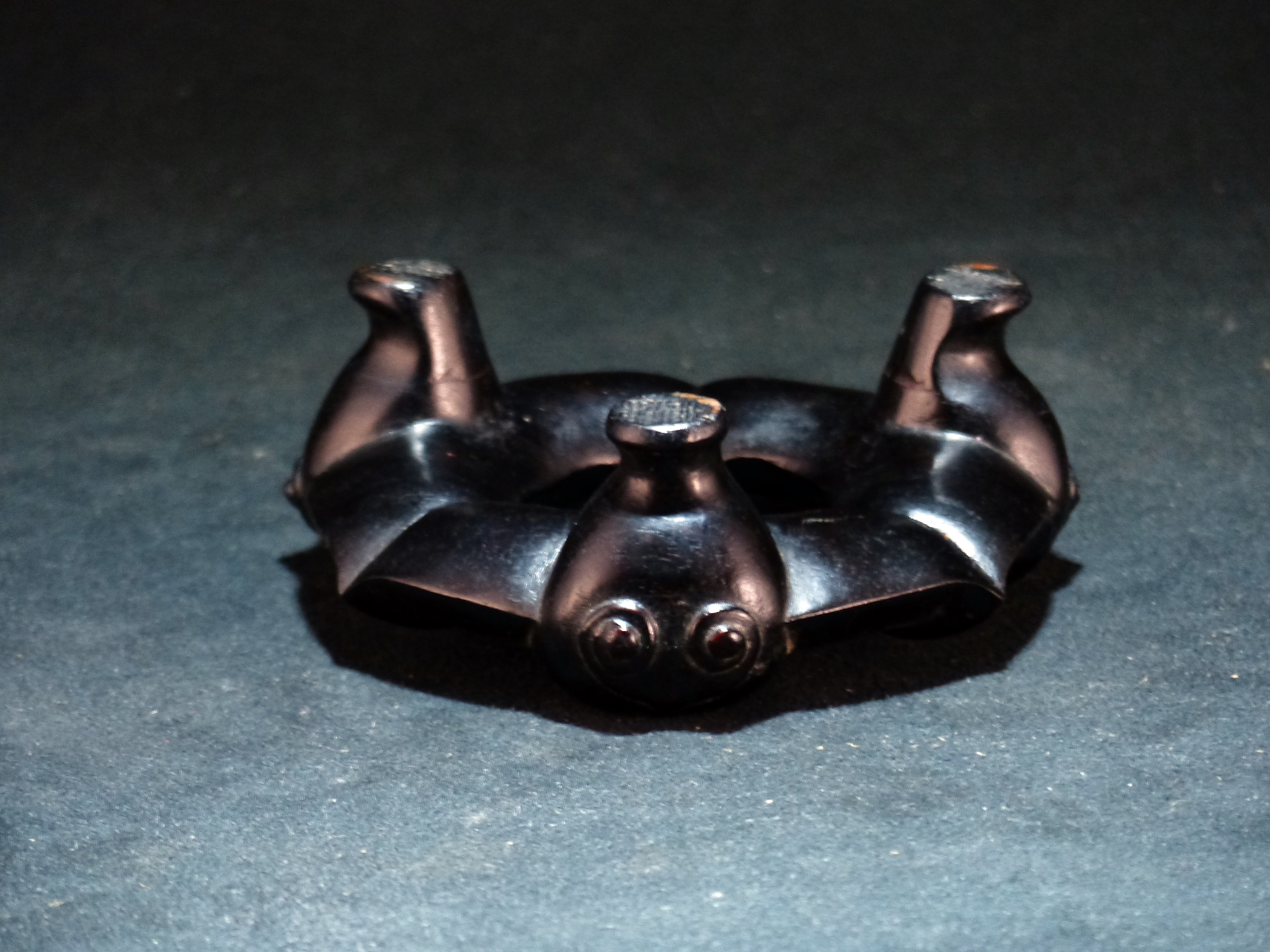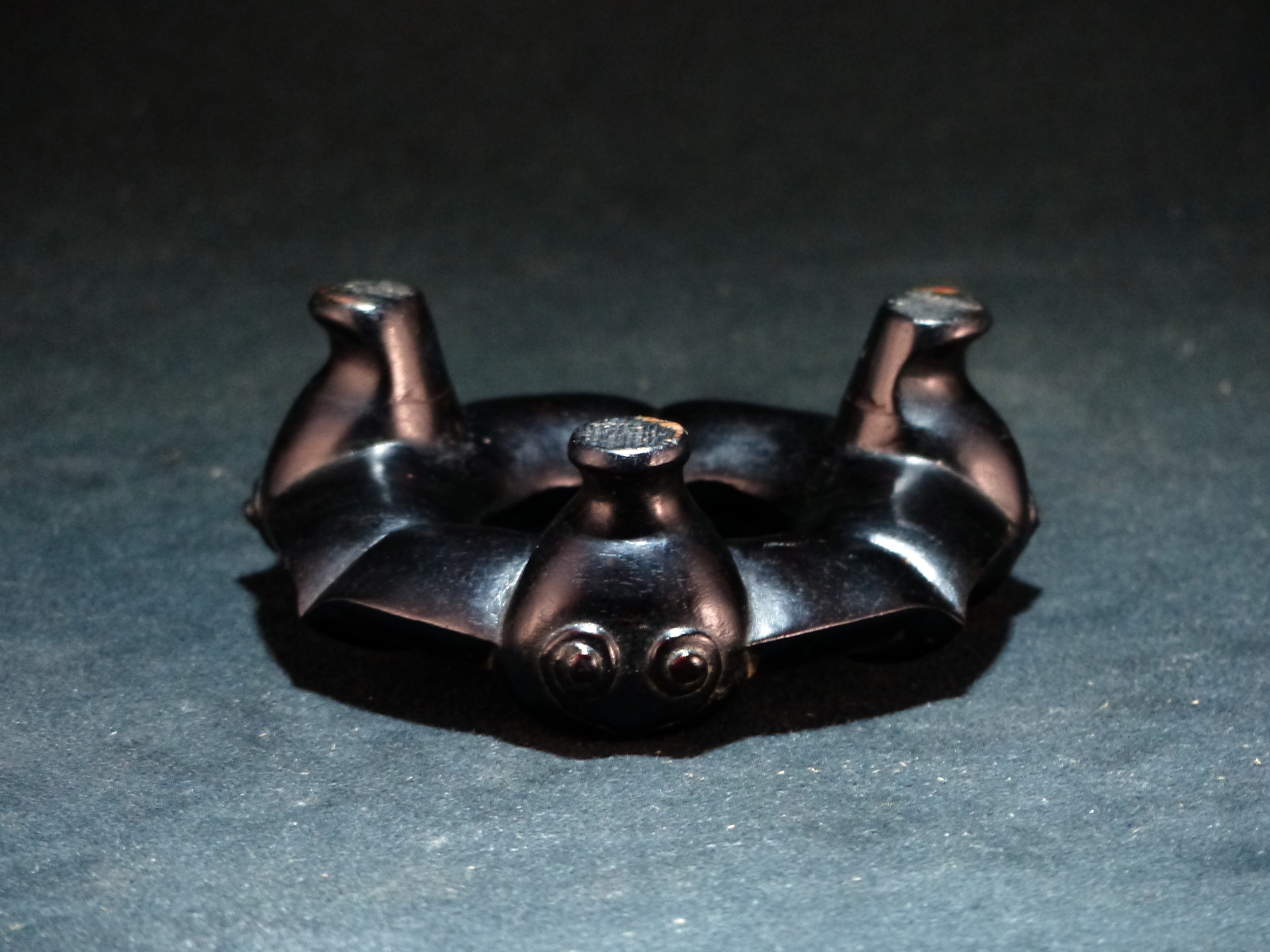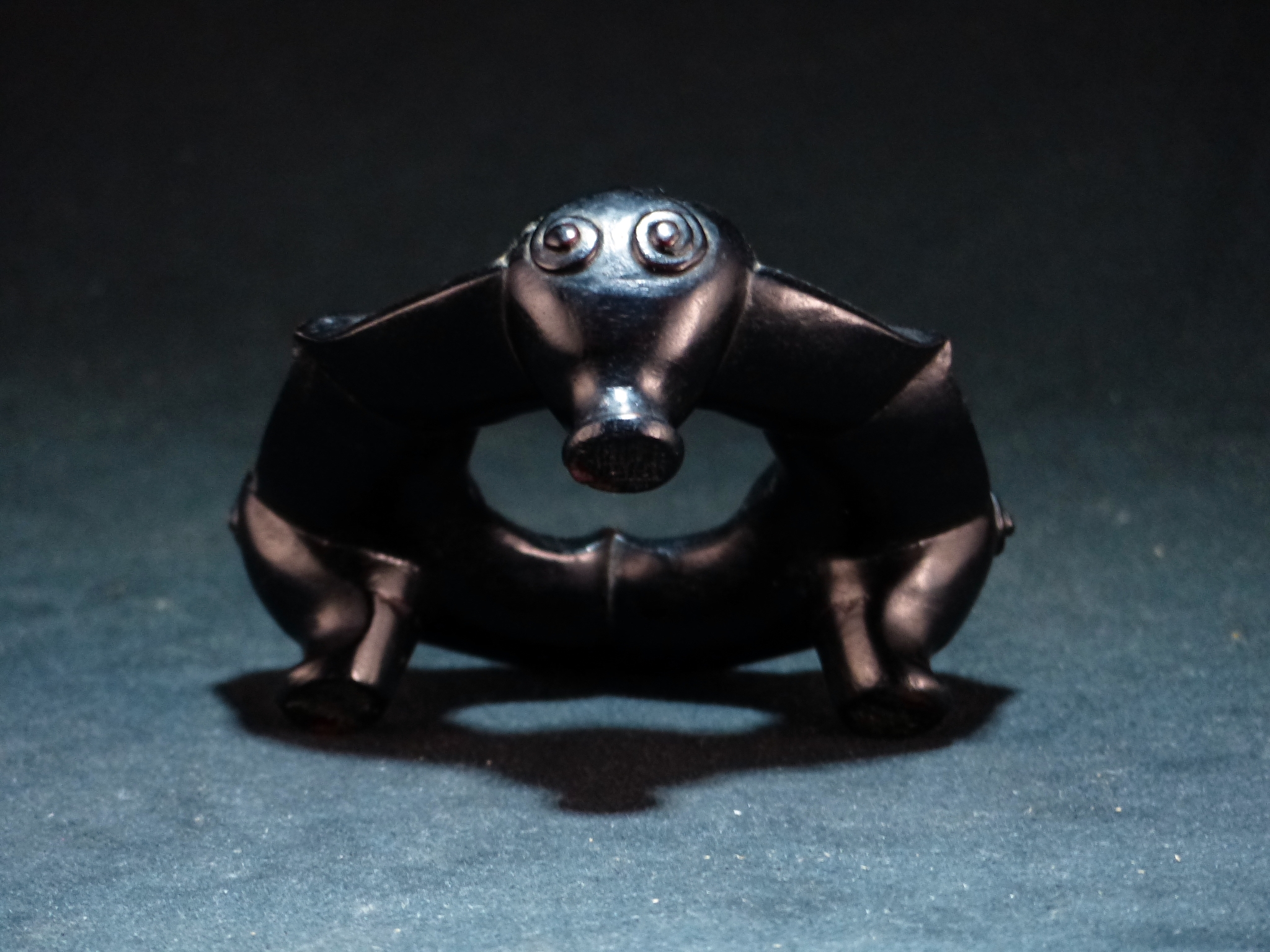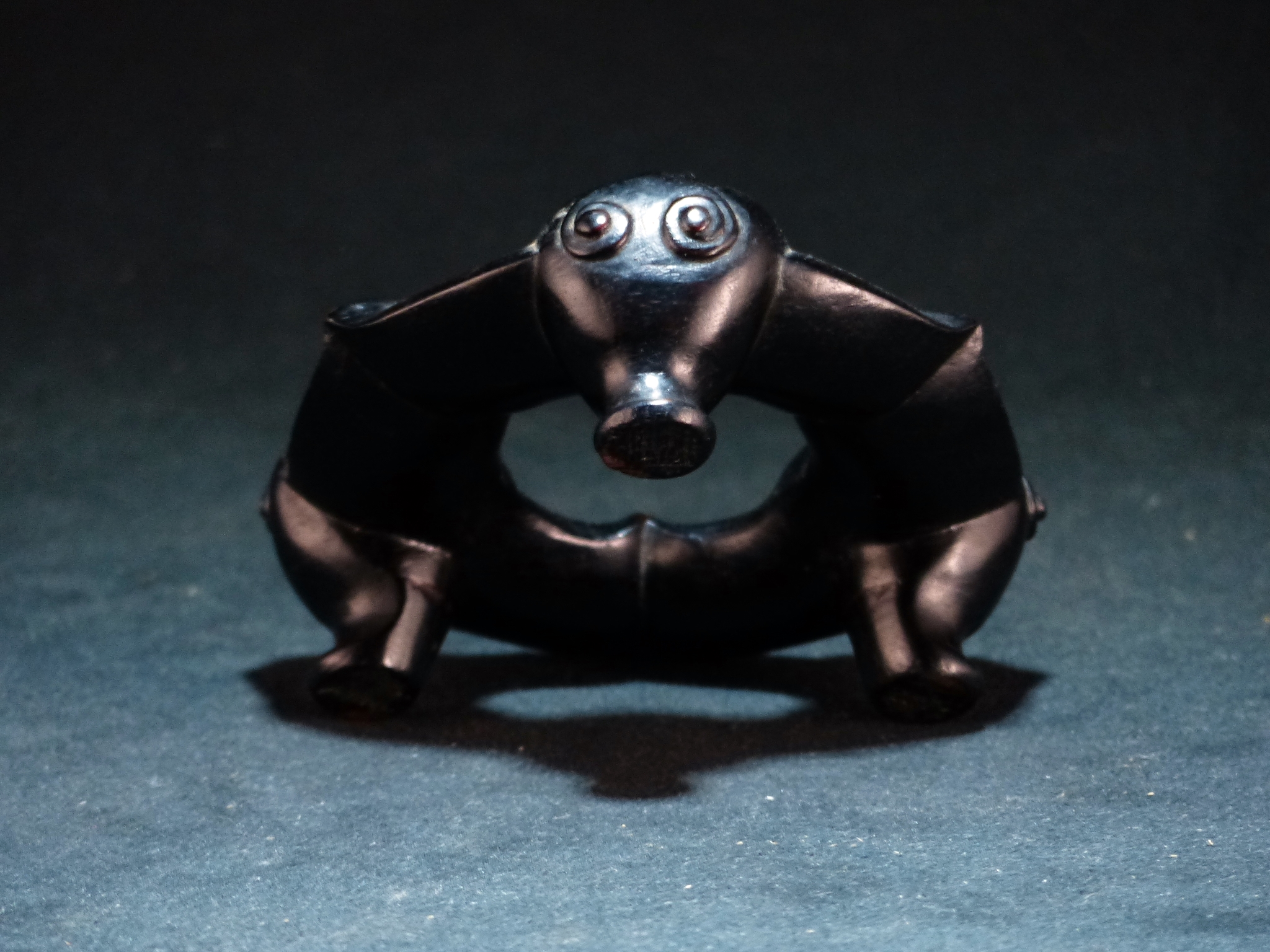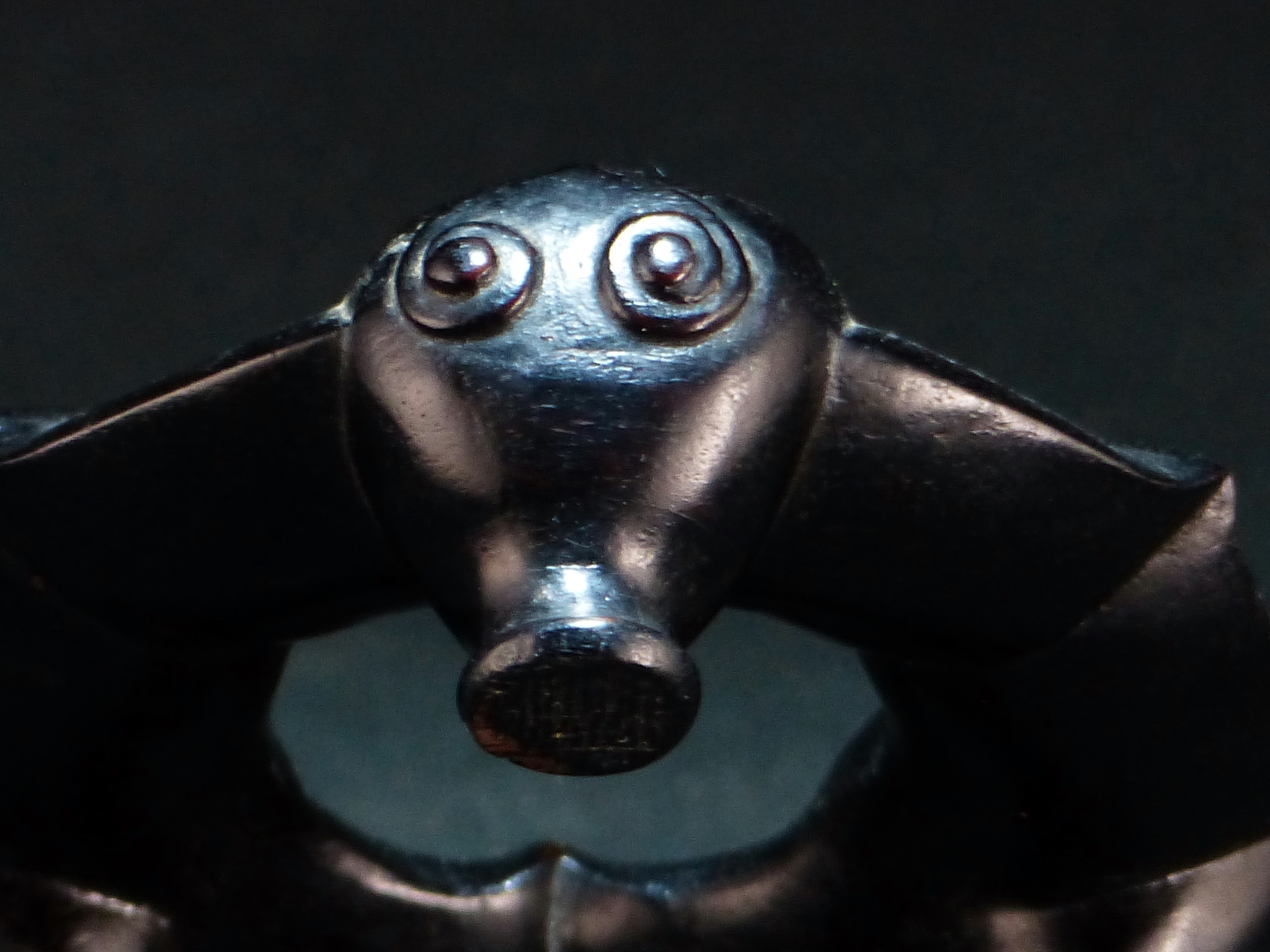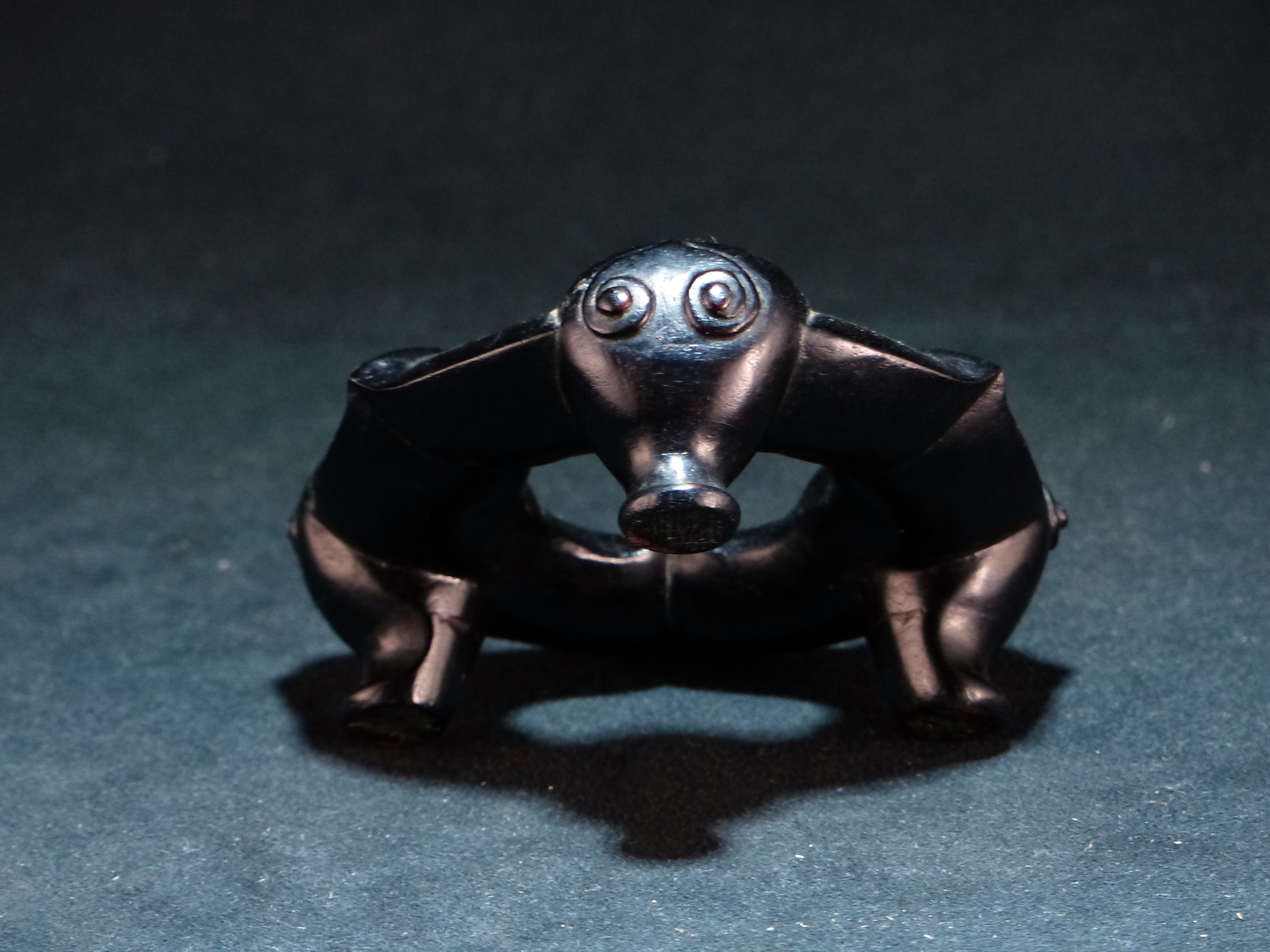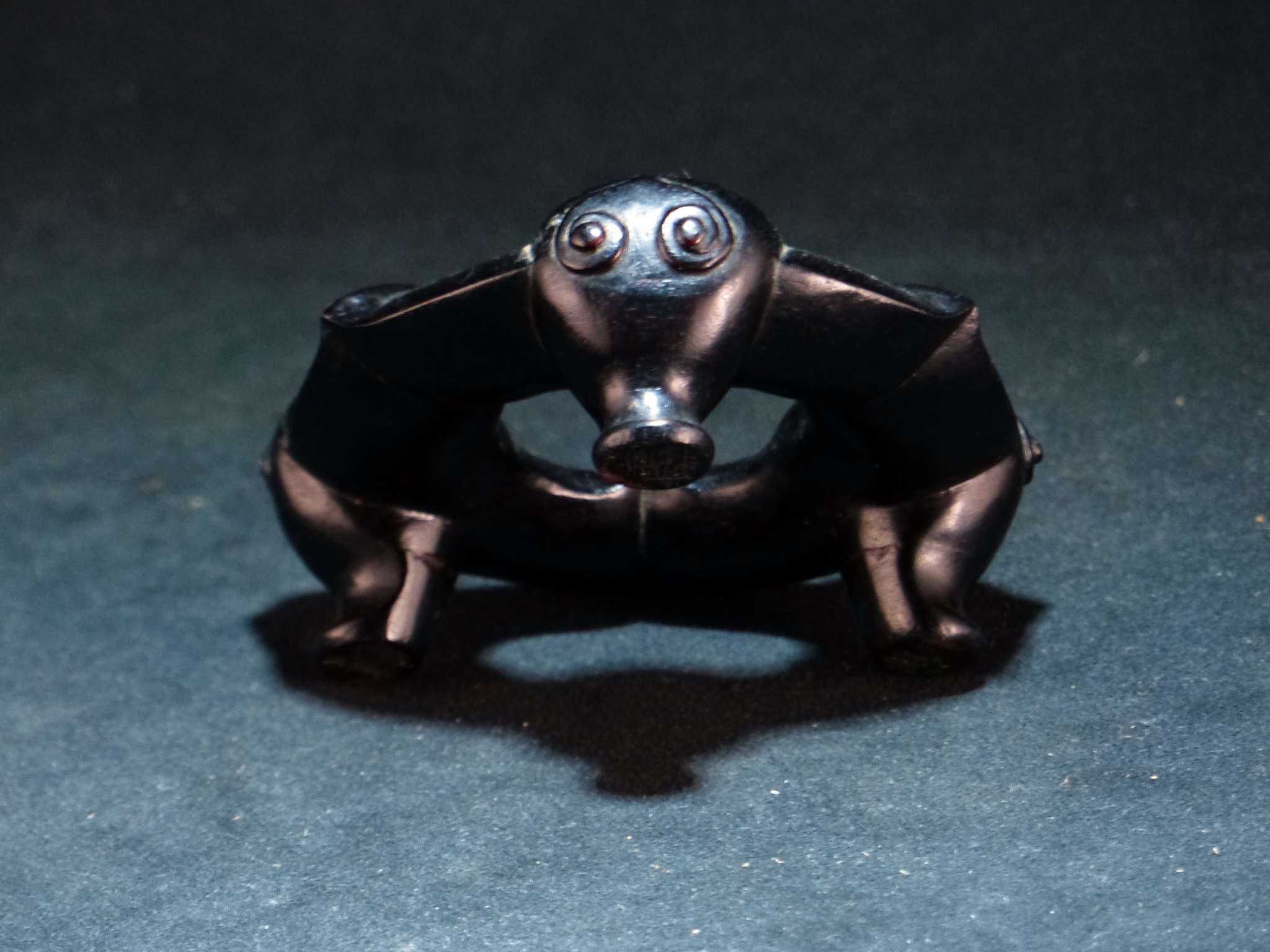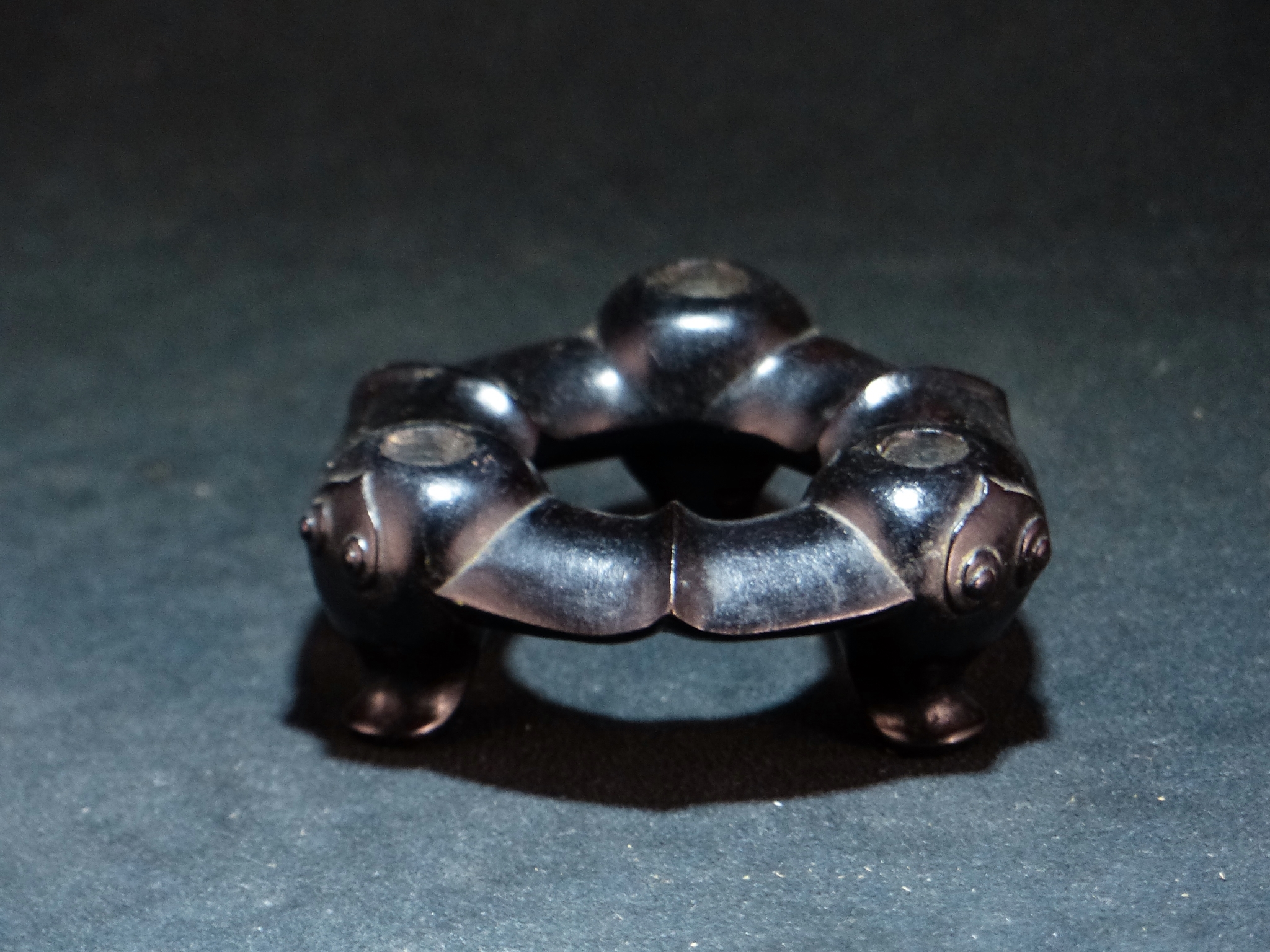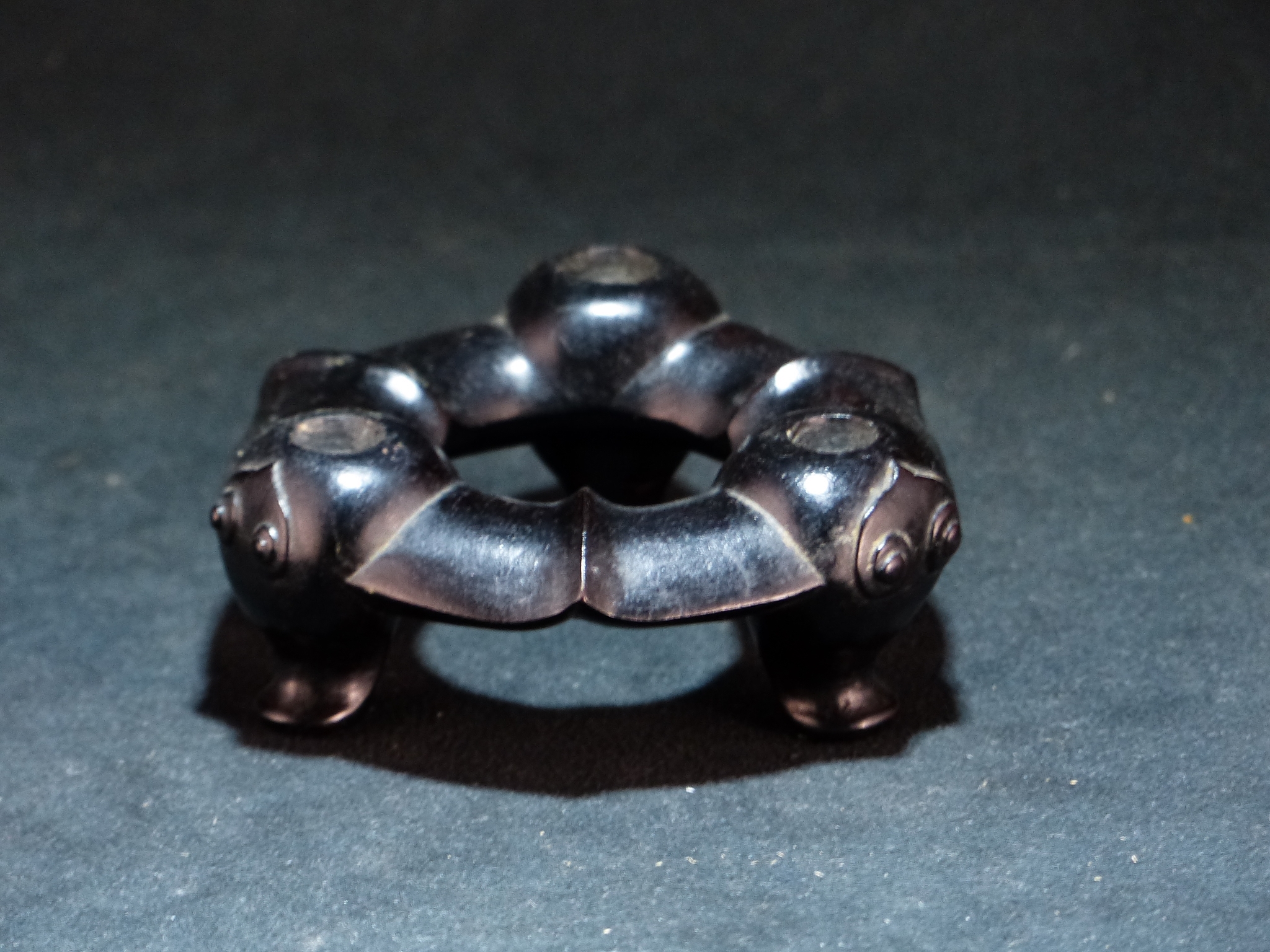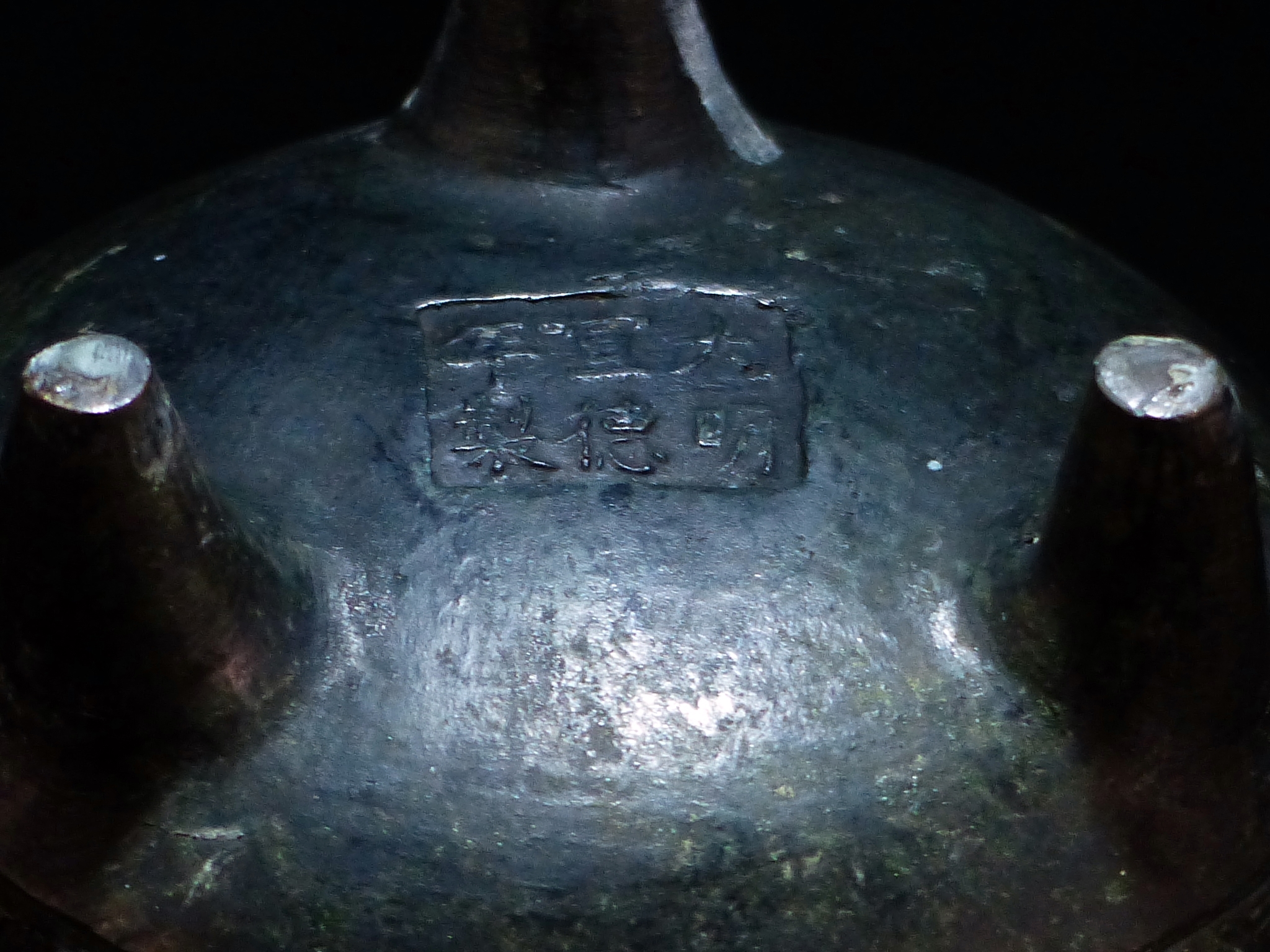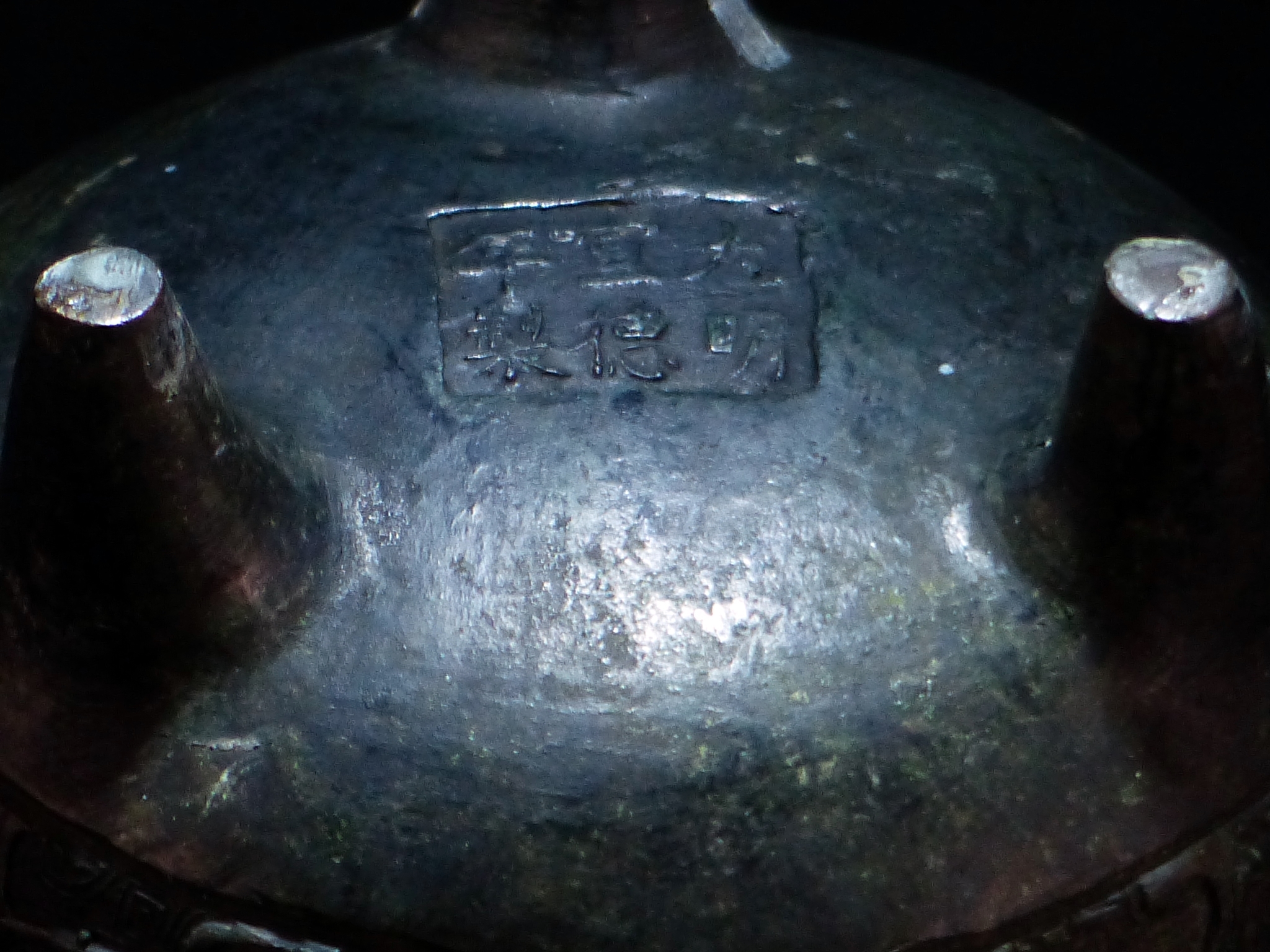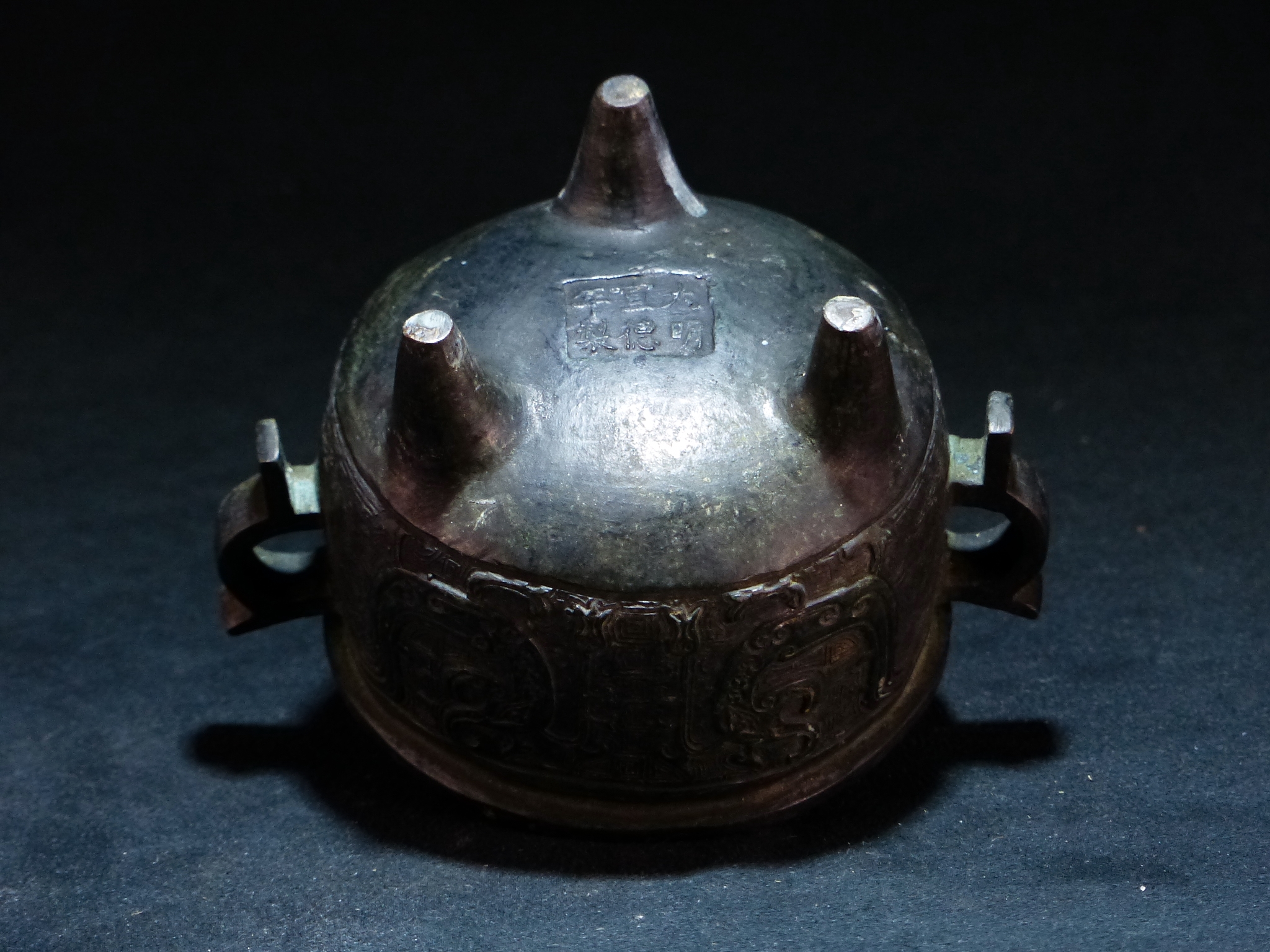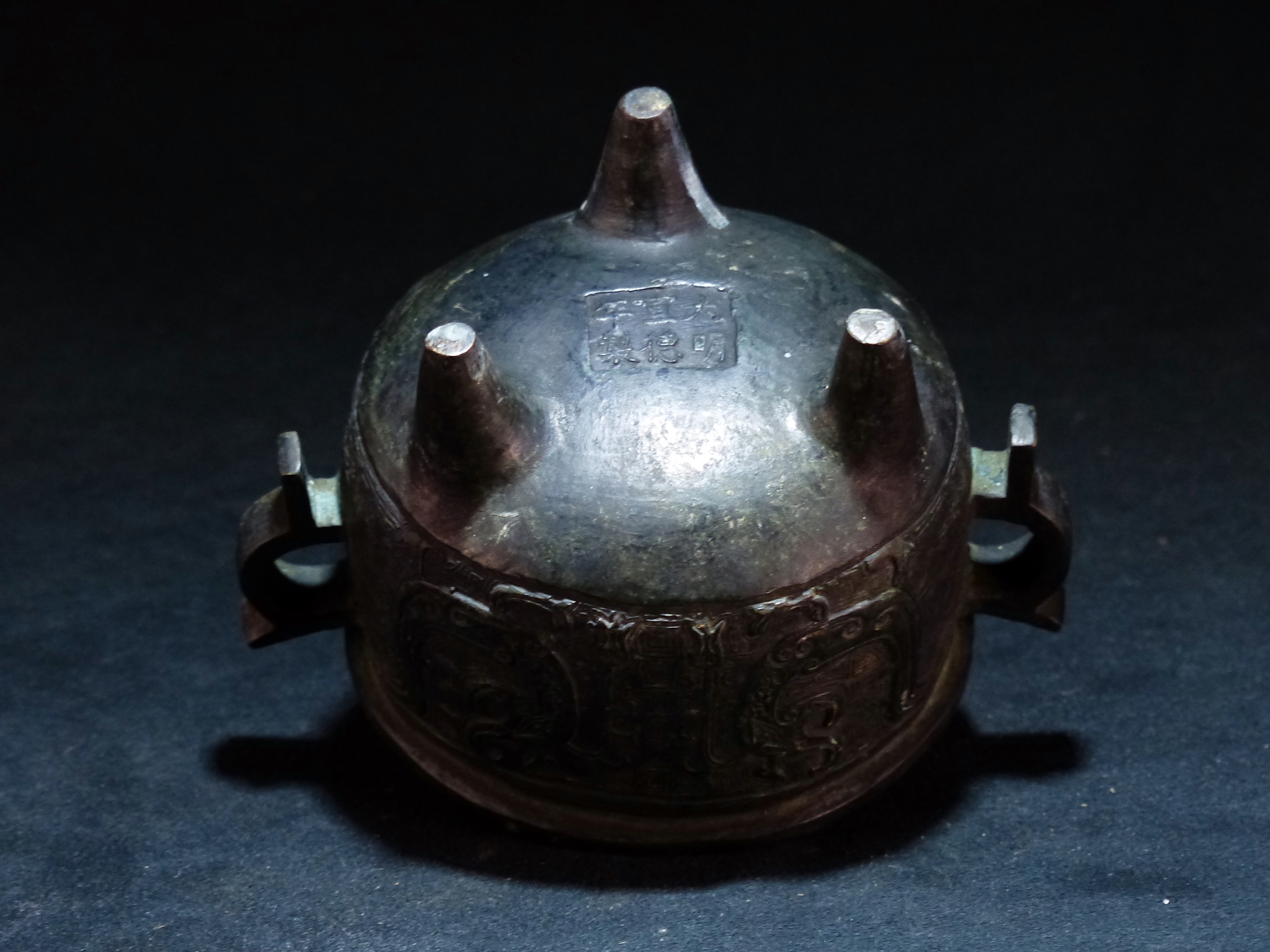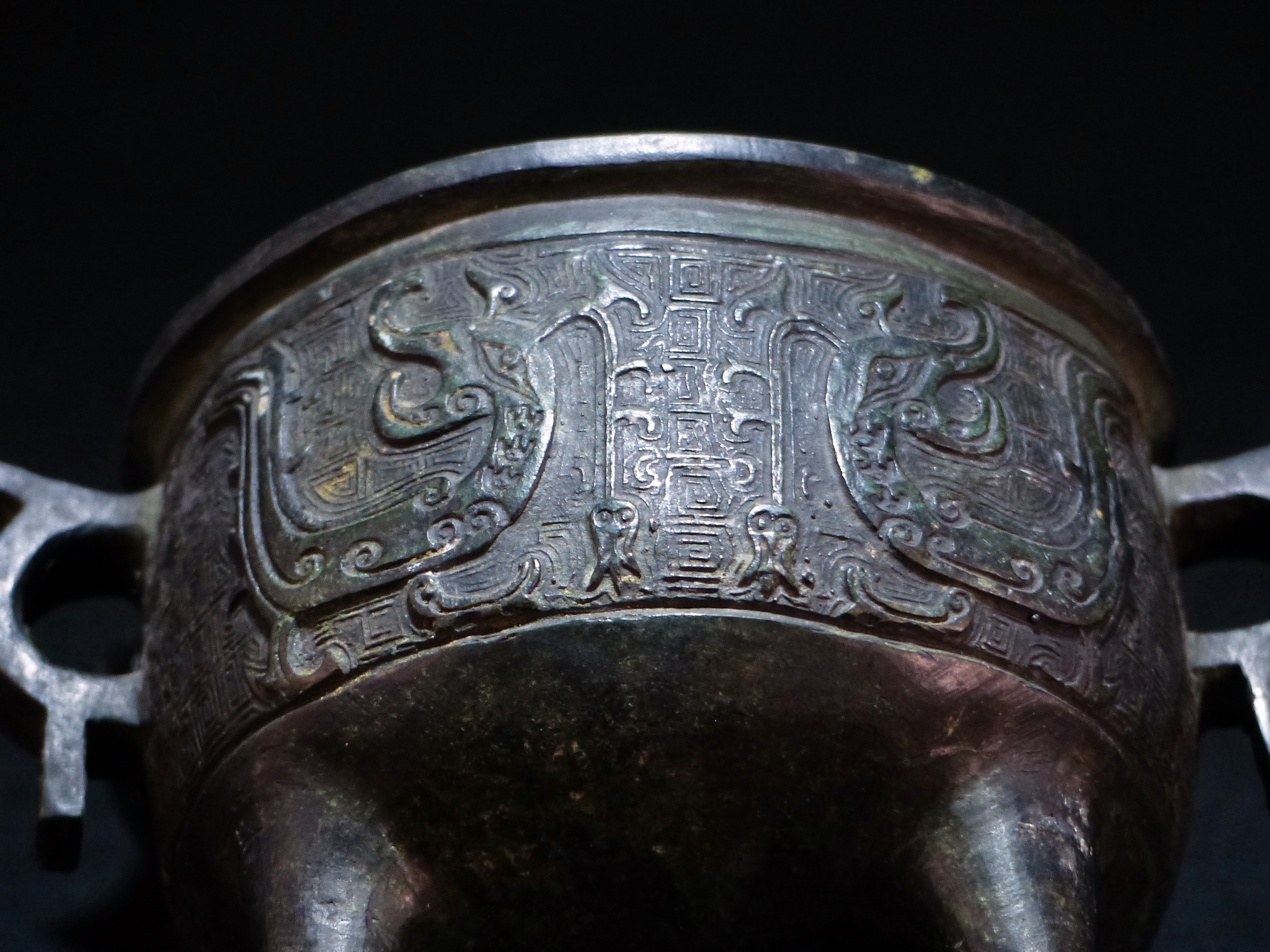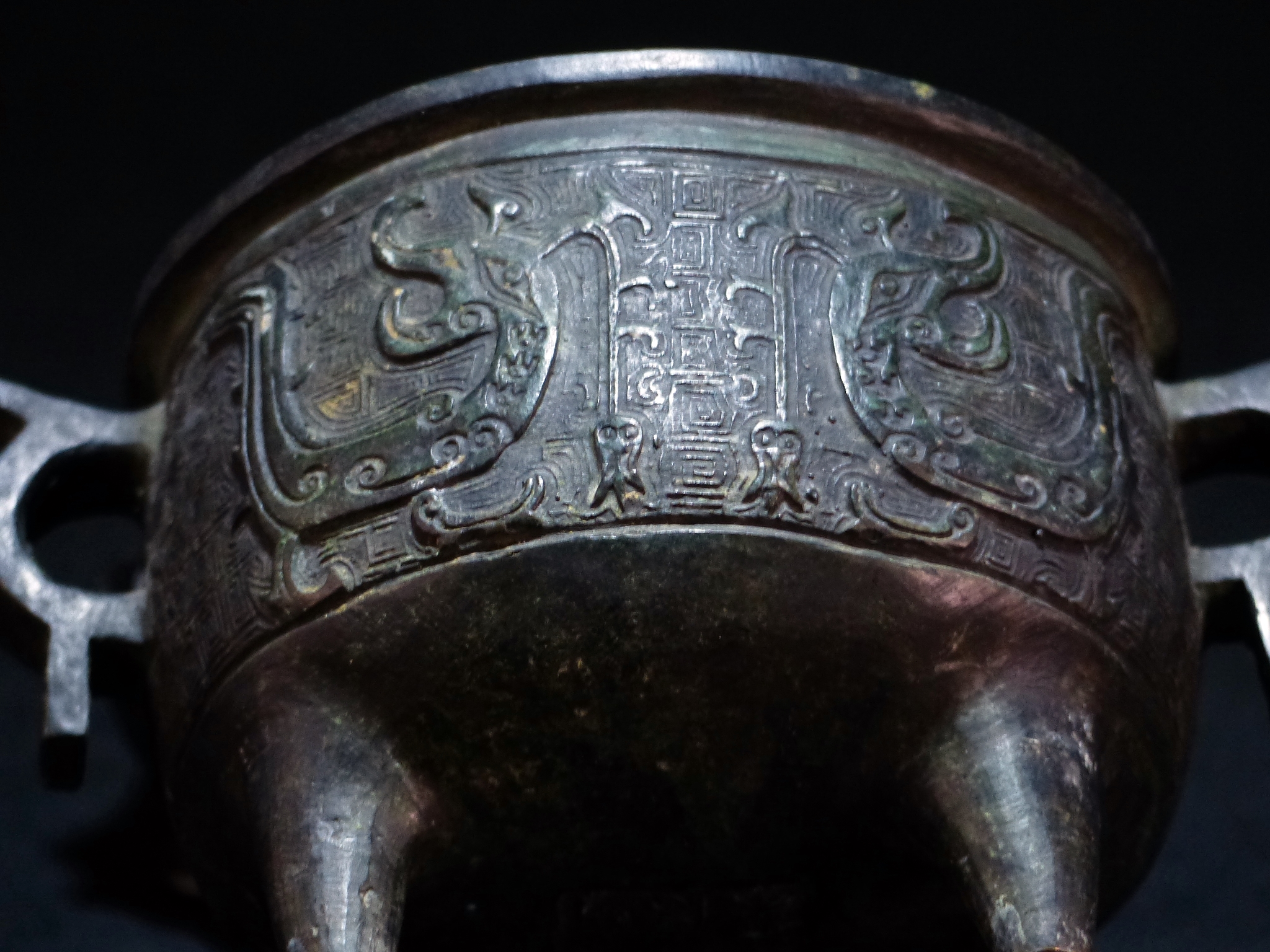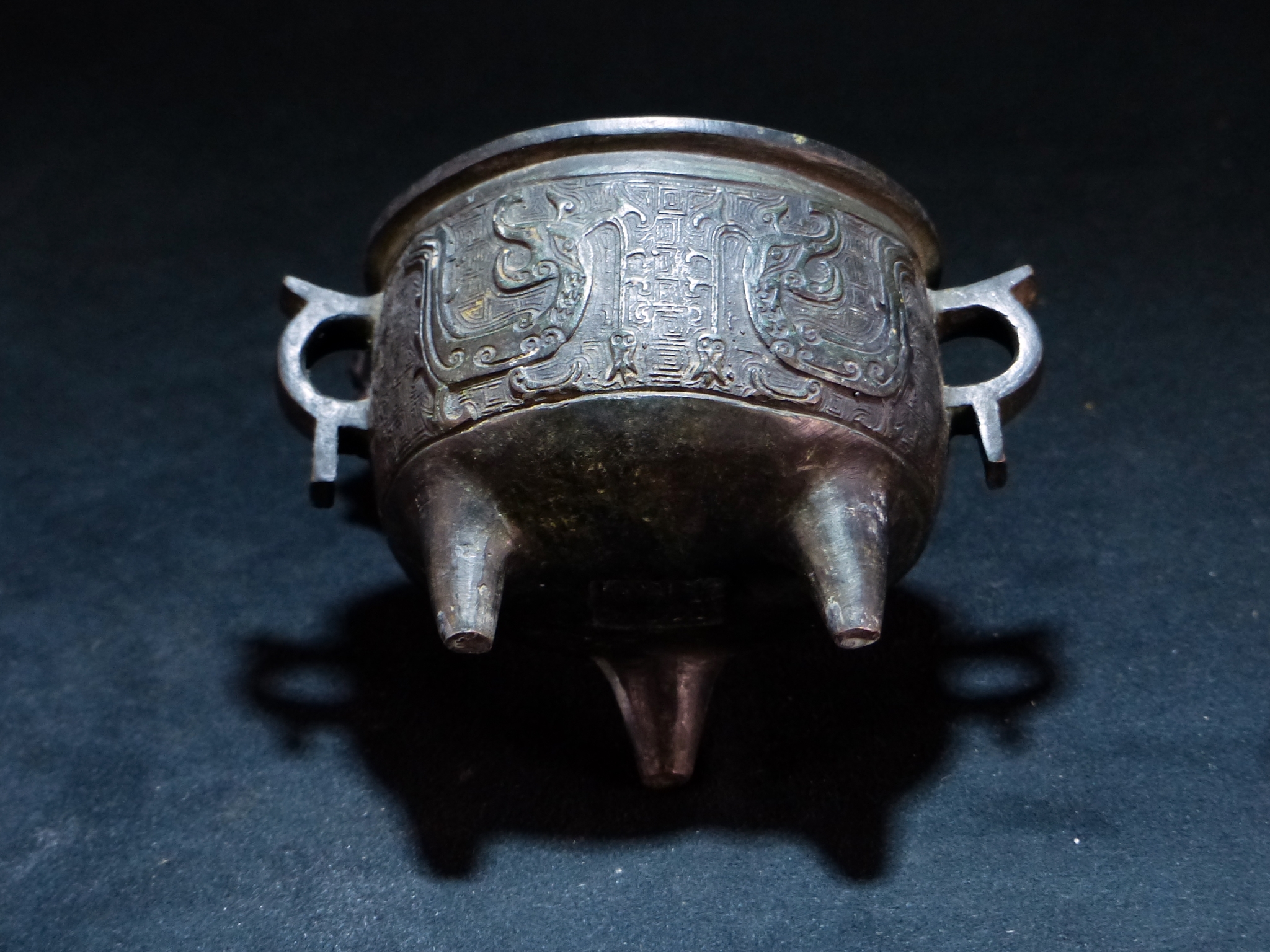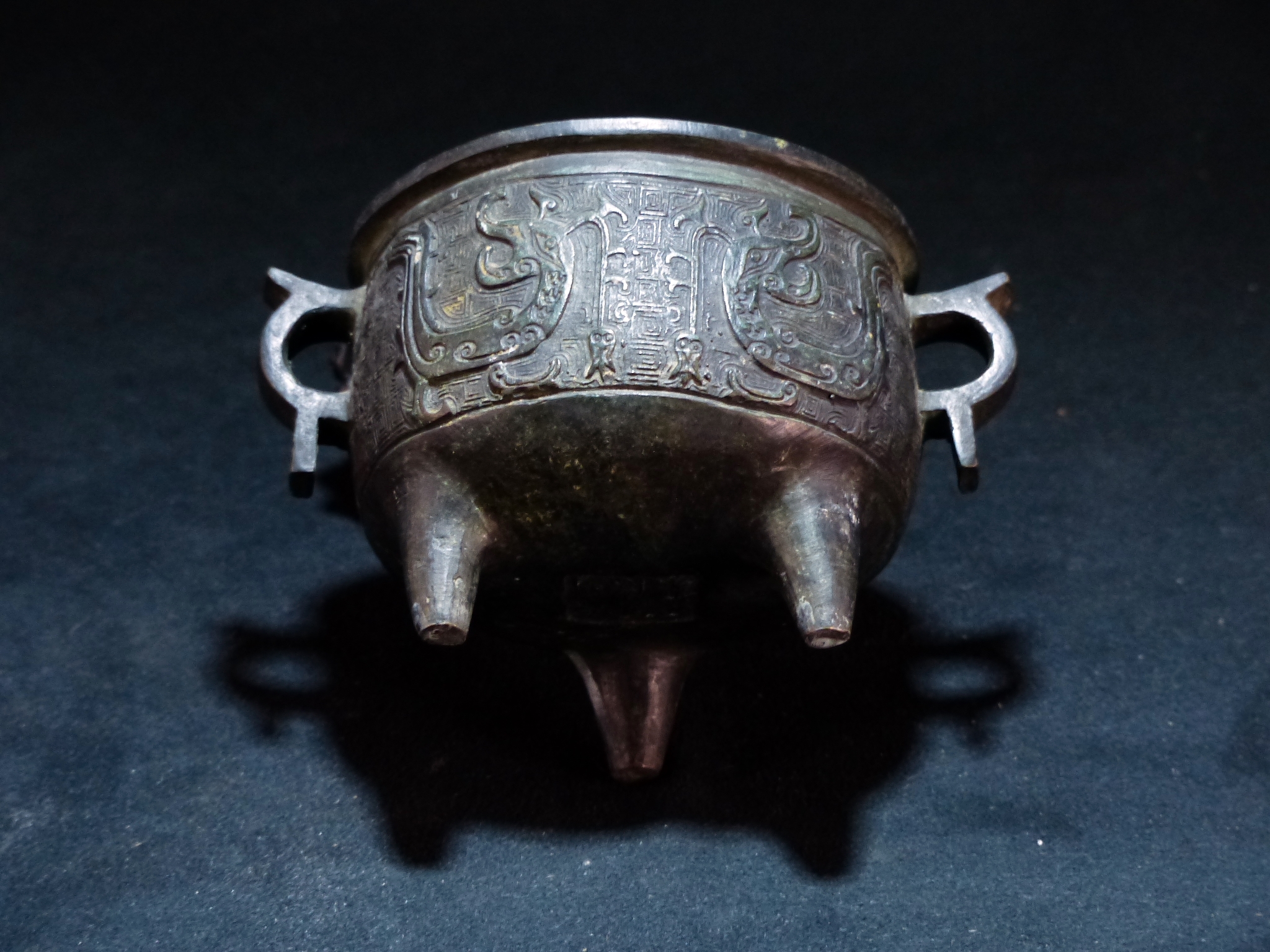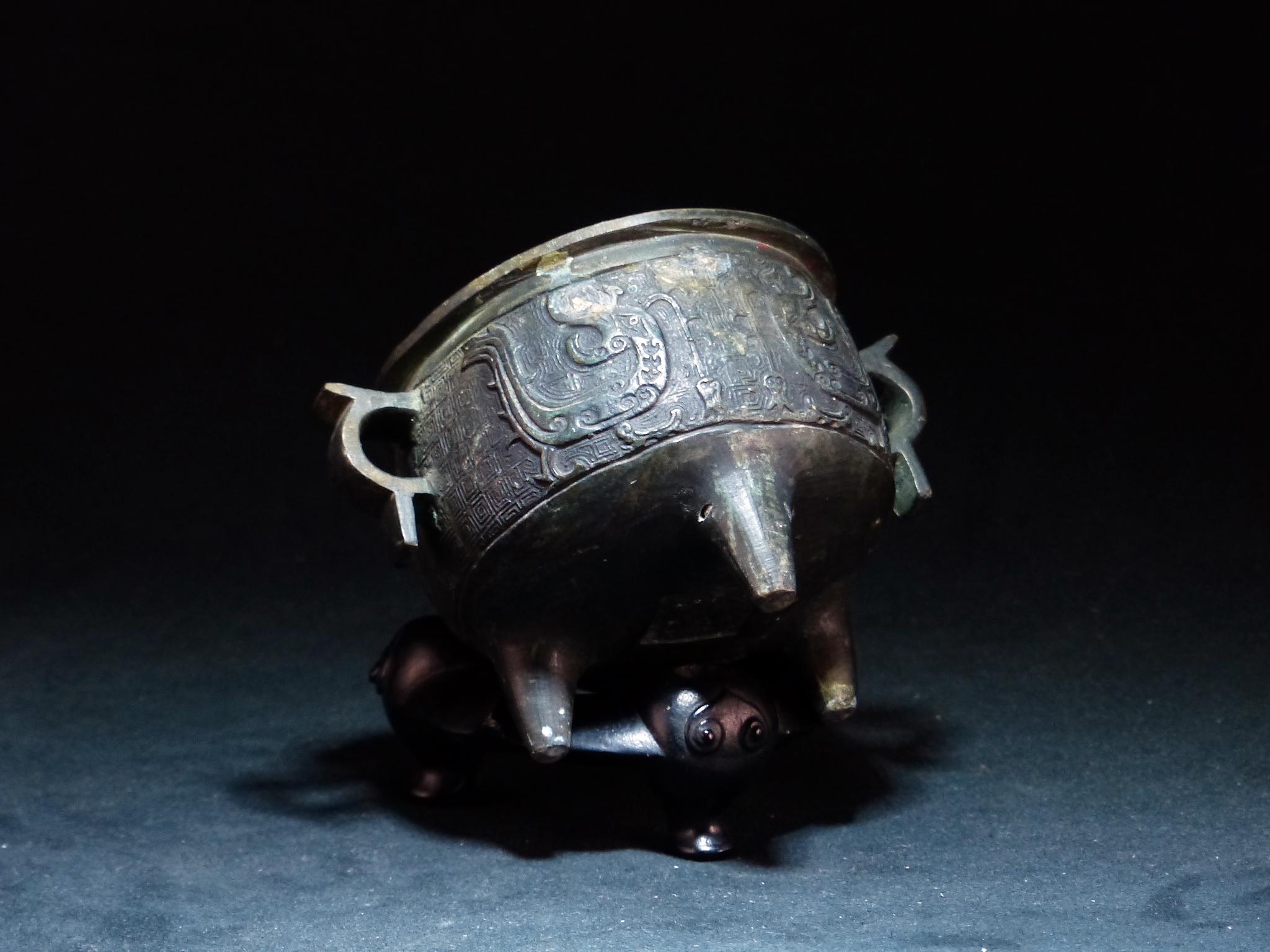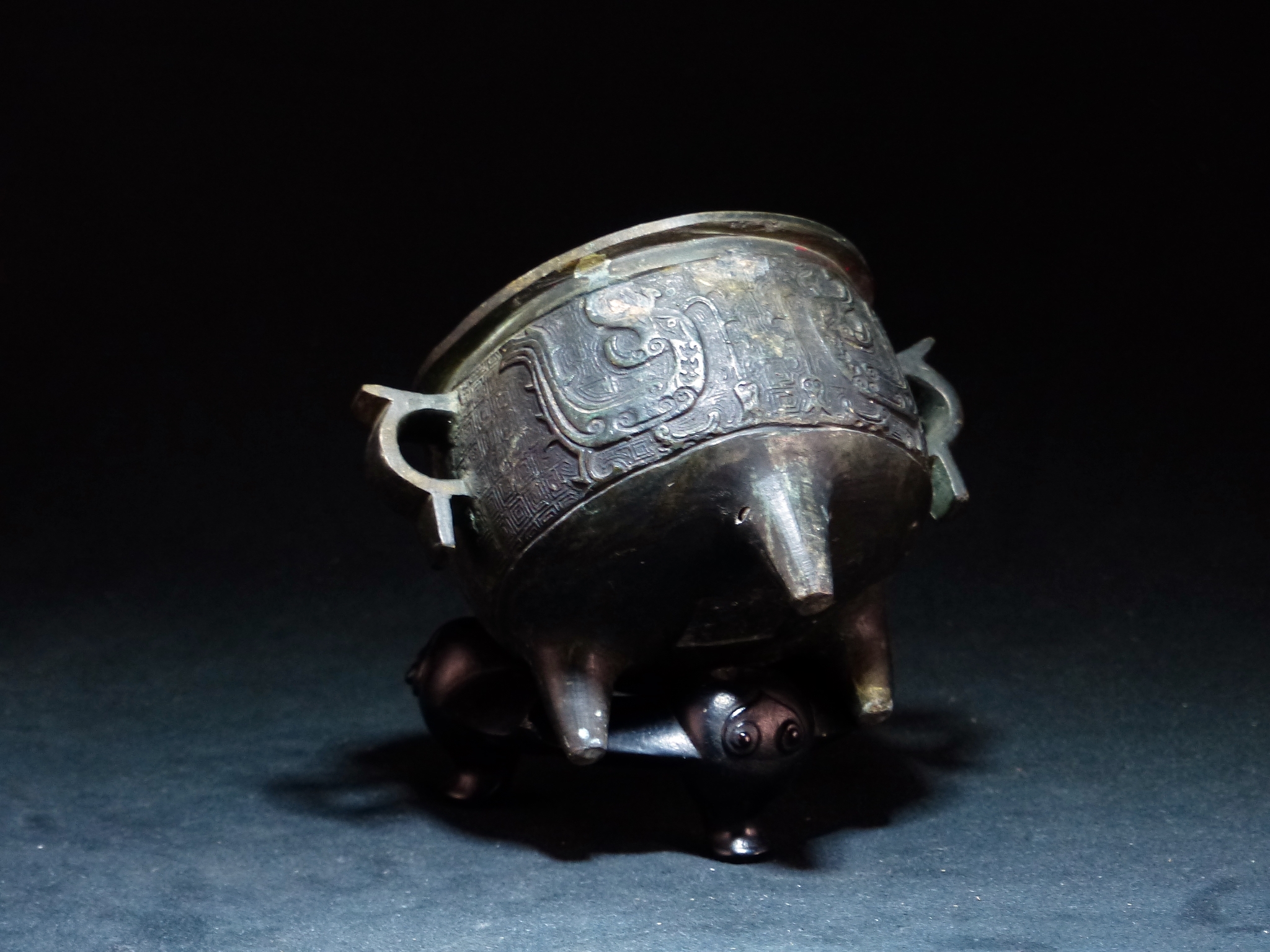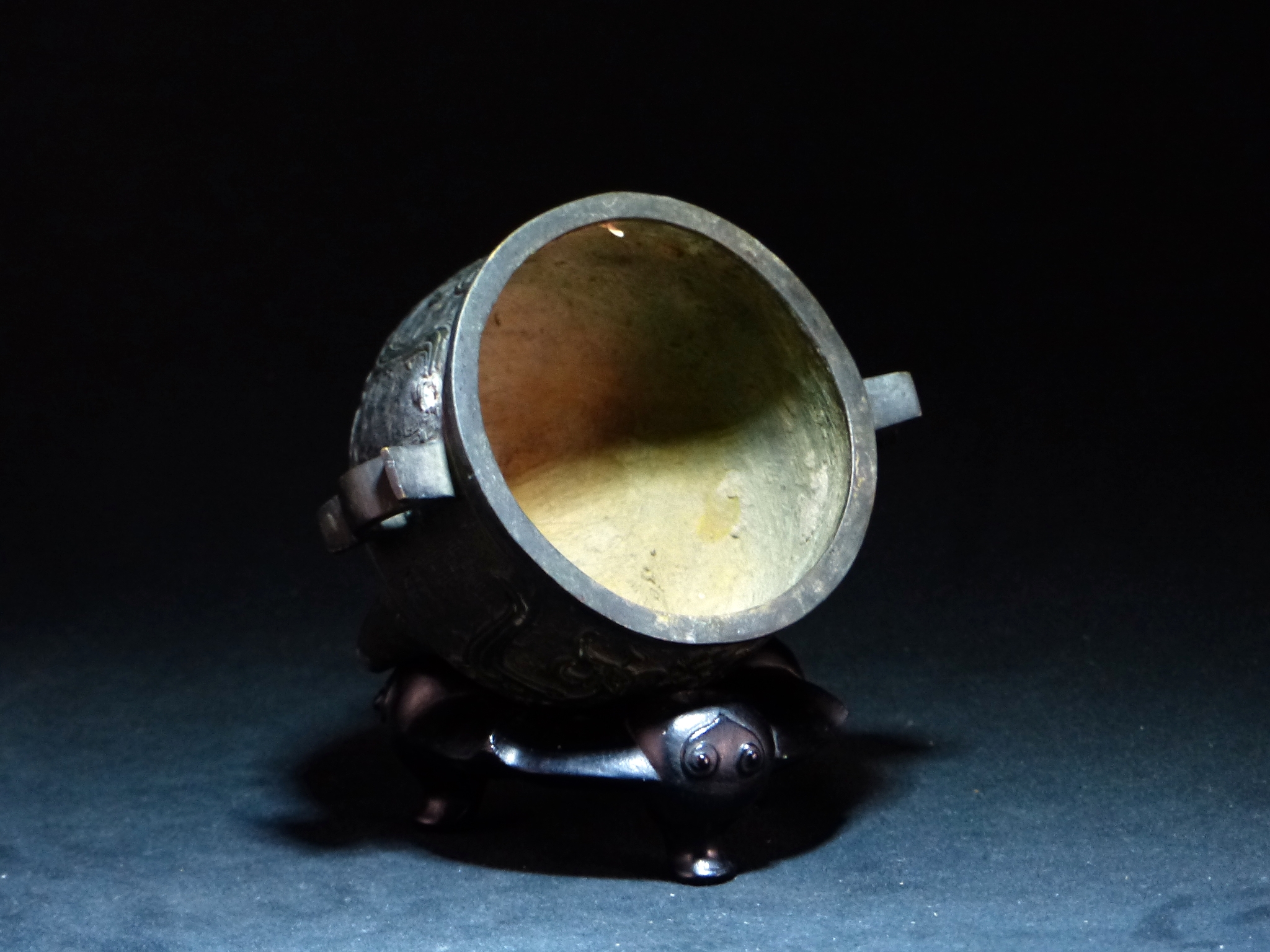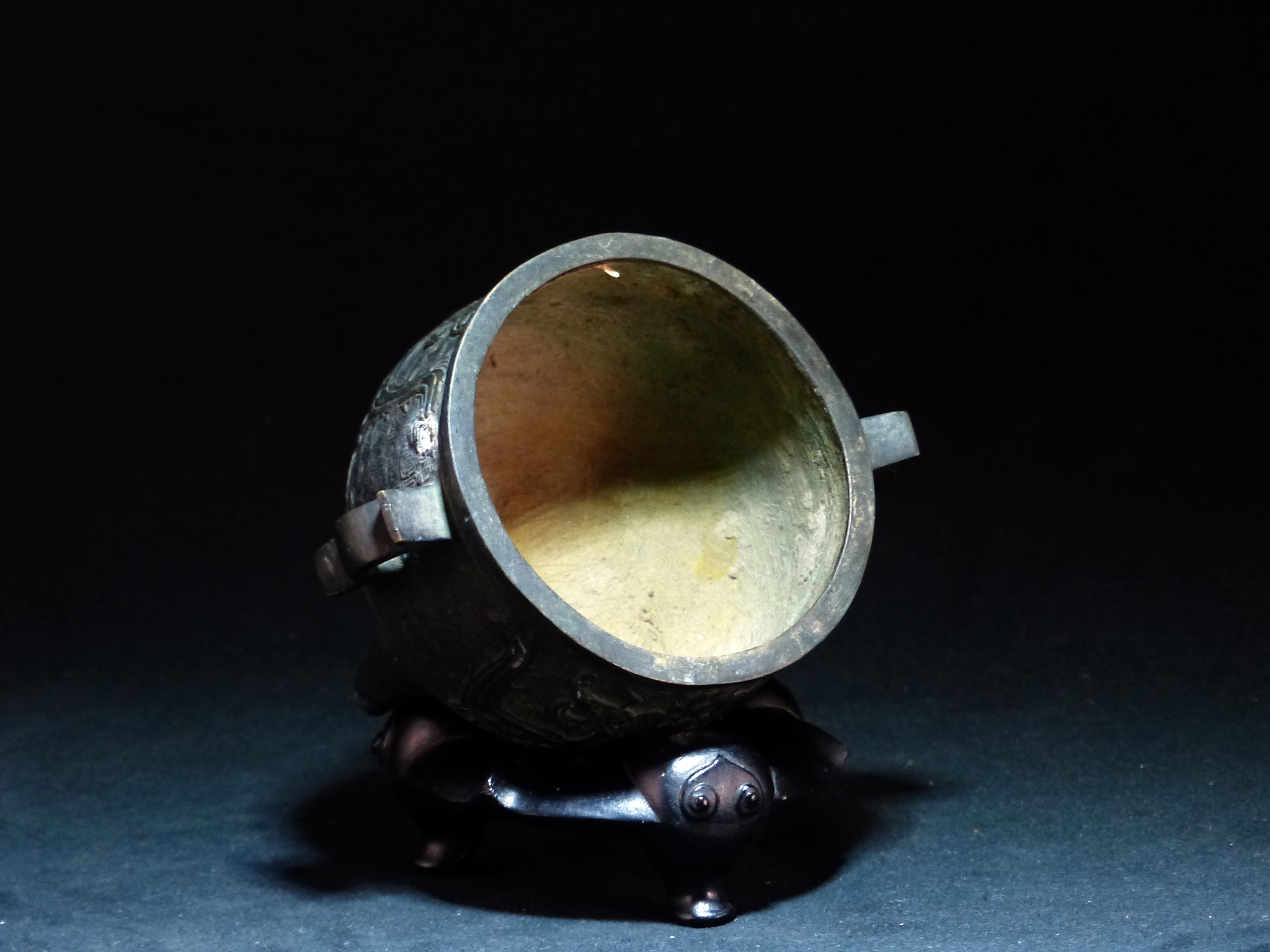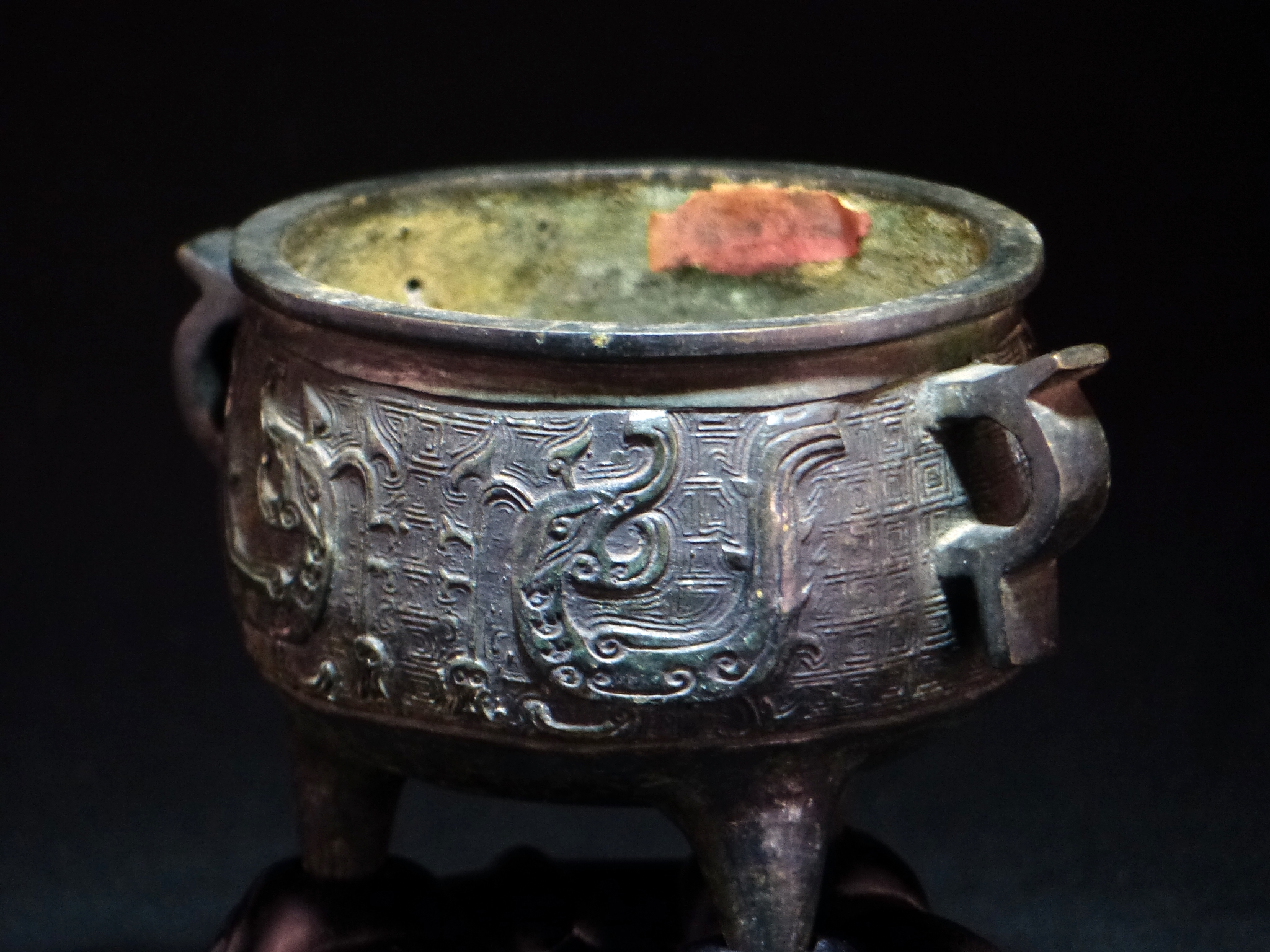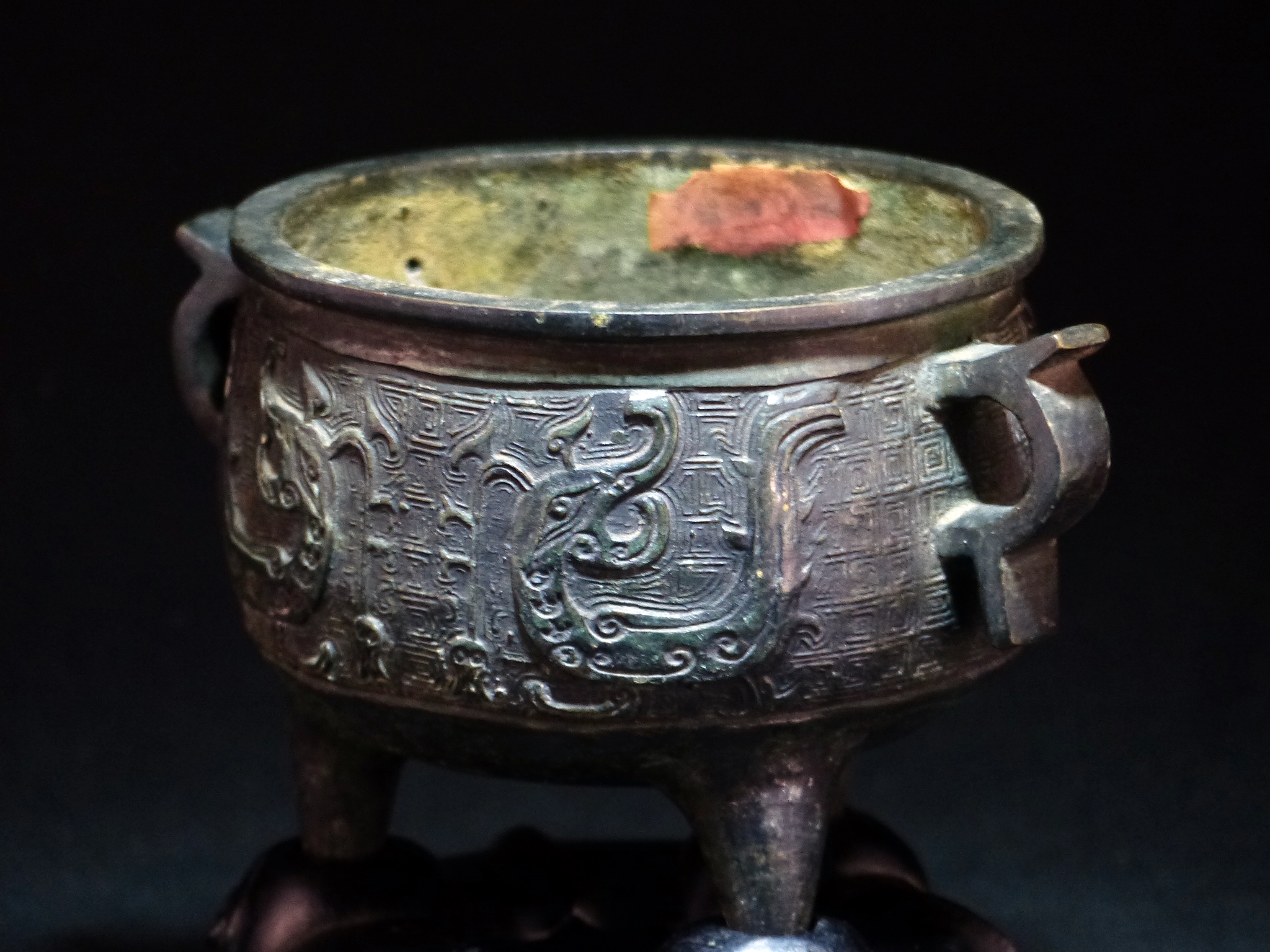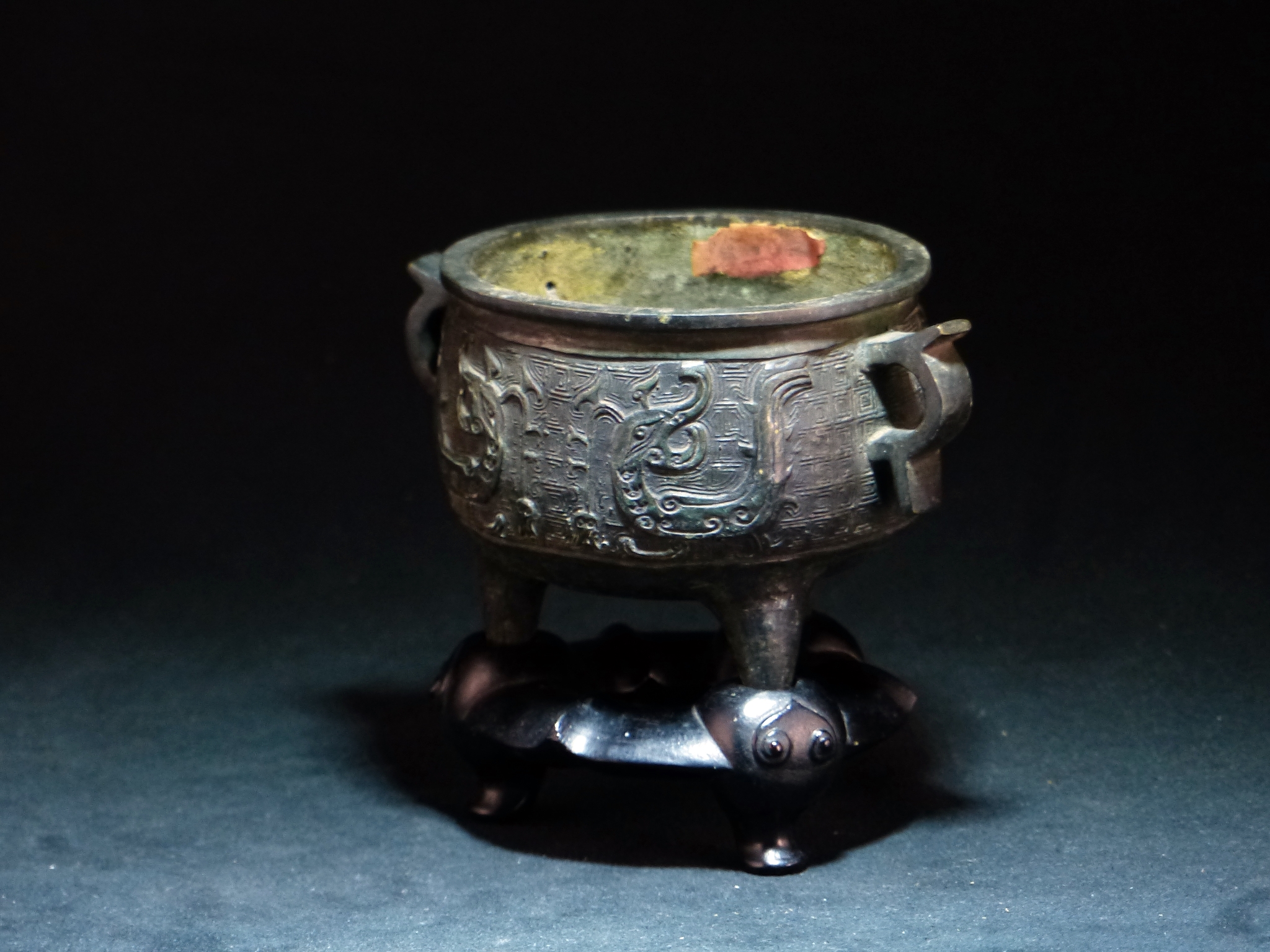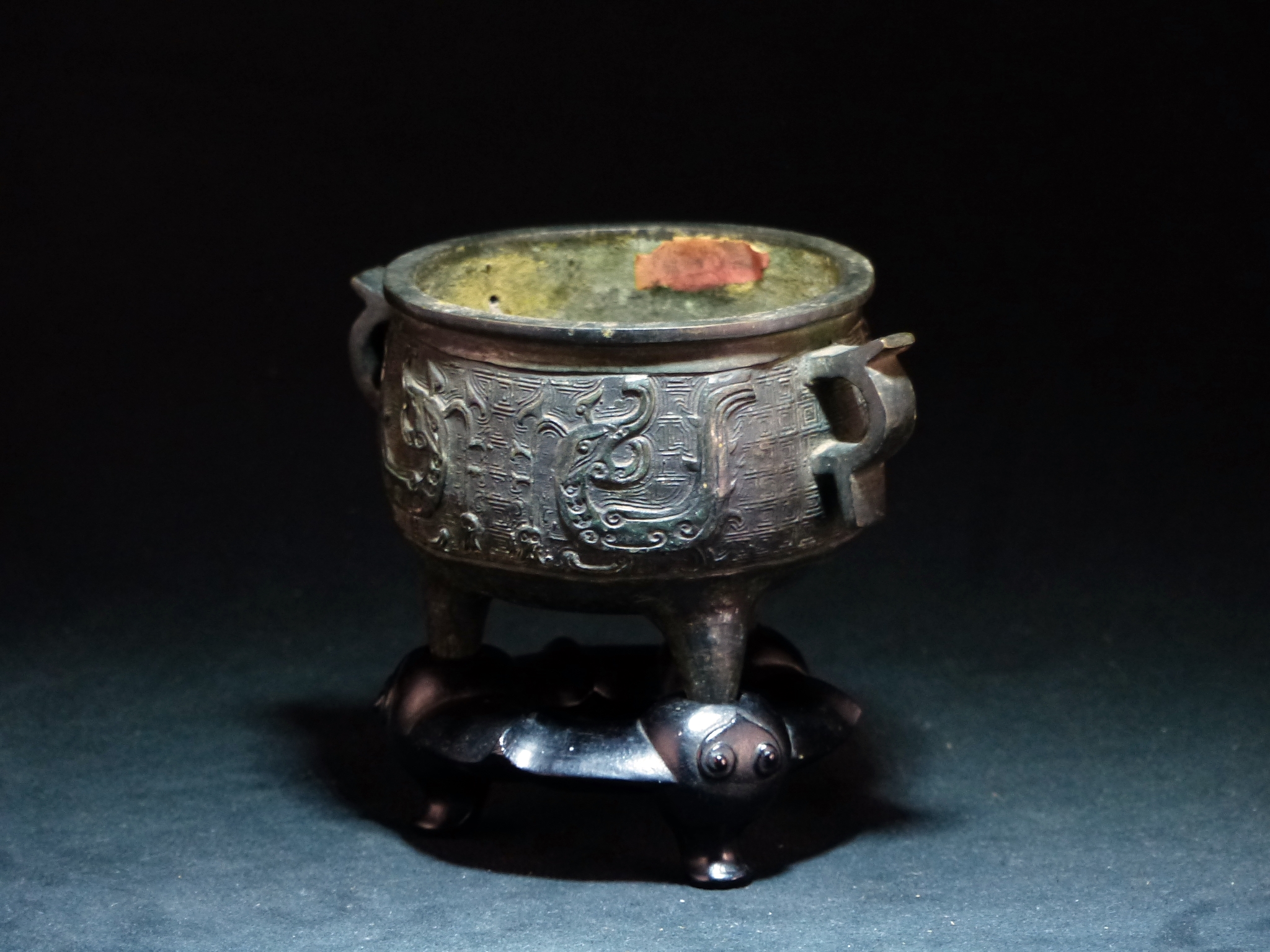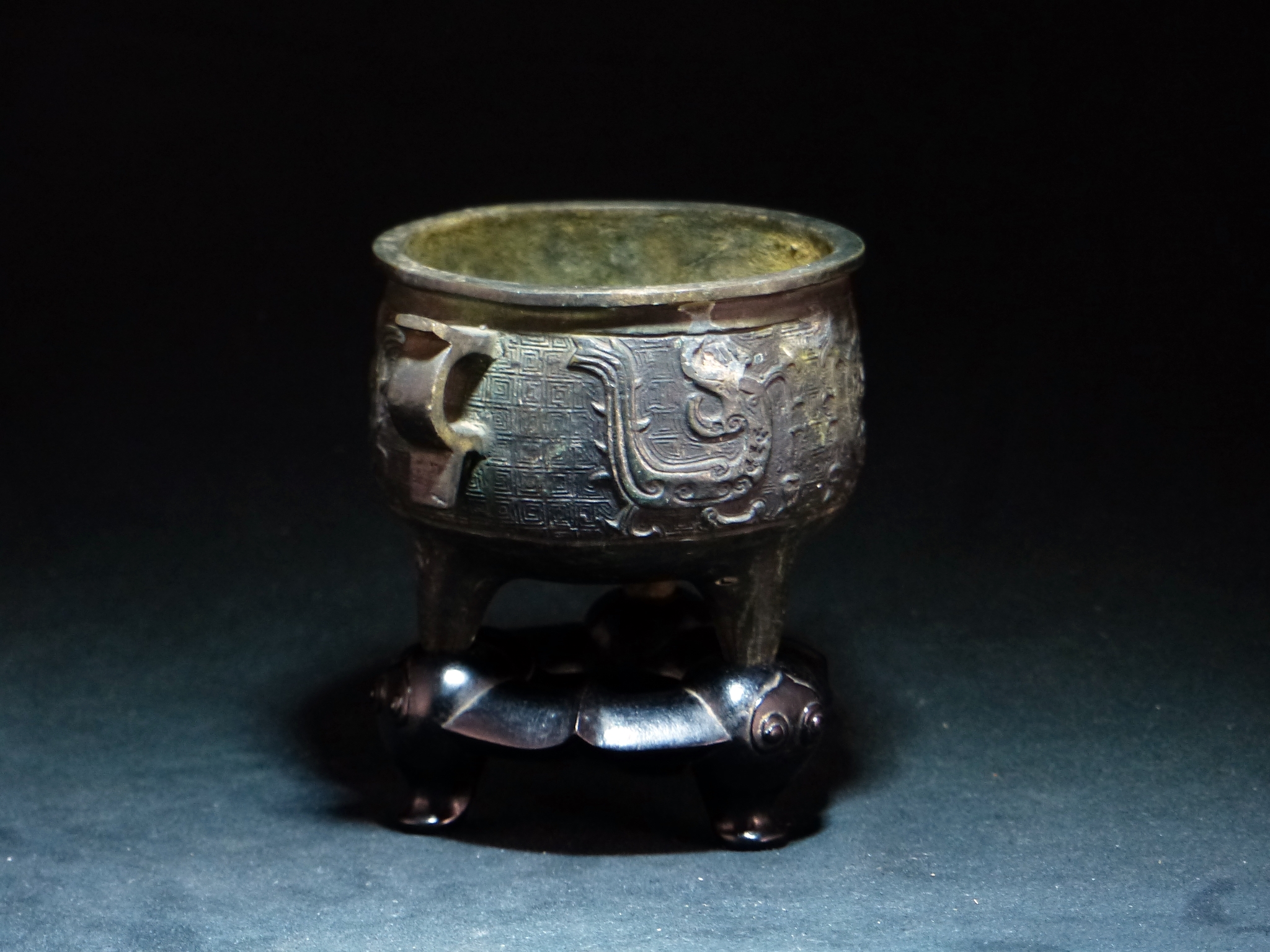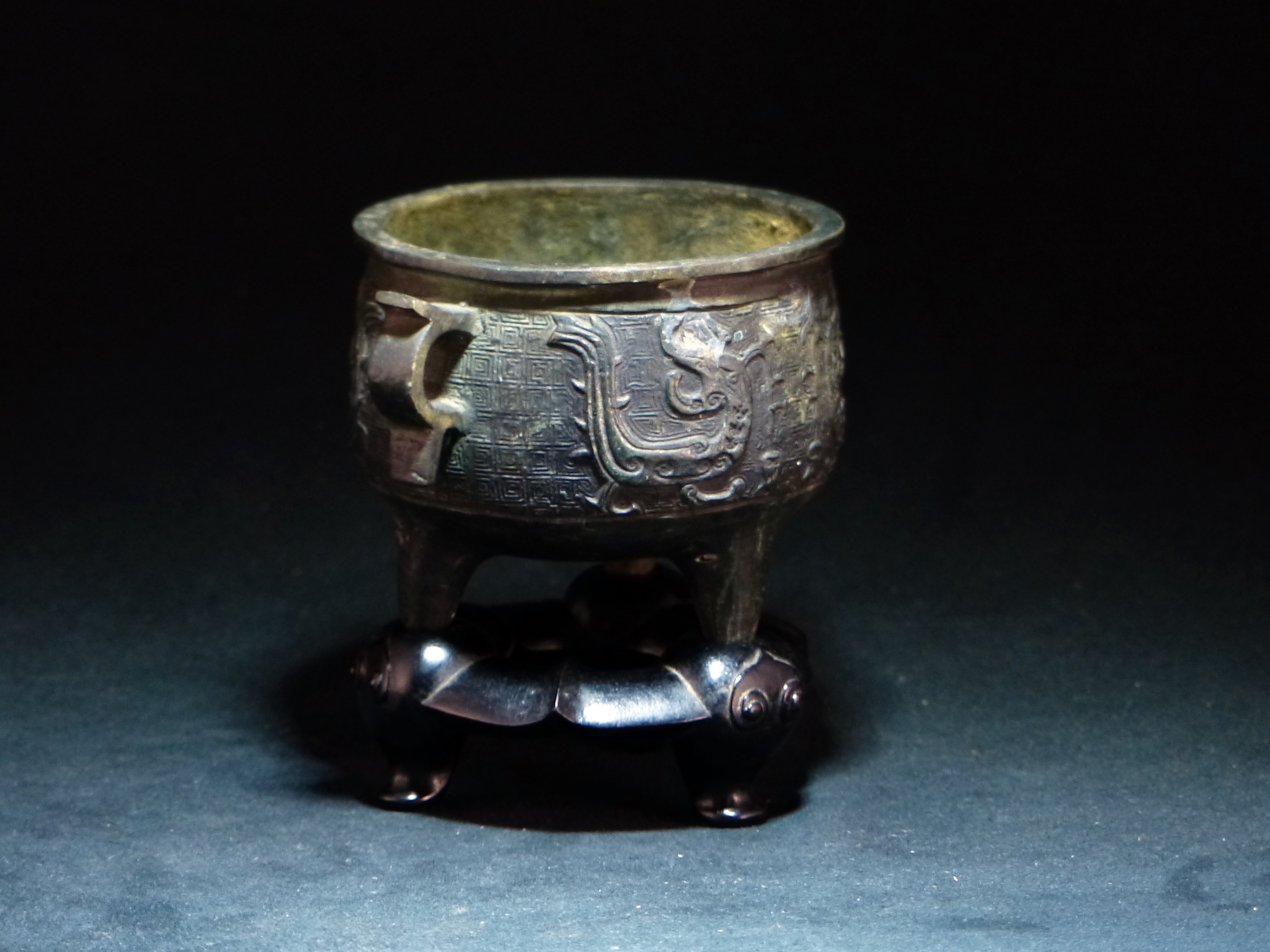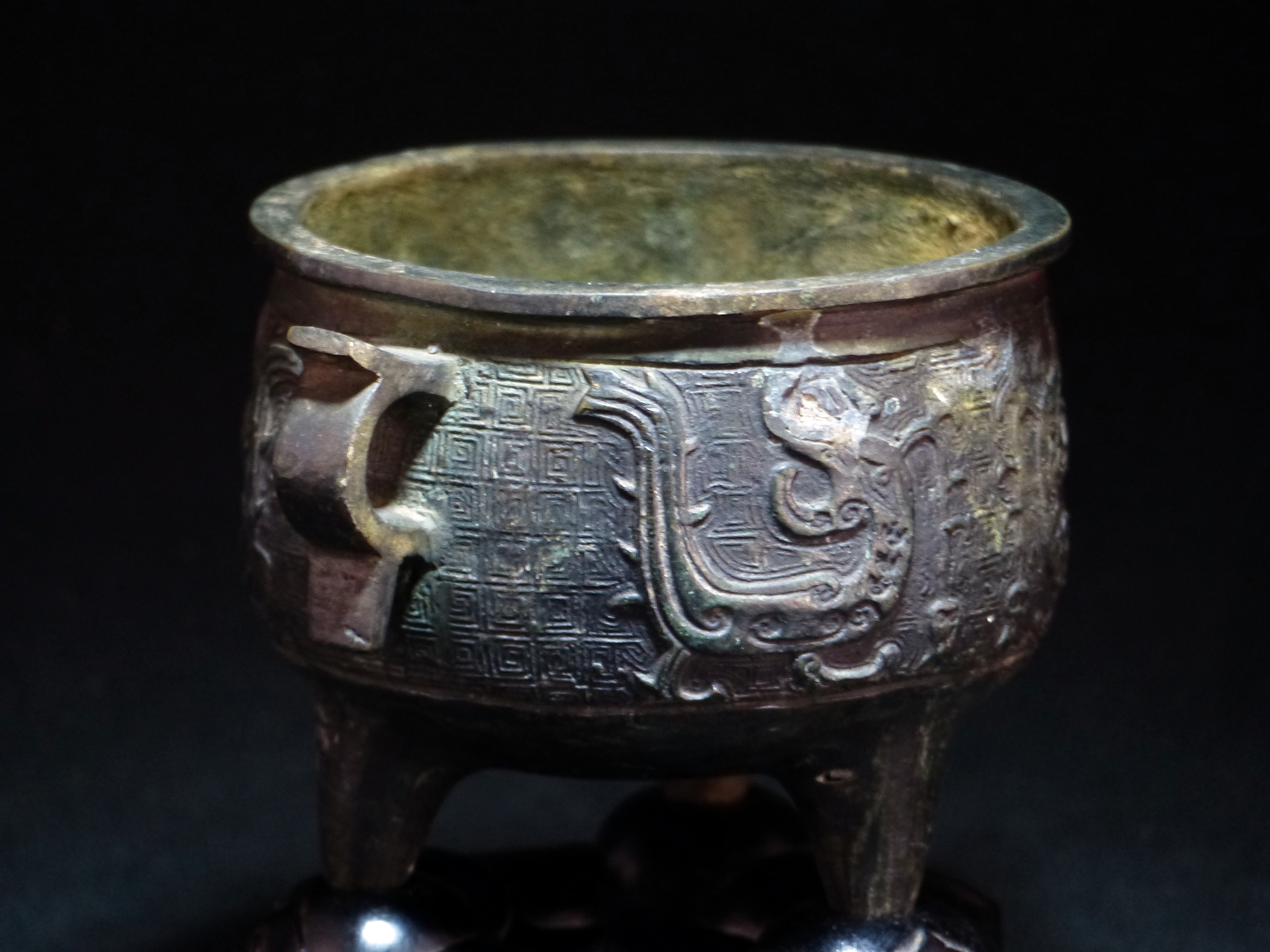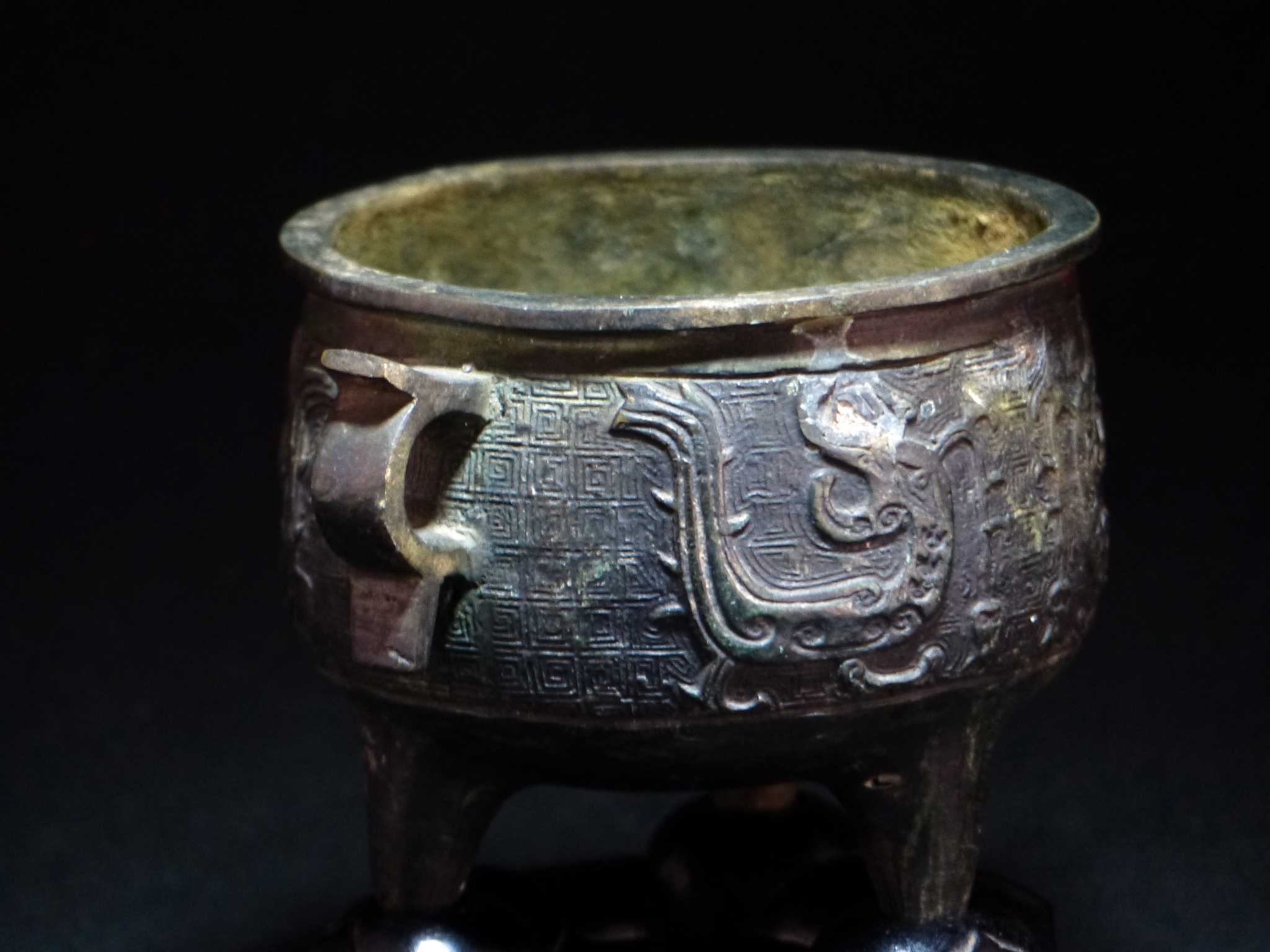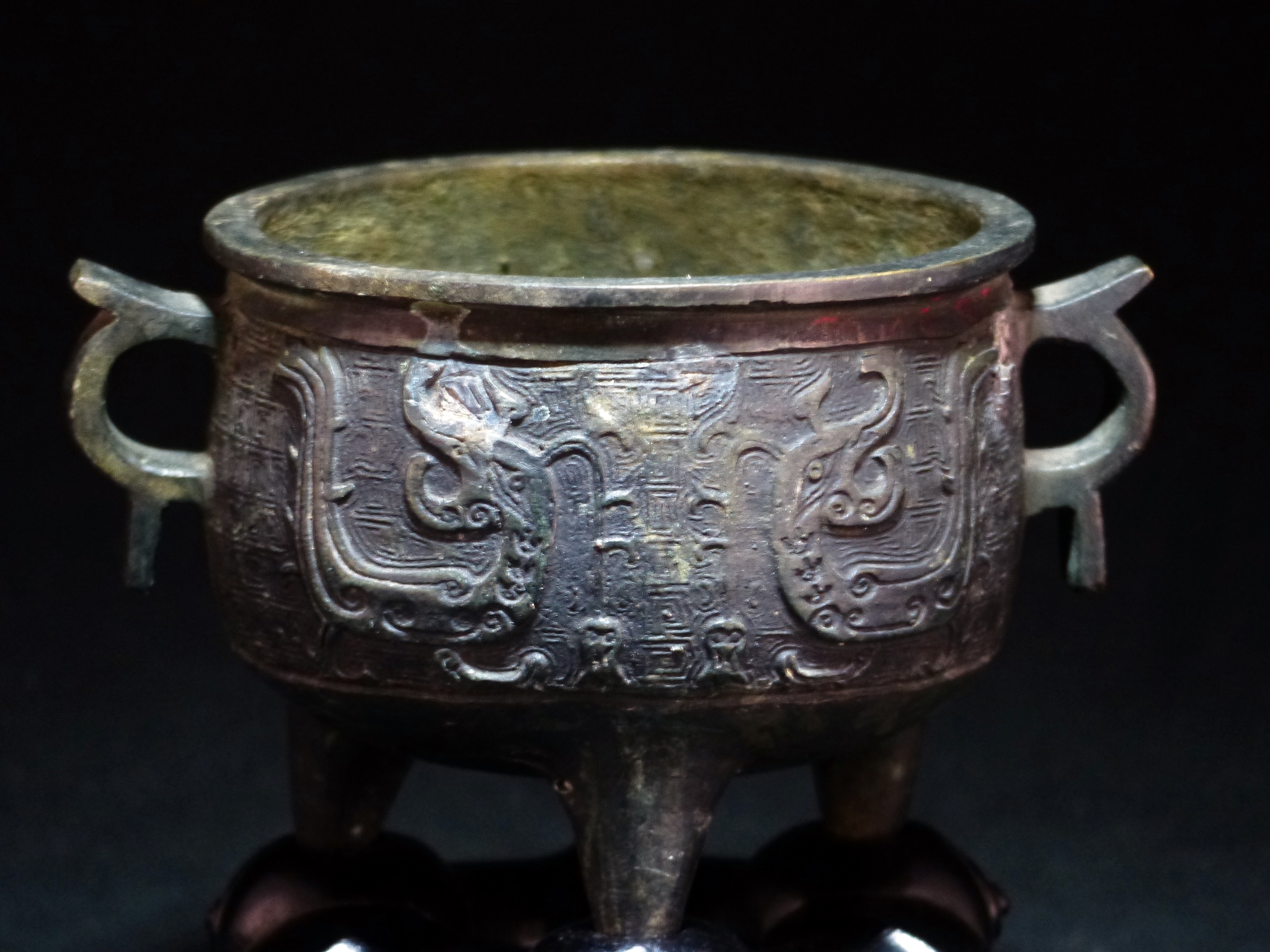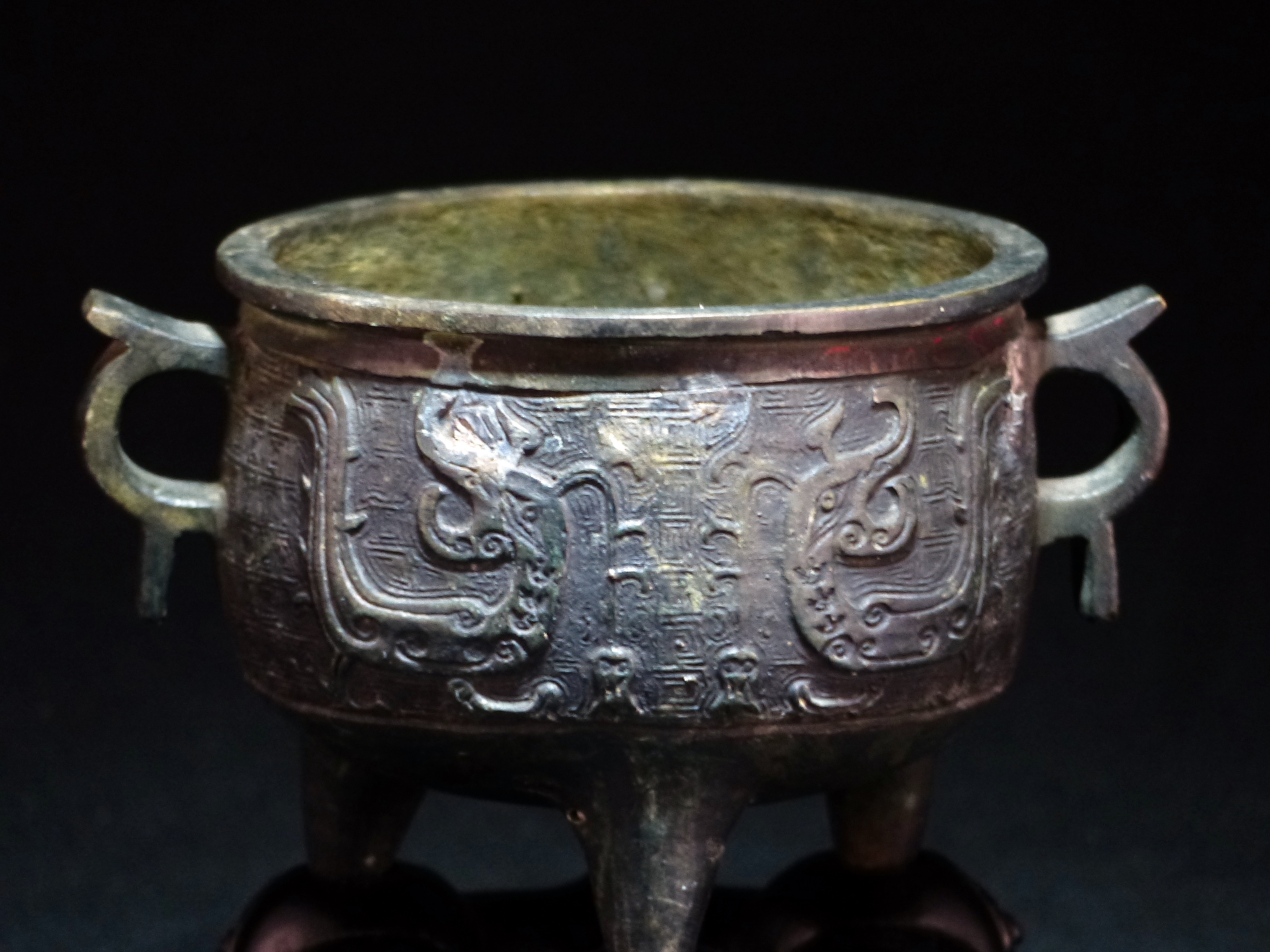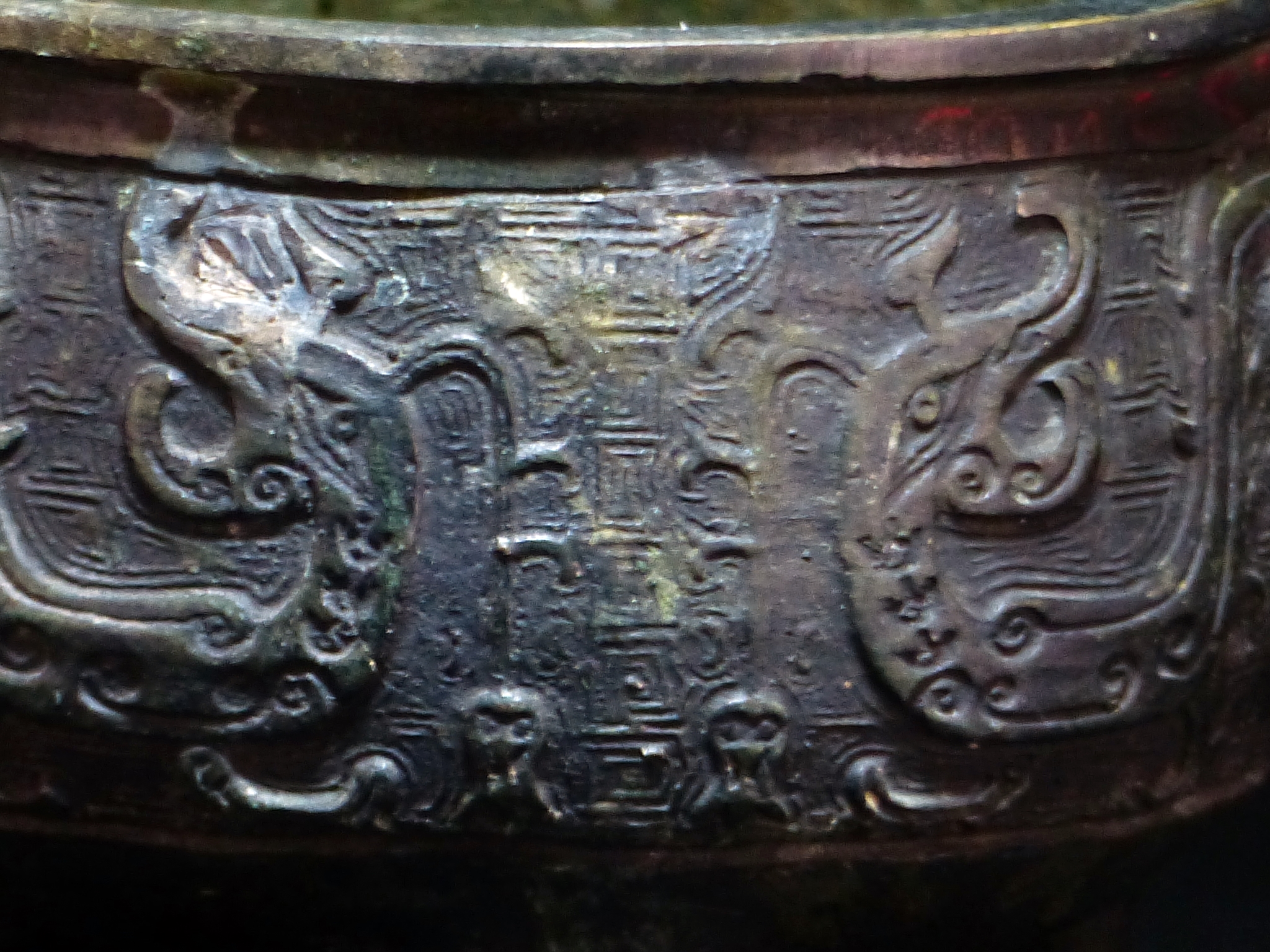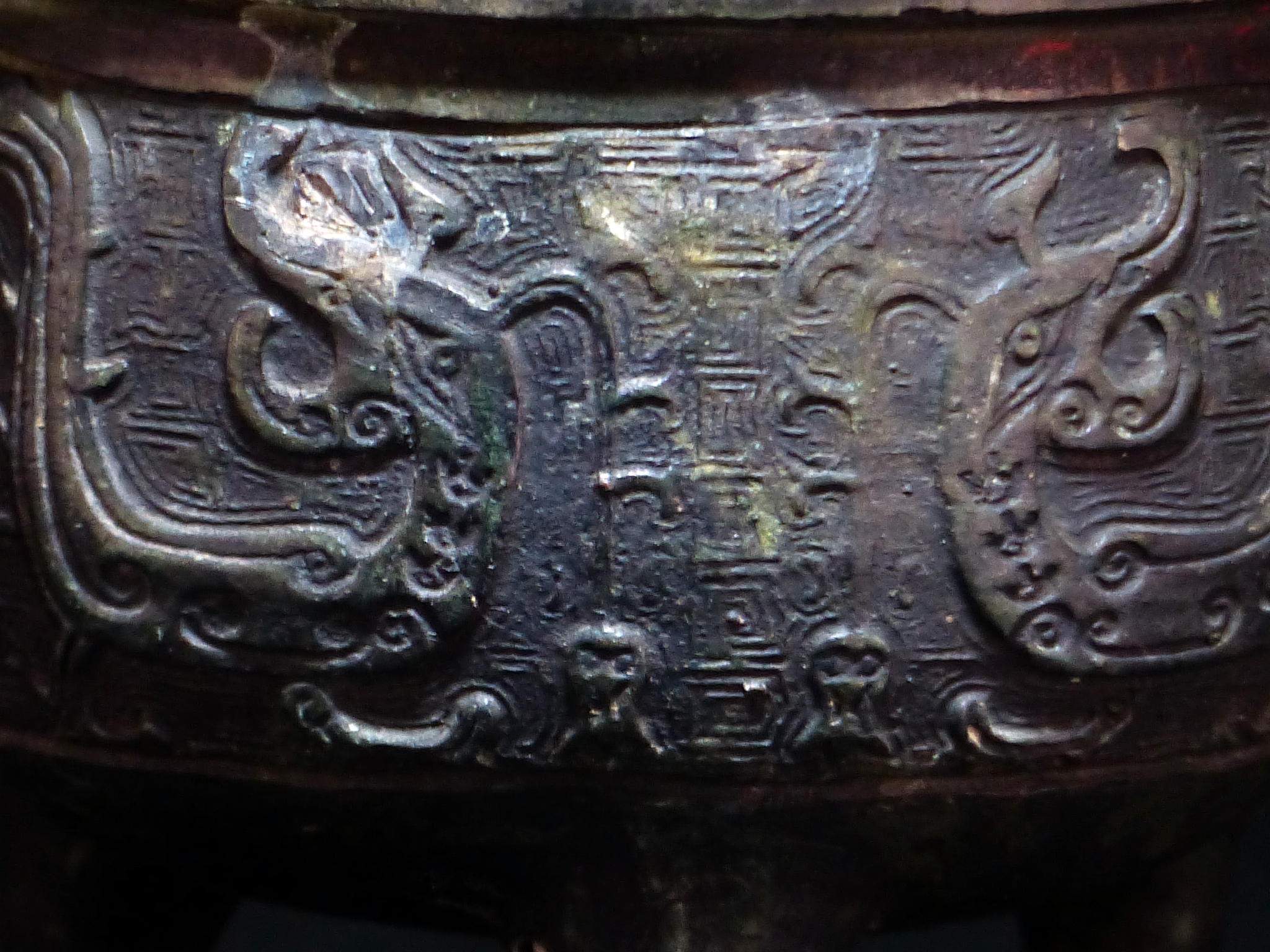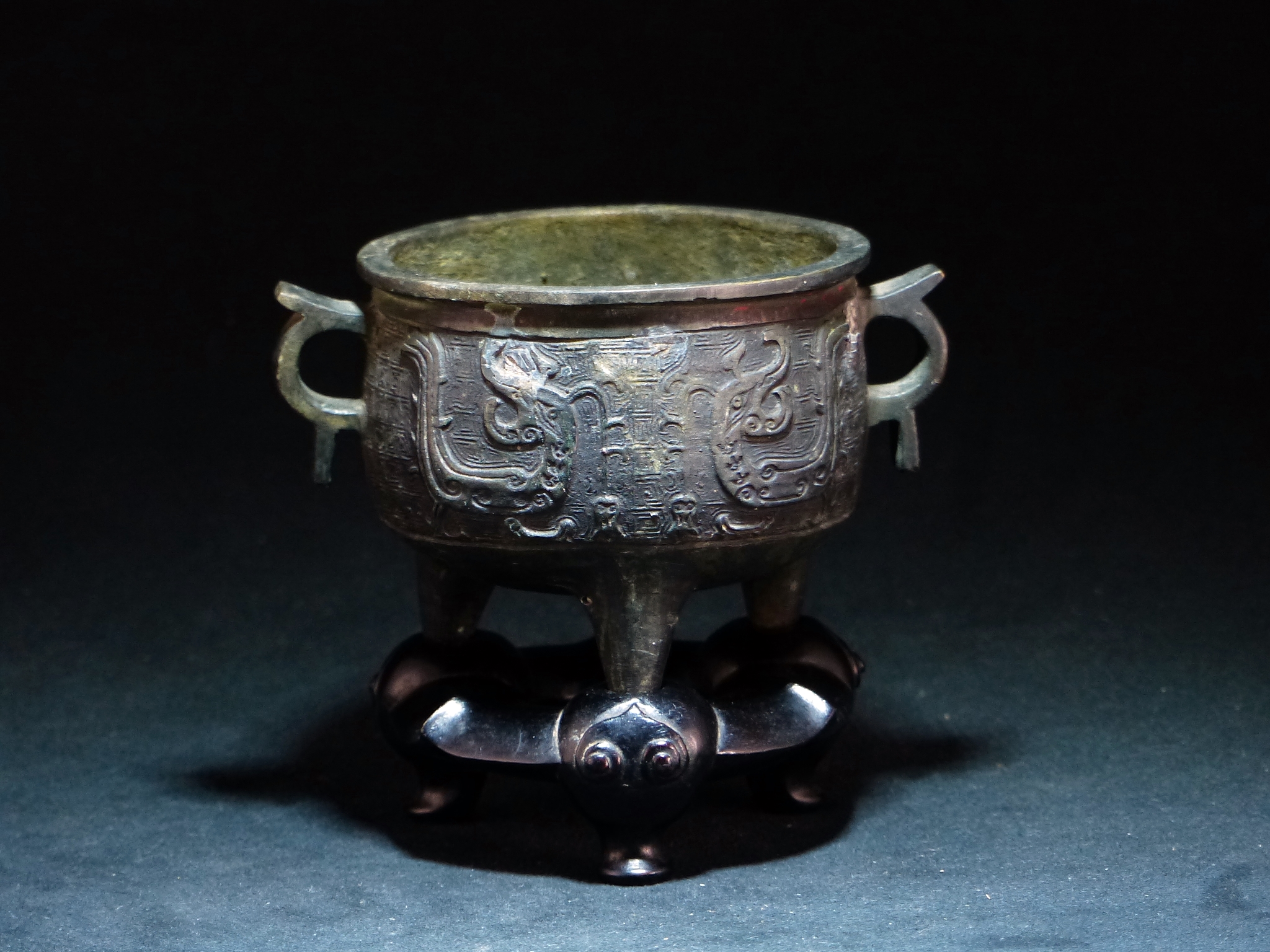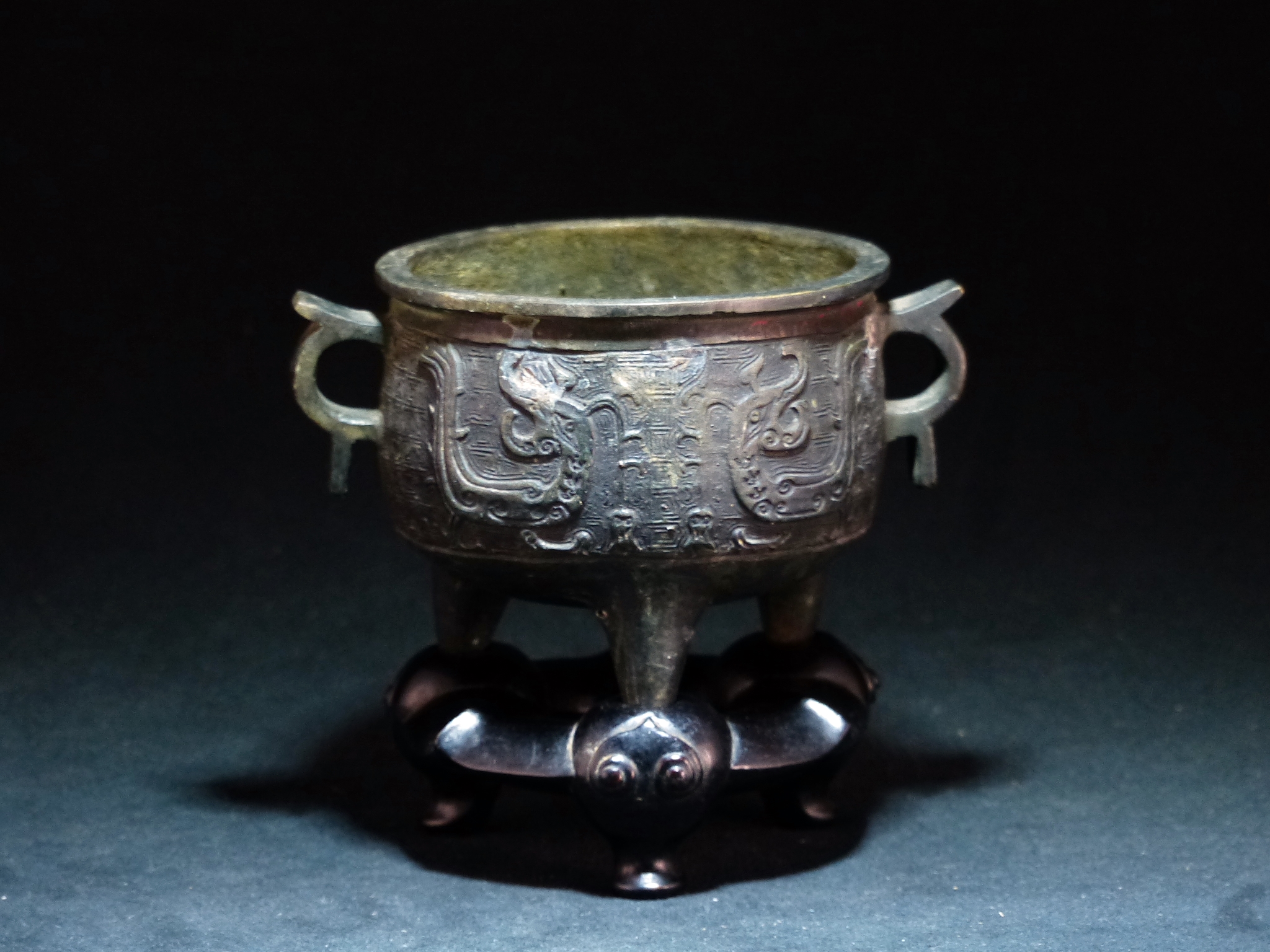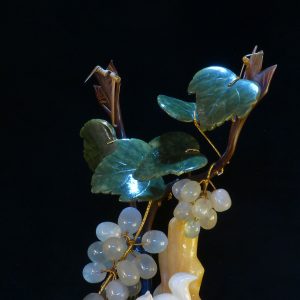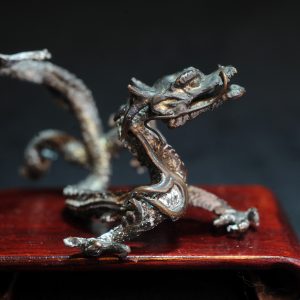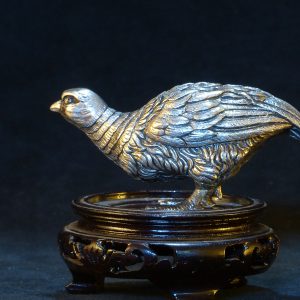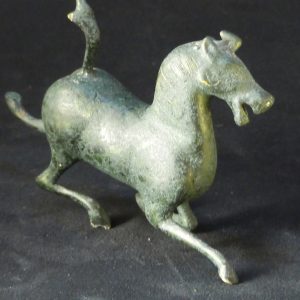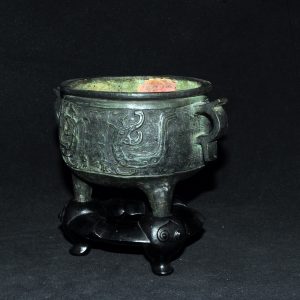Description
明宣德 仿商代 雷云如意凤纹 双耳三足铜香炉
参考:佳士得
18 9月 2014 | 现场拍卖 2872
中国瓷器及工艺精品
拍品 986 晚商-西周 青铜三足鼎
A LARGE BRONZE RITUAL TRIPOD FOOD VESSEL, DING
PROPERTY FROM THE C. PHILIP CARDEIRO COLLECTION
LATE SHANG-WESTERN ZHOU DYNASTY, 11TH CENTURY BC
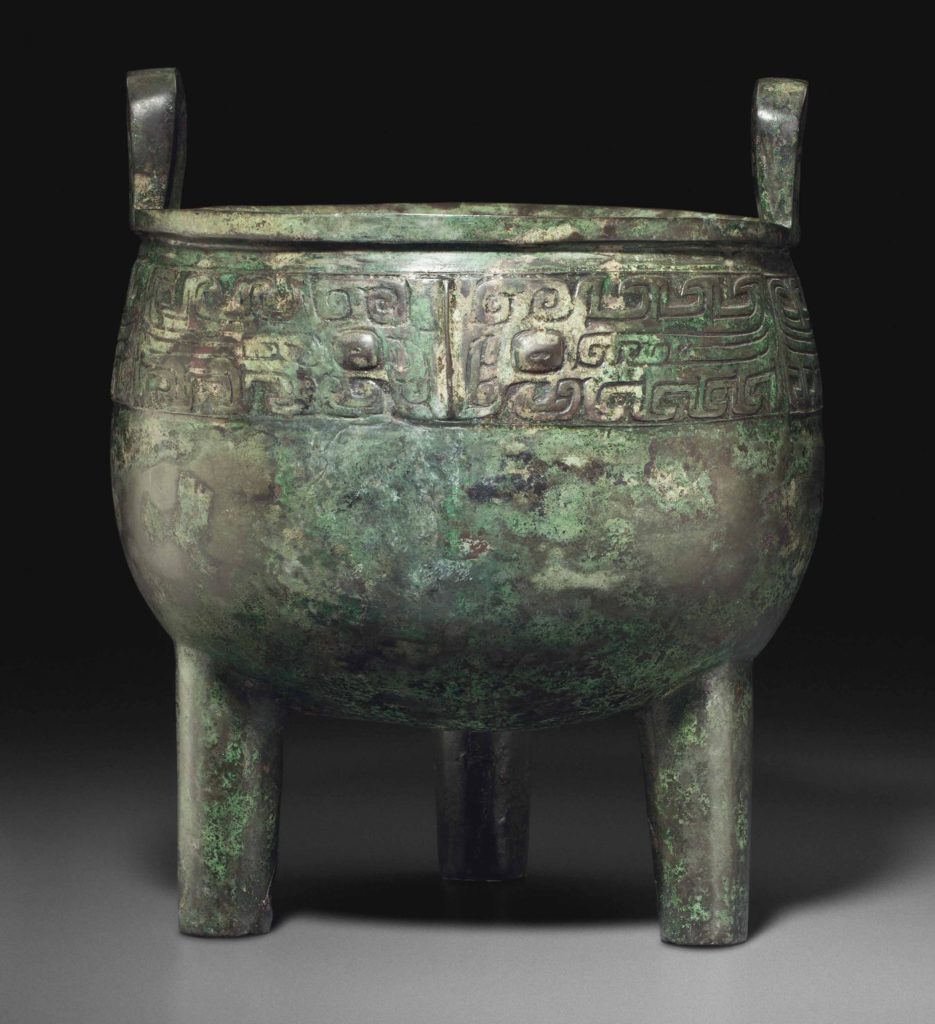
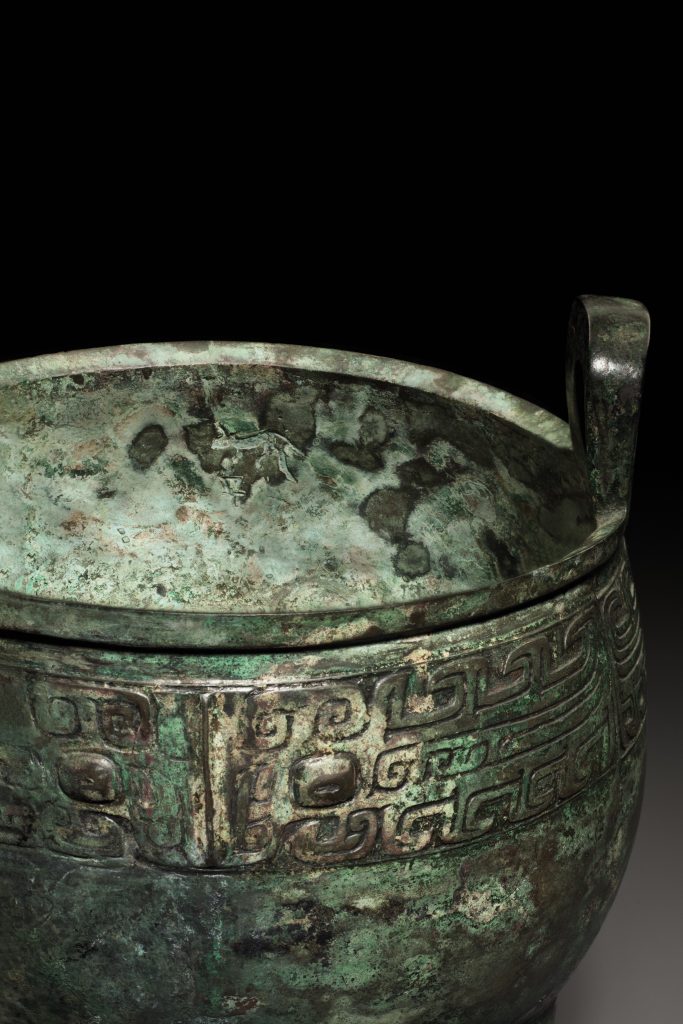
成交价 USD 87,500
估价 USD 20,000 – USD 30,000
A LARGE BRONZE RITUAL TRIPOD FOOD VESSEL, DING
LATE SHANG-WESTERN ZHOU DYNASTY, 11TH CENTURY BC
细节
A LARGE BRONZE RITUAL TRIPOD FOOD VESSEL, DING
LATE SHANG-WESTERN ZHOU DYNASTY, 11TH CENTURY BC
The deep, rounded body is raised on three columnar supports and is flat-cast on the exterior with a band of three taotie masks below the inward-canted rim from which rise two bail handles. The interior is cast with an inscription consisting of an animal oriented above a character, possibly Xin, possibly a family name. The patina is of grey and mottled green color, and there is some encrustation on the interior.
11 7/8 in. (30.2 cm.) high
来源
Private collection, California, prior to 1996.
状况报告
We have sought to record changes in the condition of this piece acquired after its initial manufacture.
– X-rays show a restored area or patch on one side and with an associated break extending from the mouth rim seen under UV inscpection
– possibly another small restoration or patch on another side
– area of restoration on lower body on one side
– possible other areas of restoration detectable under UV inspection
参考:佳士得
8 6月 2021 | 現場拍賣 19974
亞洲藝術
拍品 15
RARE RECIPIENT TRIPODE EN BRONZE, LIDING
商 青銅饕餮紋鬲鼎
CHINE, DYNASTIE SHANG, XIIEME-XIEME SIECLE AV. JC.










成交價 EUR 920,000
估價 EUR 300,000 – EUR 500,000
商 青銅饕餮紋鬲鼎
CHINE, DYNASTIE SHANG, XIIEME-XIEME SIECLE AV. JC.
Hauteur: 20,8 cm. (8 1/8 in.)
來源
1950年代前為日本私人舊藏
Esler Maberley (1897-1977) 先生舊藏,曾擔任世界二次大戰后首屆英國駐日本大使(1952-1957)
倫敦蘇富比,1958年6月24日,拍品90號
H.G.W. Peters先生舊藏,于1958年7月25日購自倫敦古董商Bluett & Sons
美國波士頓藏家S. Feinberg伉儷舊藏,于2004年3月購自倫敦古董商 Eskenazi Limited,后家族傳承
亞洲私人珍藏,購自倫敦古董商Eskenazi Limited
出版
Wu Zhengfeng, ed., Shang Zhou qingtongqi mingwen ji tuxiang jicheng (Shang Zhou Bronzes Inscriptions and Images), volume 2, Shanghai, 2012, p. 221, number 946.
Eskenazi Limited, Room for study: fifty scholar’s objects, London, 31 October-29 November 2019, pp. 44-47, catalogue no.11.
拍品專文
A RARE AND IMPORTANT BRONZE TRIPOD RITUAL FOOD VESSEL, LIDING
CHINA, SHANG DYNASTY, 12TH-11TH CENTURY BC
Liding Sacral Food Vessel with Taotie Décor
商 青銅饕餮紋鬲鼎
Chinese; Shang dynasty, 12th–11th century BC
Cast bronze
The bronze ritual vessels produced during China’s Shang dynasty商代(c. 1600–c. 1050 BC) rank among the finest examples of bronze casting the world has ever seen, as witnessed by this superb liding tripod 鬲鼎. Not only are the forms of Shang vessels intriguing and satisfying, but such vessels exhibit a wealth of complex, integrally cast, surface decoration unknown in bronzes from other civilizations.
A sacral vessel for use in a funerary ceremony, this exceptionally well-cast bronze liding 鬲鼎 tripod has three subtly defined lobes that join and then resolve themselves in the circular mouth rim from which rise two diametrically opposed loop handles. The vessel stands on three long, undecorated, columnar legs. A low-relief taotie mask 饕餮紋 dramatically embellishes each of the vessel’s lobes, the masks centered one above each leg, so that the legs appear to issue from the taotie’s mouth. The taotie masks, whose surfaces are lightly modulated, portray the fierce beast frontally and depict its upper jaw, flared nostrils, prominent nose bridge, bulging eyes, and large C-horns. A pair of downward-facing kui dragons, or kuilong 夔龙, flanks each taotie mask, each dragon presented in profile and shown with a long snout, bulging eye, short body, and upturned tail. The relief decoration appears against an integrally cast background of leiwen 雷纹, or small, squared spirals. The continuous vertical lines that appear at the outside edge of each mask unit not only clearly distinguish one lobe from the next but reveal where the individual mold segments were joined during casting.
Bronze casting came fully into its own during the Shang dynasty with the production of sacral vessels intended for use in funerary ceremonies. Although their exact use remains obscure, such ritual vessels include ones for food, wine, and water; those for food and wine, the types most commonly encountered among Shang bronzes, group themselves into storage vessels, heating and cooking vessels, and presentation and serving vessels. This liding likely served as a vessel for cooking grain, perhaps millet or sorghum, as an offering to the spirit of the deceased, though it might well have been used for serving such an offering rather than for preparing it.
As Robert Bagley has noted, modern authors often characterize lobed vessels such as the present one by the hybrid term liding 鬲鼎 to indicate that it stands somewhere between the tripod li 鬲 and the round, or circular, ding 鼎, both of which were food cooking and serving vessels and both of which trace their ancestry to ceramics from the late Neolithic period 新石器时代. In practice, however, no sharp dividing line can be drawn between li and ding, as examples can easily be found to represent any shape intermediate between those with deep, clearly articulated lobes and those with shallow ones. There is on the other hand a clear-cut distinction between lobed ding and round ding, the distinction emphasized by the different placement of the décor schemes applied to the two shapes. Round ding are typically decorated with taotie masks set between the legs. However, as that placement of the masts is ill-suited to lobed vessels, which have preferred axes aligned with the three legs, taotie masks are centered over the legs of li and lobed ding vessels.
The most important decorative motif on vessels from the Shang dynasty is the taotie 饕餮 mask, as witnessed by this outstanding liding vessel. As seen here, the mask typically boasts a ferocious feline-like face presented frontally; the animal’s body, if depicted, is shown in reduced scale and extends laterally outward from the face. On this vessel, the animal’s body has been supplanted by the pair of downward-facing kui dragons 夔龙 that flank each mask. In rare instances the taotie mask may be presented against an otherwise unembellished ground, but, as here, the mask and other decorative motifs are typically set against an intricate leiwen 雷纹 background. It is likely that the taotie mask and other motifs that enliven these sacral bronzes had meaning for the people of the Shang dynasty; in the absence of contemporaneous written records detailing possible meanings, however, we cannot know precisely what symbolism those motifs might have held, if any. Speculation abounds, but precise identification necessarily must await discovery of hard evidence from the people who created and used them.
The taotie mask appears as decoration on bronze vessels from all periods of the Shang dynasty and even into the early Western Zhou period 西周 (c. 1050 BC–771 BC). That its principal decorative motifs rise in relief against the leiwen background dates this liding to the last phase of the Shang and suggests that it was made at or near Anyang, Henan province 河南安阳, the last Shang capital. The decoration on vessels from earlier in the Shang would not have risen in relief but would have been depicted with linear elements of varying width but still set against a leiwen ground; such vessels would have been more self-contained, their surfaces smooth and their decorative elements flush with the vessel surface. By contrast, vessels from the very end of the Shang would show even bolder designs, the decorative elements rising in even higher relief from the vessel surface, and the taotie masks likely bifurcated by a flange extending from the vessel lip though the center of the taotie and to the top of the associated leg.
Sacral vessels from the Shang dynasty were used in ceremonies honoring the spirits of deceased ancestors. As such, many bear integrally cast, dedicatory inscriptions 銘文 that might include a clan symbol, the name of the person in whose ceremonies they presumably were used, and sometimes other emblems, as well. Such inscriptions’ so-called bronze-script characters 金文 relate to contemporaneous oracle-bone-script characters 甲骨文—that is, characters carved on ox scapulae or turtle plastrons as part of a divination process employed in Shang times—and they are the direct ancestors of modern written Chinese.
Integrally cast with the vessel itself, the inscription on the interior wall of this liding includes three graphs arranged in a vertical column, Fu 父, Gui 癸, and another graph, at the top, whose modern form, pronunciation, and meaning have been variously interpreted. Although some have interpreted the first graph—which superficially resembles a lobed vessel seen in profile and with a “single quotation mark” on either side, just below the top—as the ancient form of the modern character Bing ?, others regard it as a clan sign, or totem, and designate it with a small white square ?, indicating that both its meaning and its pronunciation are unknown at present. The same graph, which appears on a late Shang or early Western Zhou bronze ritual he 盉 wine vessel—the Ran Fu Bing He 盉 —has more recently been read as Ran 冉 and interpreted as a clan sign; from a distinguished European collection, the he vessel sold at Christie’s, New York, in March 2021 (Lot 805). The second and third graphs in the inscription read Fu父 and Gui 癸 and refer to Father Gui; thus, it can reasonably be assumed that the inscription indicates that the vessel was dedicated to Father Gui of the Ran Clan and that it likely was used in his funerary ceremonies.
In terms of casting, unlike the artisans of most early civilizations, who employed the lost-wax technique in casting bronzes, Chinese foundrymen of the Shang dynasty utilized the so-called piece-mold casting technique in producing their ritual vessels, which yielded the exceptional quality evident in this liding. Those early Chinese workers first produced a clay model in the shape of the desired vessel, carving the decoration into the clay model’s moist surfaces, after which the model was fired. Casting molds were prepared by pressing moist clay segments against the fired model; once all had been prepared, the mold segments were fired. In preparing to cast the vessels, the mold segments were properly registered and joined together around an inner core of fired clay. (As previously mentioned, the continuous vertical lines that appear at the outside edge of each mask unit reveal where the individual mold segments were joined together). Once assembled, mold was tightly bound together and inverted, so that the vessel’s legs pointed upward and the vessel lip and handles faced downward, after which the molten bronze was introduced through sprues, or tubular passageways; air within the mold and any gases escaping from the molten bronze vented though a corresponding set of flues. Once the mass had cooled, the mold was removed, releasing the bronze vessel. The inversion of the mold ensured that the molten bronze would reach the very bottom of the mold, so that there would be no bubble flaws on the lip or handles of the finished vessel; any bubbles that did interrupt the surfaces likely would appear as casting flaws on the vessel’s less visible underside and legs.
The advantage of the piece-mold technique is that, unlike the lost-wax technique, it gave the Shang bronze casters direct access to the casting mold’s interior faces, which allowed them to correct any flaws in the decorative designs and perhaps even to embellish them further, which permitted precision casting of exceptionally fine design elements, thus giving rise to the extraordinarily detailed, exceptionally precise designs integrally cast on this bronze. Of course, in the post-casting finishing of the vessels, any adhering mold fragments had to be cleaned from away, and the surfaces had to be polished and, in some instances, touched up a bit. But what must be kept firmly in mind is that the decoration was integrally cast with the vessels themselves, rather than chased or chiseled after casting. The very intricate surface decoration of Chinese bronze vessels, particularly the leiwen, or background patterns perfectly illustrate the sophistication of Chinese casting methods; in fact, they stand in marked contrast to the often smooth, undecorated surfaces of bronzes produced with the lost-wax technique.
This liding was published as early as 1958; moreover, it has an enviable and continuous record of provenance dating back to 1950 and earlier and has been treasured by collectors in England, the United States, Japan, and other East Asian countries. Closely related vessels are in the collection of the Harvard Art Museums, Cambridge, MA (1944.57.19), the Saint Louis Art Museum (288:55), the Arthur M. Sackler Gallery of the U.S. National Museum of Asian Art, Washington, DC (S1987.304), and the Sumitomo Collection at the Sen-oku Hakuko Kan, Kyoto日本京都泉屋博古館的住友家族. Another closely related liding from a Japanese private collection sold at Sotheby’s, New York, on 11 September 2019 (Lot 504). The related vessel excavated in 1990 from Tomb M160 at Guojiazhuangxi, Anyang, Henan province 河南省安陽郭家莊西M160號墓 is now in the care of the Chinese Academy of Social Sciences, Beijing 北京中國社會科學院. Another comparable example is in the collection of the Hunan Museum, Changsha 湖南省博物館.
We appreciate works of art for their beauty and for the invaluable information they convey about the peoples and cultures that produced them. We often forget, however, that many works can tell us as much about a civilization’s level of technological sophistication as about its artistic and aesthetic sensibilities. In particular, those works whose creation required high temperatures, whether for firing, in the case of ceramics, or smelting, in the case of bronze, are true measures of an early civilization’s technological prowess.
Apart from their function as sacral vessels and apart from the information they convey about early Chinese culture, beliefs, and funerary practices, we admire Chinese bronzes for their inventive shapes, bold decoration, and precise casting, as witnessed this superb liding vessel. In fact, it is the precision of the casting, from the majestic vessels themselves to their intricately embellished surfaces, that marks Chinese bronze ritual vessels as truly and wondrously exceptional; in that context, this liding stands as a telling comment on the exceptionally high level of technological sophistication present already in the earliest phases of Chinese historical development.
Robert D. Mowry 毛瑞
Alan J. Dworsky Curator of Chinese Art Emeritus,
Harvard Art Museums, and
Senior Consultant, Christie’s
拍場告示
Veuillez noter que le nom complet du propriétaire de cet objet avant 1958 est Sir Esler Maberley Dening (1897-1977), premier ambassadeur du Royaume-Uni au Japon après la seconde guerre mondiale.
Please note that the actual name of the owner of this item before 1958 is Sir Esler Maberley Dening (1897-1977), first British ambassador to Japan after WW2.
拍品專文
Compare with a very similar piece in the Hunan Provincial Museum, illustrated by Yang Meiki ed., Five Thousand Years of Chinese Art: Shang Chou Dynasty Bronze I, Ting Vessels, Taipei, 1988, p. 10. There is also another very similar example unearthed in 1990 in Guojiachuangxi, Anyang, Henan, now in the Chinese Academy of Social Sciences in Beijing, illustrated by Duan Shu’an, ed., Zhongguo qingtongqi quanji, di 2 juan, Shang 2, (Chinese Bronzes, volume 2, Shang 2), Beijing 1997, p. 59, no. 58. Closely related vessels in museum collections include ones at the Harvard Art Museums, Cambridge, MA (1944.57.19), the Saint Louis Art Museum (288:55), the Arthur M Sackler Gallery of the US National Museum of Asian Art, Washington DC, (S1987.304), and the Sumitomo Collection at the Sen-oku Hakuko Kan, Kyoto.
商 青銅饕餮紋鬲鼎
毛瑞 哈佛大學藝術博物館亞洲部榮譽主任 暨 佳士得高級顧問
中國商代(約公元前1600年至1050年)的青銅器鑄造技術高超,其工藝水平之精湛堪稱世上絕無僅有。此珍稀罕見的商代青銅饕餮紋鬲鼎,充分展現出這時期在鑄造青銅技術方面的卓越成就。商代青銅器不僅造型突出,且表面紋飾細緻繁複,這種鑄造而成的紋飾非常獨特,在世界各地的青銅文化中前所未見。商代的青銅祭祀禮器,展示了中國青銅器鑄造工藝的一個高峰。雖然這些禮器的確切用法仍有待考究,但可以肯定的是,當中有食器、酒器及水器。存世的商代青銅器中,最常見的為食器及酒器,包括用來儲存、溫熱或烹煮食物或酒的容器,以及在祭祀禮儀活動中用來展示及盛載供奉祭品的禮器。
此鬲鼎估計是烹煮黍、稷、稻、粱等穀物的容器,用以供奉祖先,但亦有可能是在祭祀禮儀上盛放祭品的禮器。饕餮紋是商代青銅器的主要裝飾紋樣,也正是此鬲鼎的主題圖案。如此器所示,饕餮紋通常呈現猛獸凶神惡煞的正面面孔。一般而言,青銅工匠若描繪猛獸的身體,會從臉部橫向往外延伸,並按比例縮小來顯示。可是此器的器身卻以一對面朝下的夔龍取代獸身,飾於每個獸面的兩側。沒有多加裝飾的饕餮紋的背景,極為罕見,此器呈現較常見的典型構圖,飾有精細的雲雷紋地,以襯托出獸面及其它紋樣。饕餮紋及其它裝飾圖案使商代青銅器變得栩栩如生,可以推斷這種紋飾對於古人來說甚具意義。但鑑於文獻記錄的不足,迄今無法確定紋飾是否有著特別的象徵意義。大家說法不一,有待考古新發現,讓我們掌握古人應用及創造這些紋飾的理據,才能下定論。
商代古人在祭祀祖先時,會在祭禮儀式中使用青銅禮器。因此,許多禮器鑄有銘文,其中可能包含族徽、儀式中器主的名字,或者其它標誌。這些銘文後人稱為金文,與並行於商代的甲骨文(即當時為占卜而刻寫在牛胛骨或龜甲上的文字)相關,後來逐漸演變成現代漢字。此鬲鼎內壁所鑄的豎寫銘文中,有「父」、「癸」字和另一未解的字。這未解的字是銘文中的首個字,各派學者對此字相對於現代漢字的字形、發音及意義的說法不一:有一說法指這字(看起來像描繪一種容器的側面,並在兩旁加上一對點狀的符號)是現代「丙」字的前身,另外亦有人提出這是族徽或圖騰,並用一白色小方框□來代表這字的含義或發音有待考究。同一字出現在一件晚商或西周早期的青銅盉上,近年被解讀為「冉」字族徽,因此器皿稱為「冉父丙盉」。該盉源自歐洲重要收藏,於2021年3月在紐約佳士得拍賣(編號805)。銘文中的第二和第三個字分別為「父」和「癸」,可以由此推斷,這盉是獻給冉族的父癸,有可能在他的葬禮祭祀儀式中使用。
在鑄造技術方面,商代的工匠運用了陶範法,成功製造出如此鬲鼎般精湛工藝的青銅器,這與大多數其他早期文明工匠所使用的失蠟法截然不同。陶範法比失蠟法優越之處,在於工匠能夠直接在模內修改任何出錯的部分,甚或錦上添花,多加裝飾,鑄造出極其細緻精巧的紋飾設計。此鬲鼎早於1958年便有文獻記載,來源更可追溯到1950年前。此器曾由英國、美國、日本和其他東亞國家多名藏家所珍藏,傳承有序。與此鬲鼎相似的例子存於美國麻薩諸塞州劍橋哈佛藝術博物館(編號1944.57.19)、美國聖路易斯藝術博物館(編號288:55)、美國華盛頓國家亞洲藝術博物館的賽克勒美術館(編號S1987.304)和日本京都泉屋博古館的住友家族收藏。 2019年9月11日,紐約蘇富比拍賣出一相近的鬲鼎,源自日本私人珍藏(拍品504)。
1990年,河南省安陽郭家莊西M160號墓發掘的一例,目前由北京中國社會科學院保存。另有一例現存湖南省長沙市的湖南省博物館。中國青銅禮器在古代有實際的祭祀用途,現在更是藝術遺產的瑰寶,這些禮器使我們能進一步了解中國的古代文化、信仰及祭祀儀式。
此外,中國青銅器創新的造型、大膽的紋飾及細密的鑄造技術,令人讚嘆傾倒。極其精準的鑄造工藝,製作出端莊瑰麗的器形及巧奪天工的紋樣,獨具特色。此難能可貴的鬲鼎,足以印證中國最早期的青銅器鑄造工藝,己臻鬼斧神工的境界。
参考:佳士得
29 5月 2012 | 現場拍賣 2915
重要中國瓷器及工藝精品
拍品 4131
A RARE ARCHAIC BRONZE TRIPOD CENSER, DING
商晚期 青銅獸面紋鼎
LATE SHANG DYNASTY (1600-1100 BC)

成交價HKD 4,580,000
估價HKD 2,800,000 – HKD 4,000,000
細節
商晚期 青銅獸面紋鼎
鼎厚唇,深圓腹,立耳,下承三圓柱足。腹部雷紋地上出六扉棱,口沿下飾一道鳥啄龍紋,兩兩相對;龍紋下飾大獸面紋,有眉有角,雙眼圓凸。
此器紋飾尤為突出,共分三個層次,獸紋眼珠和扉棱為最突出的上層,主紋飾為第二層,地紋為底層。三層紋飾互相呼應,極富立體感,反映出工匠高超的水平和細密的心思。此器線條清晰流暢,保存完好,甚為珍貴。類似紋飾可參照上海博物館的史鼎,惟該器頸腹的扉棱各自為兩節。
獸面紋是青銅器上常見的紋飾,盛行於商周時期。直到宋朝宣和年間著作《博古圖錄》才開始採用饕餮紋這個名稱,具驅鬼避邪、勇敢、公正等象徵意義。杜預著《左氏傳》曰:「貪財為饕,貪食為餮。」傳說中饕餮是一種貪食的惡獸,也比喻貪婪、兇惡的人。《呂氏春秋.先識》曰:「周鼎著饕餮,有首無身,食人未咽,害及其身,以言報更也。」
鼎原為炊器,至商周在禮制中被賦予特殊的意義,成為象徵權威的重要禮器之一。根據古代文獻記載,不同等級的人們使用鼎的數目和大小各不同,何休著《公羊.桓公二年傳》記載:「天子九鼎,諸侯七,大夫五,元士三」,這就是按照禮制所定的「列鼎」,可見當時在禮制下人們對權力、等級之分的執著,青銅禮器在當時維護王權的「工具」中扮演了何等重要的角色。隨著禮制的衰落,青銅禮器逐漸失去了這種作用,至清朝成為象徵權威的重要陳設器。
此器著錄於1998年11月16日倫敦佳士得拍賣圖錄,拍品142號。
來源
Previously offered at Christie’s London, 16 November 1998, lot 142
拍品專文
It is interesting to note the depth of the casting with three differentiated layers in relief: the leiwen ground, the taotie masks and the upturned corners of the motifs. The intricate portrayal of the kui dragons is closely related to those traditionally categorised as style V of the Shang dynasty. This type of dragons is comparable to those on the upper and lower bands of a Yu vessel, formerly from the Alfred F. Pillsbury Collection, now in the Minneapolis Institute of Art, and illustrated by M. Loehr, Ritual Vessels of Bronze Age China, Asia House Gallery, 1968, p. 89, no. 36. Compare an example with a similar two-register decoration in the Fitzwilliam Musuem, Cambridge, illustrated by R. Bagley, Shang Ritual Bronzes in the Arther M. Sackler Collections, Washington D.C., 1987, fig. 86.2, where the author mentions another example excavated from Luosha Mangzhang, Henan province, illustrated in Zhongyuan wenwu, 1981.4, pl. 1:2.
参考:拍卖结果
香港苏富比2018年五月拍卖
中国艺术品
明末 铜饕餮纹冲天耳鼎式炉

拍卖信息
Lot 459 明末 铜饕餮纹冲天耳鼎式炉
估价:80,000-100,000 HKD
成交价: 3,000,000 HKD (含买家佣金)
尺寸:
通高70 cm
参考:北京保利2015春季拍卖会 > 中国古董珍玩(Ⅱ) > 明 铜鼎式香炉

中国古董珍玩(Ⅱ)
拍卖信息
Lot 9685 明 铜鼎式香炉
估价:150,000-250,000 RMB
尺寸:
高21cm;宽15.2cm
参考:拍賣 15706 中國瓷器及工藝精品
紐約|2018年9月13日 – 14日
拍品 1104 商晚期 亞鼎
LATE SHANG DYNASTY, 11TH CENTURY BC

紐約|2018年9月13日 – 14日
拍品 1104 商晚期 亞鼎
LATE SHANG DYNASTY, 11TH CENTURY BC
估價
USD 80,000 – USD 120,000
商晚期 亞鼎
8 ½ in. (21.6 cm.) high
來源
C. T. Loo & Co., New York, before 1976.
The Collection of Mr. and Mrs. Leo S. Bing; Christie’s New York, 24 March 2004, lot 107.
文獻及展覽
文獻
Chen Mengjia, Yin Zhou qingtongqi fenlei tulu (In Shu seidoki bunrui zuroku; A Corpus of Chinese Bronzes in American Collections), Tokyo, 1977, nos. A49 (illustration) and R447 (inscription).
Los Angeles County Museum of Art, Ancient Ritual Bronzes of China, Los Angeles, 1976, no. 16.
Zhou Fagao, Sandaijijin wencun bu (Supplements of surviving writings from the Xia, Shang and Zhou dynasties), Taipei, 1980, no. 447 (inscription only).
Yan Yiping, Jinwen Zongji (Corpus of Bronze Inscriptions), Taipei, 1983, no. 102 (inscription only).
The Institute of Archaeology, Chinese Academy of Social Sciences, Yinzhou jinwen jicheng (Compendium of Yin and Zhou Bronze Inscriptions), Beijing, 1984, no. 1147 (inscription only).
Wu Zhenfeng, Shangzhou qingtongqi mingwen ji tuxiang jicheng (Compendium of Inscriptions and Images of Bronzes from the Shang and Zhou Dynasties), Shanghai, 2012, vol. 1, p. 71, no. 82.
展覽
Los Angeles County Museum of Art, Ancient Ritual Bronzes of China, 3 February-25 April 1976.
拍品專文
The cruciform character ya is sometimes termed as yaxing (ya shape) and is often combined with other pictographs to represent clans. In the Shang dynasty, clans with the ya added to their clan names are believed to be those that were conferred with the title of Marquis. It is very rare to find single-character inscription of ya. See, a late Shang bronze liding cast with a single ya character in the National Palace Museum, Taipei, illustrated by Chang Kuang-yuan in A Catalogue of Shang Dynasty Bronze Inscriptions, Ancient Chiense Script From the 1st Millenium B.C., Taipei, 1995, no. 15.
編製圖錄及詳情
拍品前備註
PROPERTY FROM A PRIVATE AMERICAN COLLECTION
参考:北京东正拍卖有限公司 > 2017年春季艺术品拍卖会 > 乾坤荟萃—旦暮清供
1547 明 仿青铜三足鼎式炉

拍品信息
作者 — 尺寸 高20cm
作品分类 工艺品杂项>铜器 创作年代 明
估价 RMB 30,000-60,000
成交价
RMB 34,500 HKD 38,895USD 5,175EUR 3,795
专场 乾坤荟萃—旦暮清供 拍卖时间 2017-06-08
拍卖公司 北京东正拍卖有限公司 拍卖会 2017年春季艺术品拍卖会
说明 金月居
此炉铜质精炼,泛红润光泽,整体造型仿西周青铜鼎式样制,圆体、立耳、短颈、直腹、柱足,肩上双耳光素挺拔,炉口宽敞,内膛深俊饱满,炉腹部圆润,腹底承三柱状高足,三足修长,予人庄严肃穆之感,呈现古朴典雅之风。
炉腹正面中心以扉棱为界作对称夔龙纹样,四周则满饰珍珠纹,纹饰制作繁复细密,错落有致,深得商周纹饰之精妙。
炉腹方框浮雕「金月居」三字篆书款,古朴沈韵。
炉上原配紫檀镂空如意云纹鼎盖,其上置碧玉纽顶,并另有原配紫檀底座,盖底搭配使鼎炉体现沈厚庄重同时,又不失清秀雅致之气,可谓相得益彰,别有意味。
此器以商周青铜鼎为蓝本,造型大方稳重,器型规整,匀称典雅,线条流畅具皇家之风范的同时亦不失规矩,凝重端庄,略带朴拙。
雕造手法细致精绝,纹饰得工匠之创意,达到了工、型、用、料的完美统一的同时,素面亦尤为光洁,身光素面而抛光鉴人。
整体在追求大器神秘华贵的同时,益彰显良材丽质之天成,是难得一见的三足鼎式炉佳品,辅以原配紫檀炉盖炉座,更添韵味。
北京保利国际拍卖有限公司 > 北京保利十二周年秋季拍卖会 > 宫廷艺术与重要瓷器、玉器、工艺品
6155 清道光 银鎏金兽面三足鼎式炉

拍品信息
作者 — 尺寸 高17.5cm
作品分类 工艺品杂项>金银琉璃珐琅器 创作年代 清道光
估价 RMB 450,000-650,000
成交价
流拍
专场 宫廷艺术与重要瓷器、玉器、工艺品 拍卖时间 2017-12-19
拍卖公司 北京保利国际拍卖有限公司 拍卖会 北京保利十二周年秋季拍卖会
“定府行有恒堂珍赏”款
说明 兽面纹鼎式炉造型为仿古青铜器造型,据史料记载,三代古铜器中,鼎的造型随着时代的变化而异,商代前期多为圆腹尖足,商代后期和西周早期多圆腹柱足,西周中期鼎亦以圆腹柱足为多,但垂腹较宽,西周晚期,半球形腹带马蹄足。相比较而言,此鼎式炉应是以西周中期青铜鼎为原型,在清代仿古之风盛行的影响下,结合了本朝风格。该器以银为材,局部鎏金,比较少见。圆直口,平折沿,腹略外鼓,圜底,“定府行有恒堂珍赏”款。底部附三柱状长足。腹部以云雷纹为地,其上饰变形兽面纹,云纹状双角内卷,长鼻阔口,双目圆睁,双睛外凸,面容狰狞,显示出强烈的震慑之感。双耳直立,光素无纹。器形稳重圆浑,器壁厚实,手感沉重,包浆自然,色泽古雅。此鼎制作精细,造型仿古,规整文雅,纹饰生动。行有恒堂为清宗室载铨室名。载铨,弘历四代孙,道光十六年袭定郡王,咸丰四年(1854年)卒。平生耽好文玩陈设,传世器物,皆典雅可喜,盖为精鉴赏、工设计之艺术家,贵胄中实罕有。
上海大众拍卖有限公司 > 苏州2017年春季艺术品拍卖会 > 瓷器 玉器 工艺品专场(二)
*0461 清 铜错金银夔龙纹鼎式炉

拍品信息
作者 — 尺寸 高13.8cm
作品分类 工艺品杂项>铜器 创作年代 清
估价 RMB 60,000-80,000
成交价
未提供
专场 瓷器 玉器 工艺品专场(二) 拍卖时间 2017-04-29
拍卖公司 上海大众拍卖有限公司 拍卖会 苏州2017年春季艺术品拍卖会
“石叟”款
说明 带原红木盖、座
折沿口,冲天耳,腹部扁圆出戟,下承三柱状足,器仿商周青铜鼎造型,采用错金工艺而就,炉身以云雷纹为地,主题纹饰为双夔龙纹,纹饰繁复,制作考究,灵巧之中兼具静穆之美,底落嵌银丝“石叟”款识。炉配红木盖及座,盖饰玛瑙炉顶,附件俱齐,颇为难得。此炉造型古朴典雅,线条圆润流畅,装饰华美,古韵浓郁,诚为清制铜炉之精品。
石叟,明末僧人,姓氏及生卒年不详,善制嵌银铜器,尤精于文房小品。
参考:
西泠印社(绍兴)2017年秋季拍卖会 > 文房清玩·古玩杂件专场> 清·大明宣德年制款铜花卉纹三足鼎式炉
清•大明宣德年制款铜花卉纹三足鼎式炉

图录号: 635
估价RMB: 5,000-10,000
成交价RMB: 11,500(含佣金)
635
清·大明宣德年制款铜花卉纹三足鼎式炉
款识:大明宣德年制
QING DYNASTY A DING-STYLE BRONZE TRIPOD CENSER WITH FLORAL PATTERN AND ‘XUAN DE’ MARK
高:17.1cm 耳径:14.4cm 重:1313.9g
RMB: 5,000-10,000

![[临渊阁]天地一家春](https://www.antiquekeeper.ca/wp-content/uploads/2023/03/antiquekeeper_banner_image_2-4.jpg)
